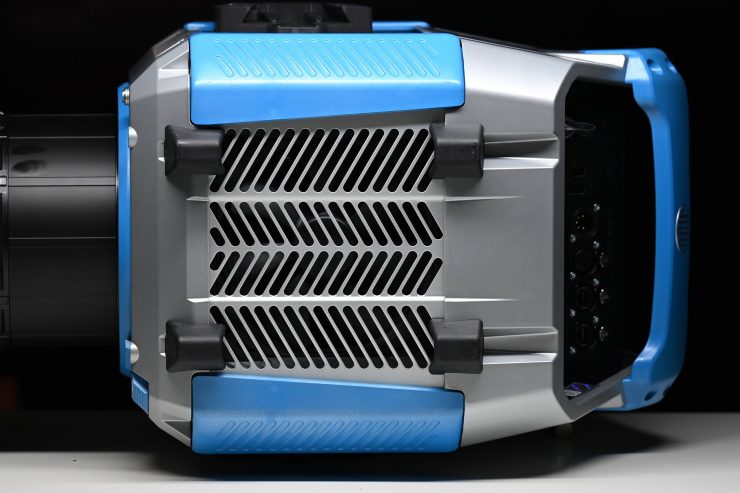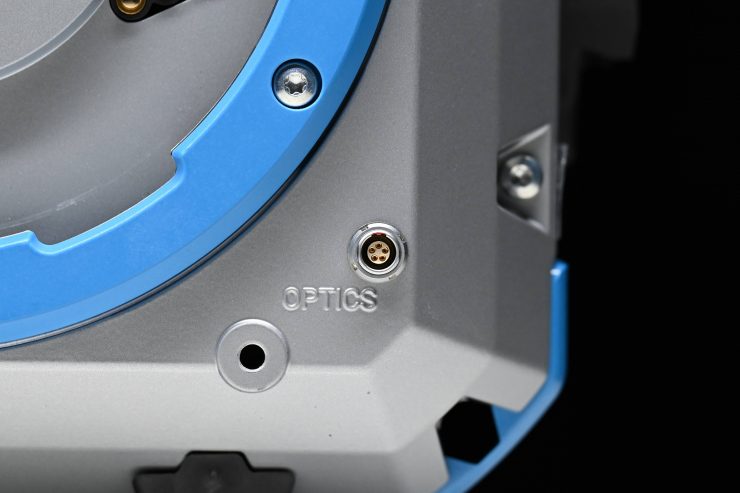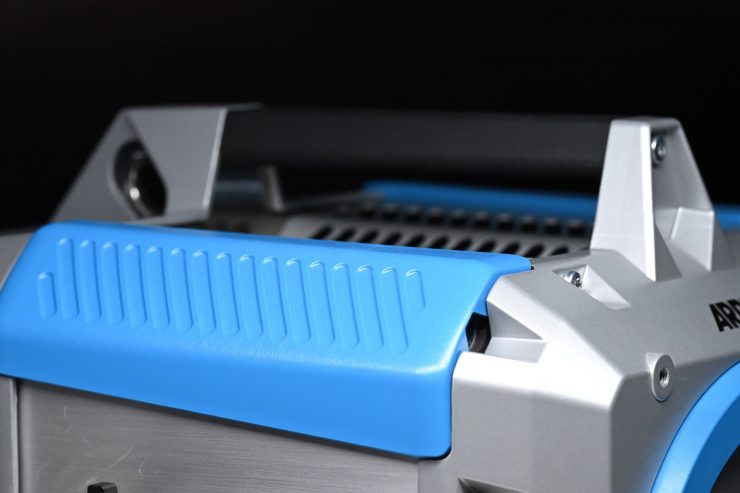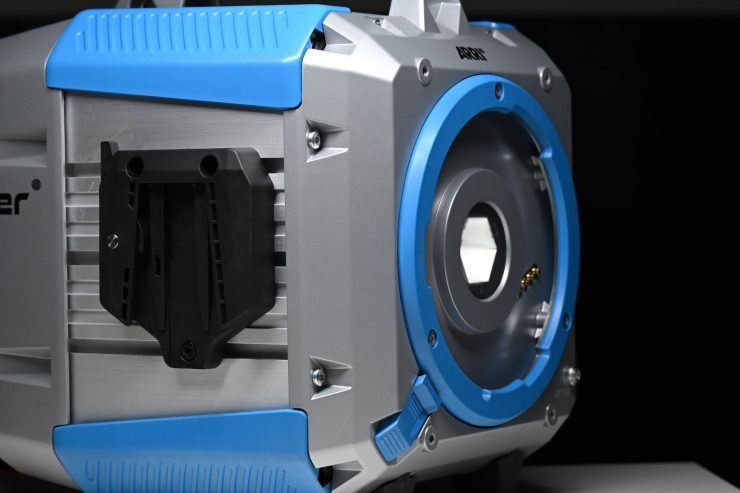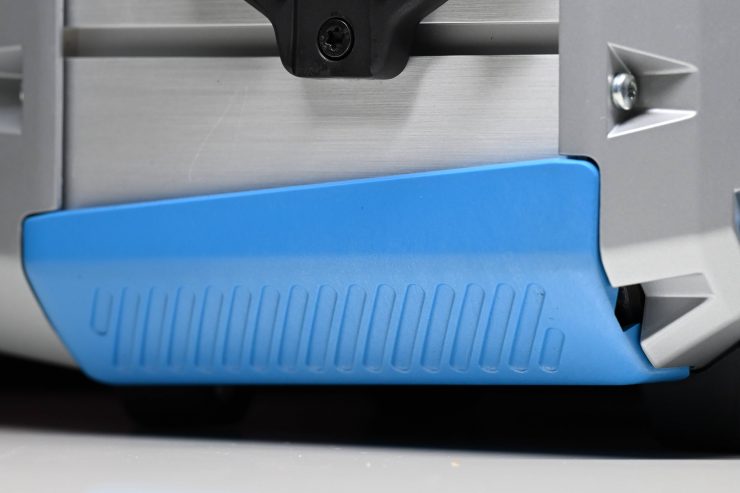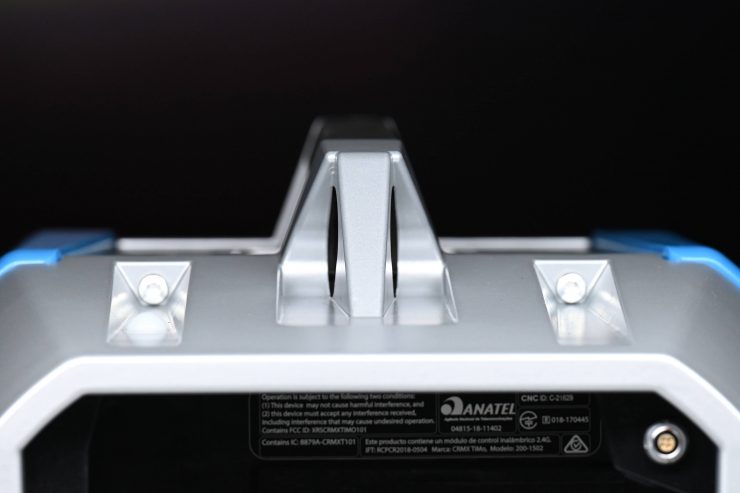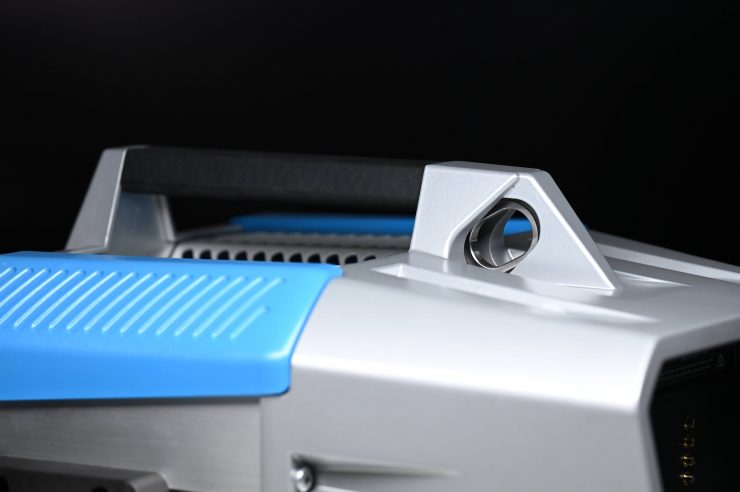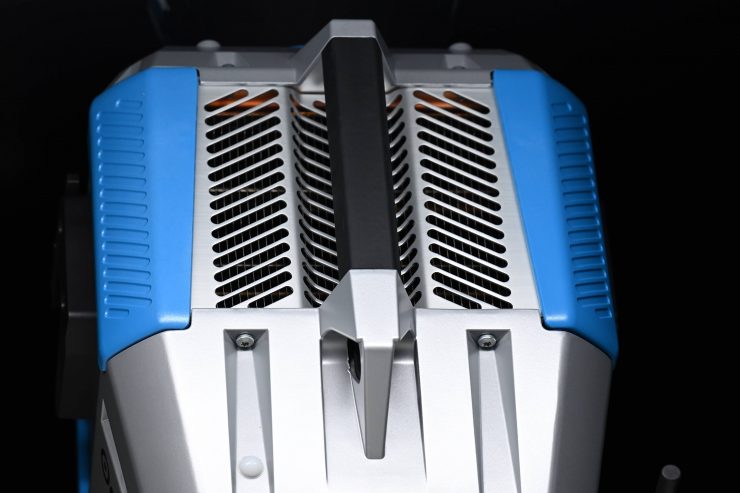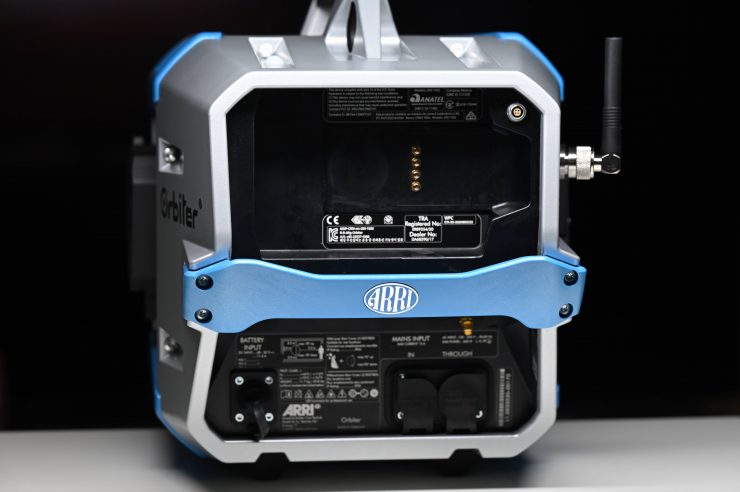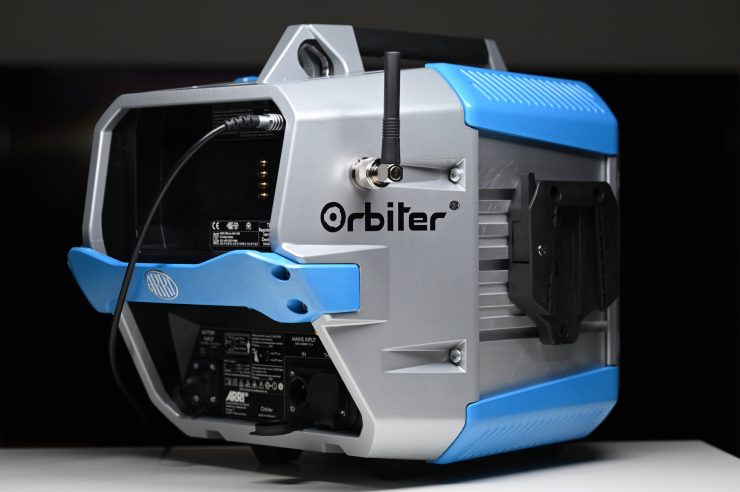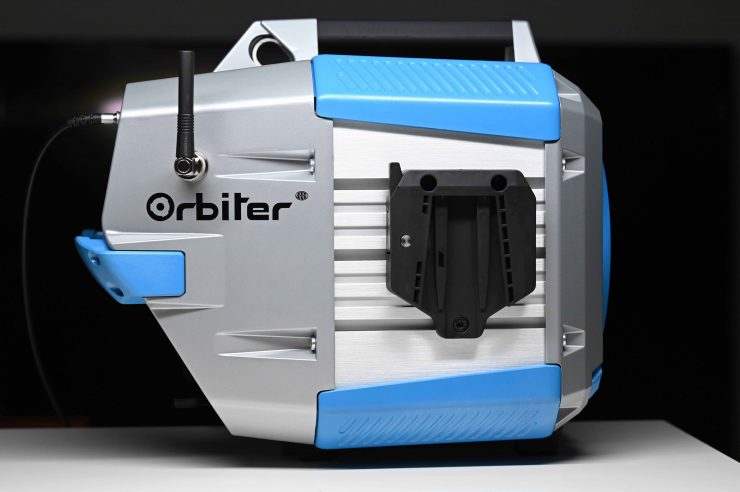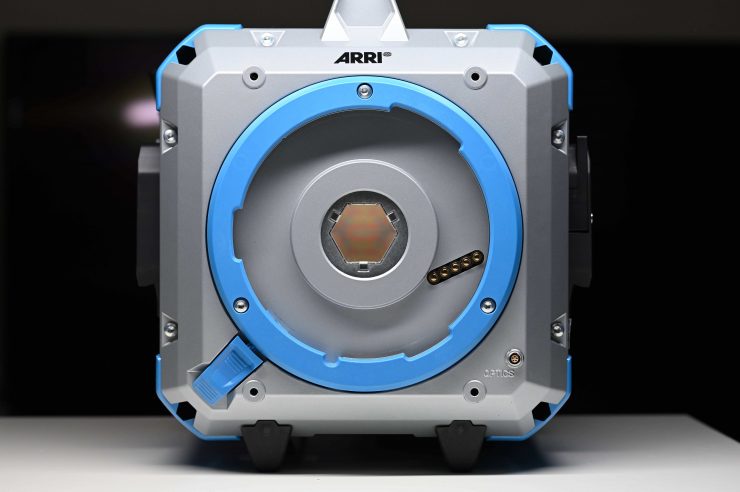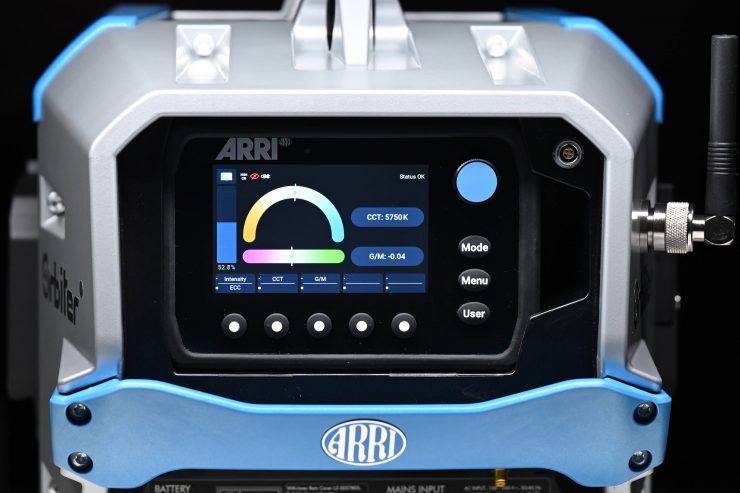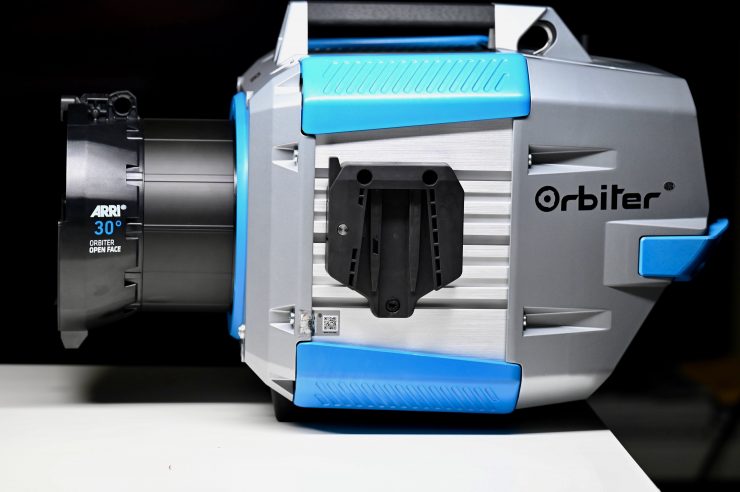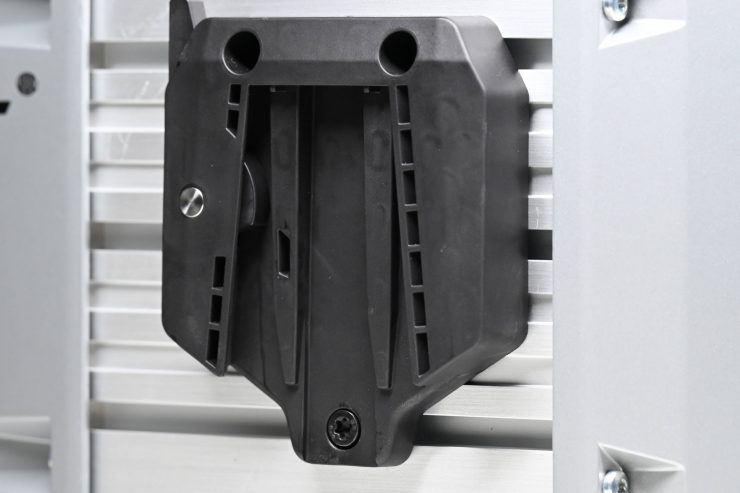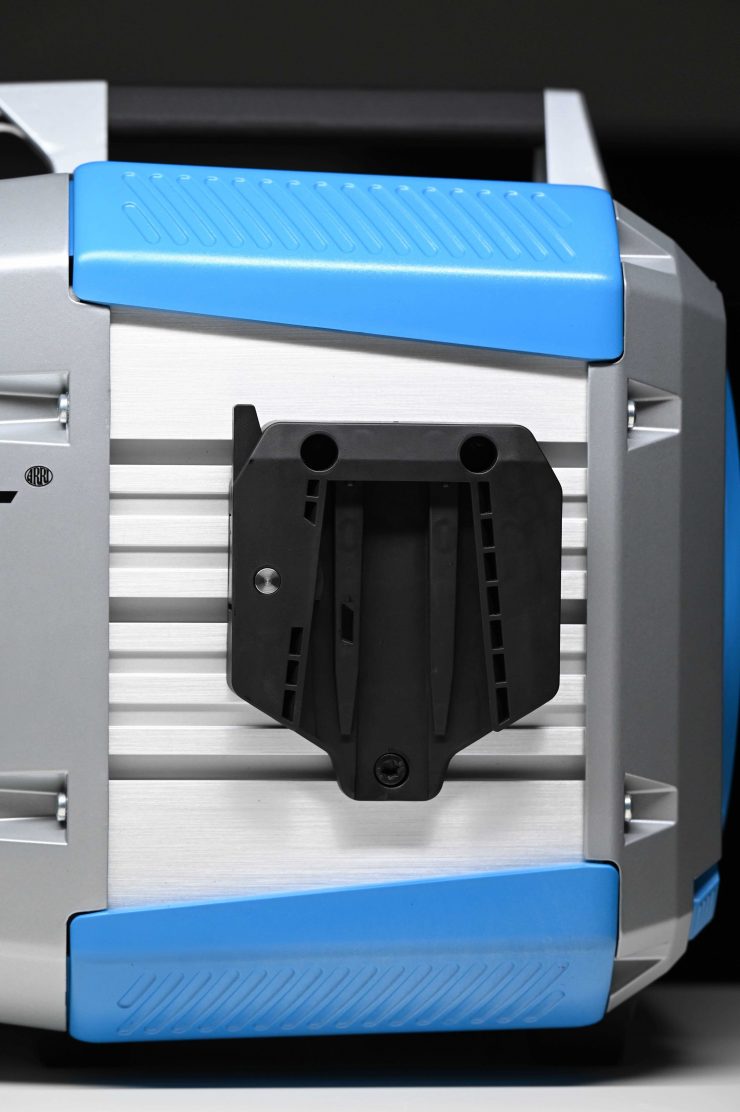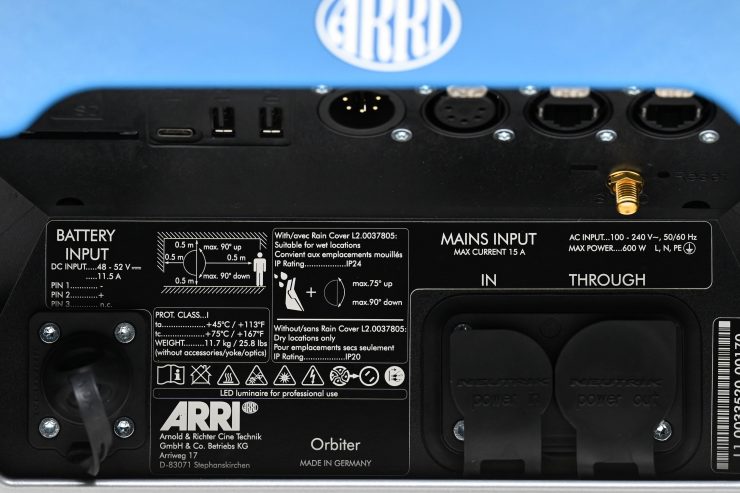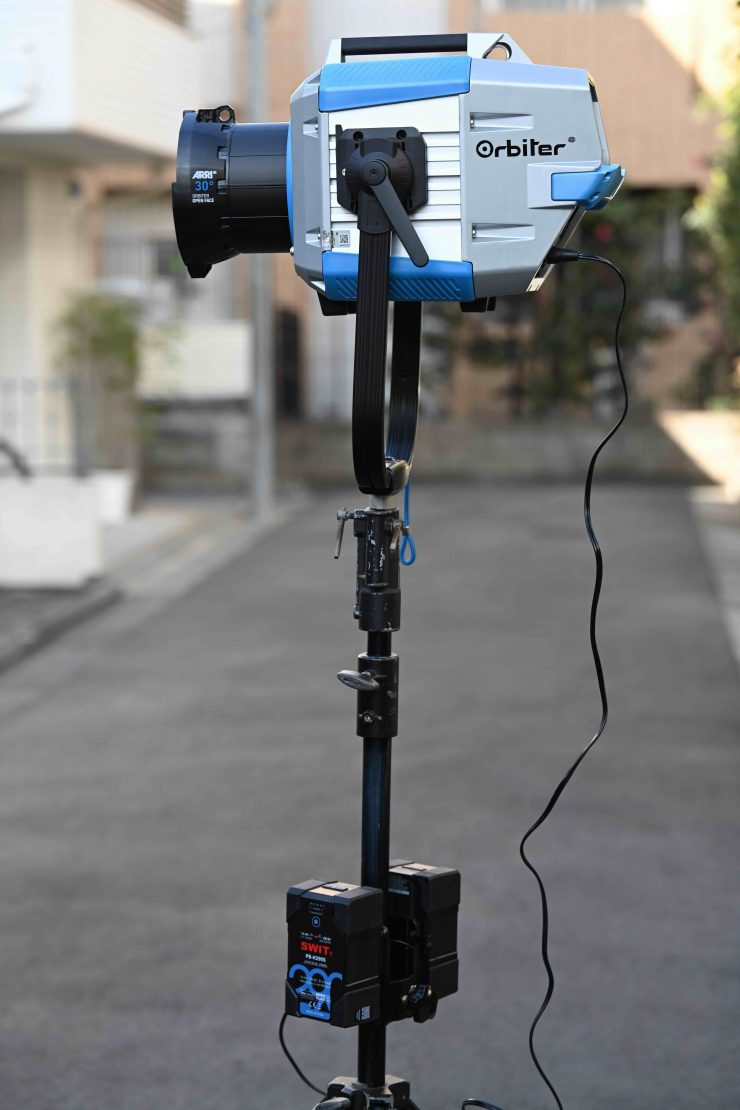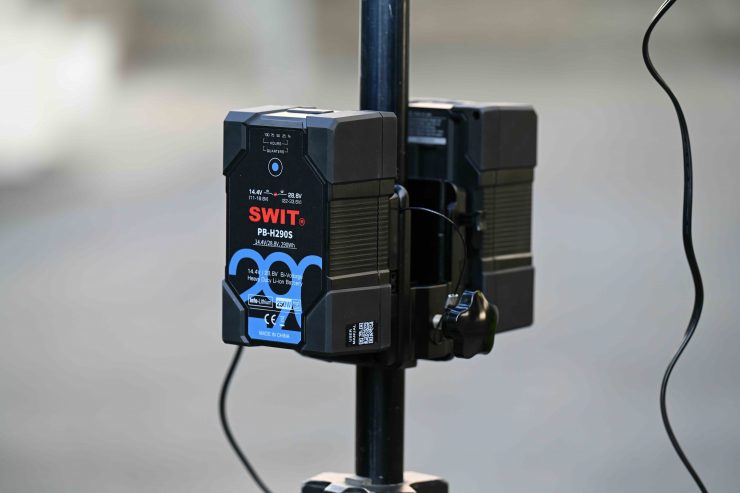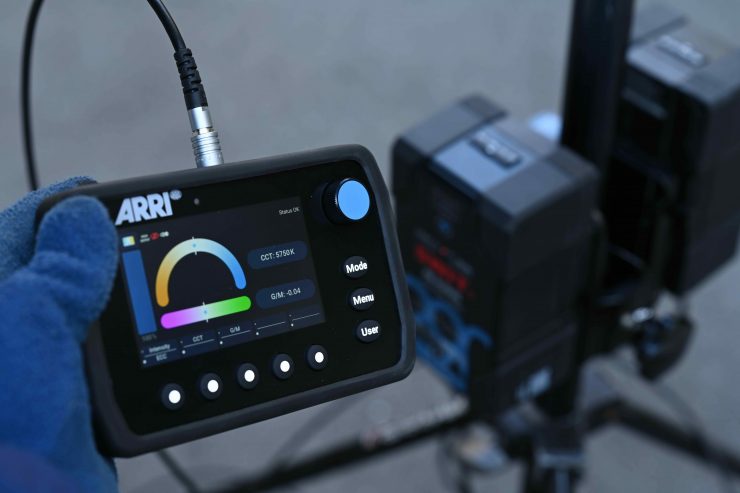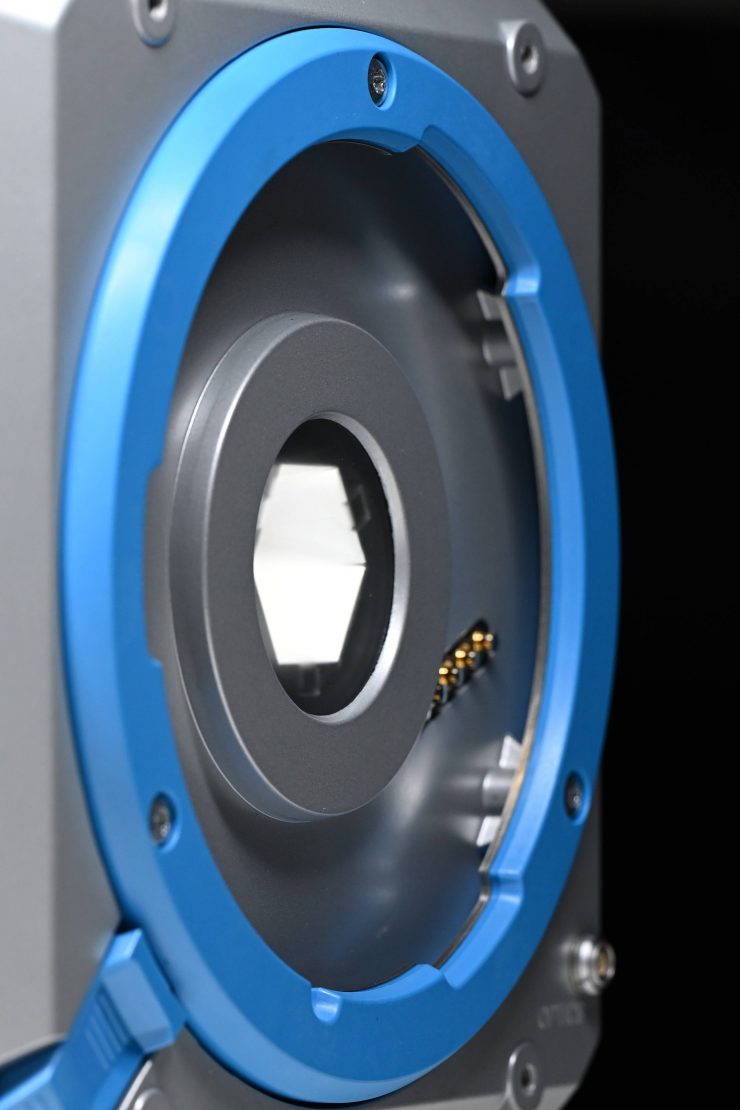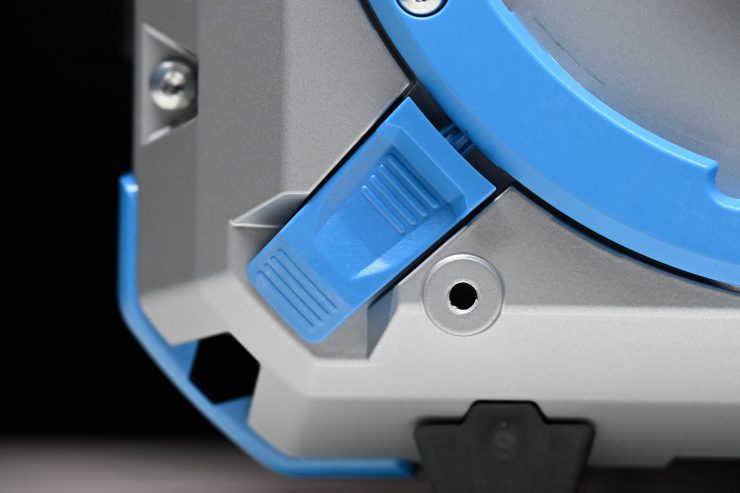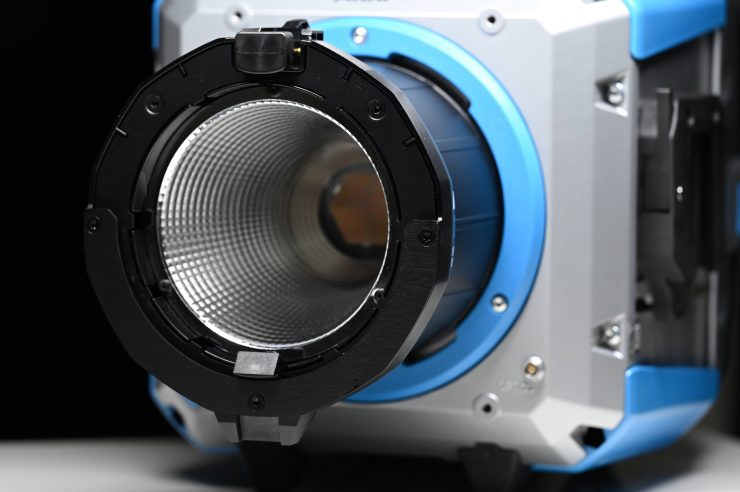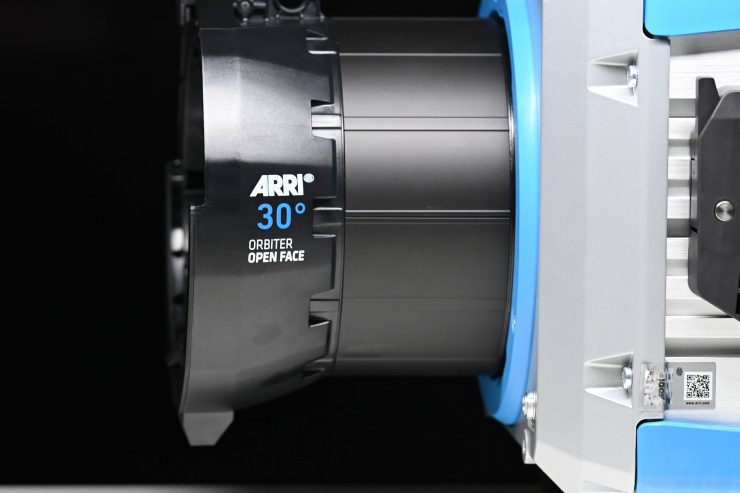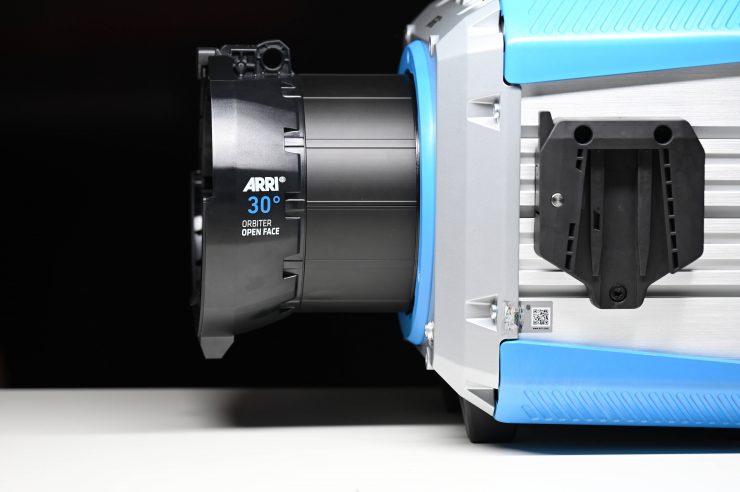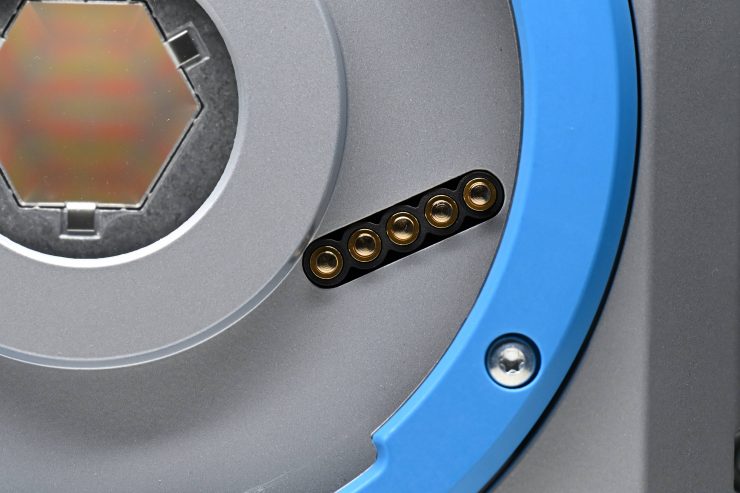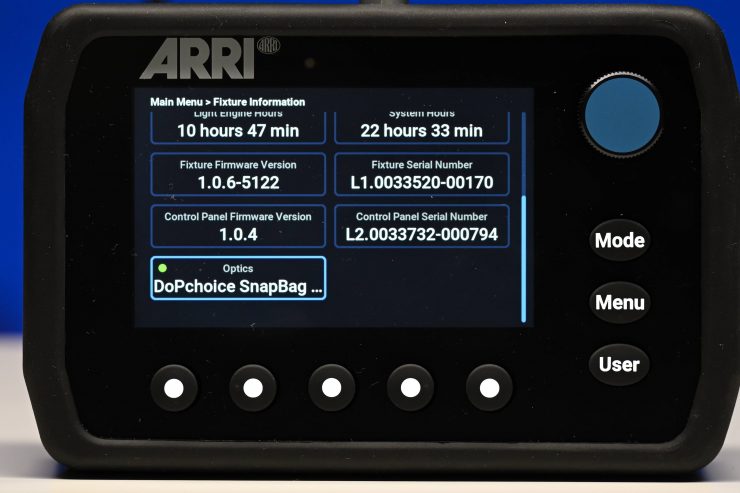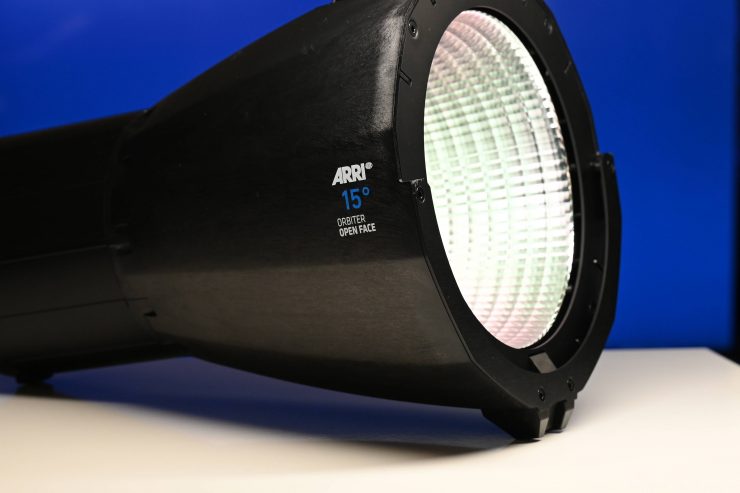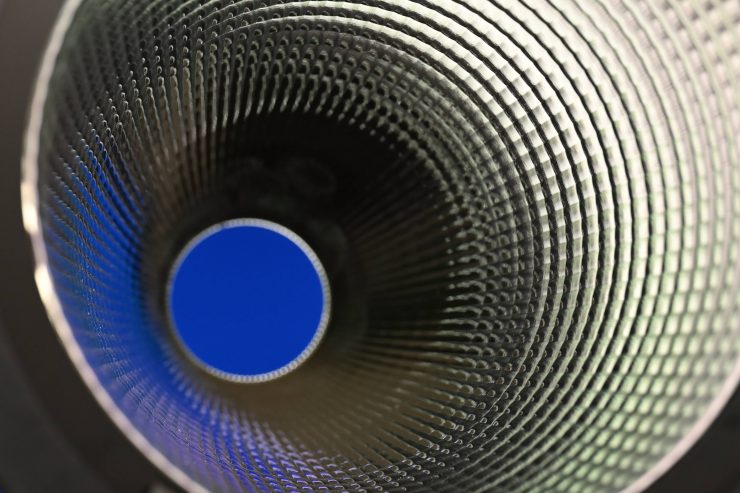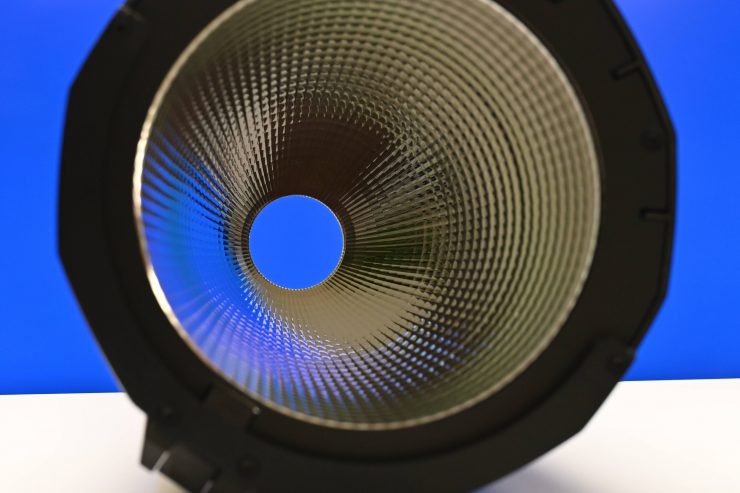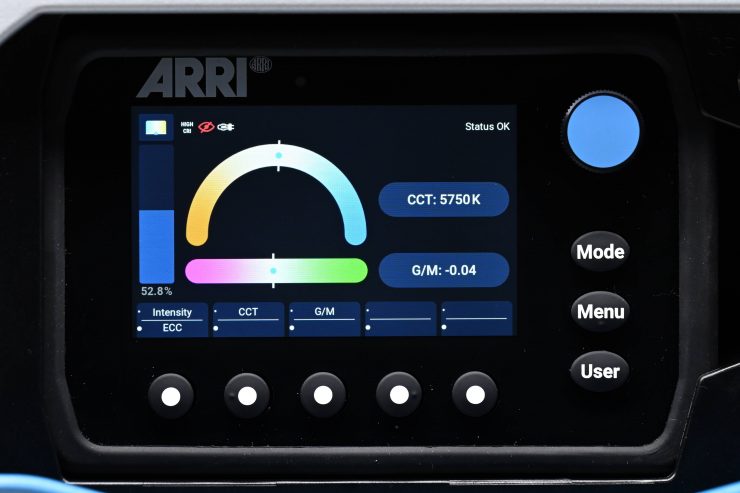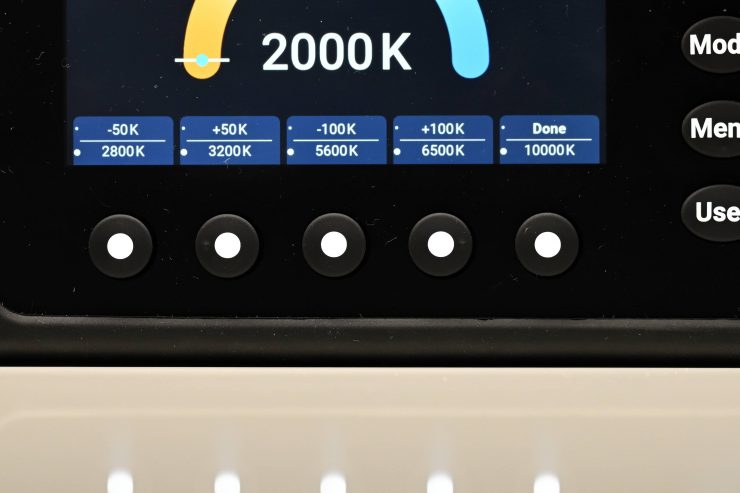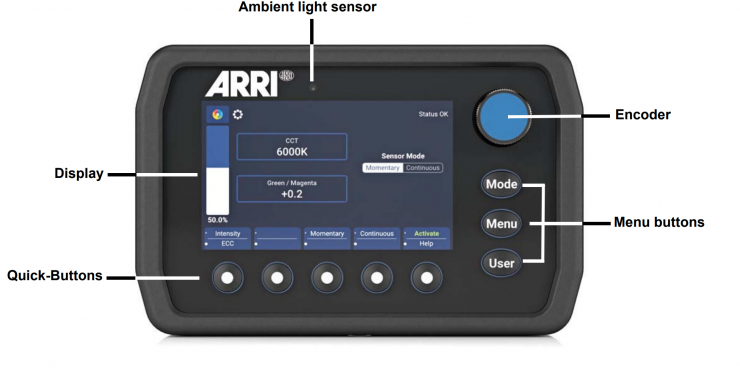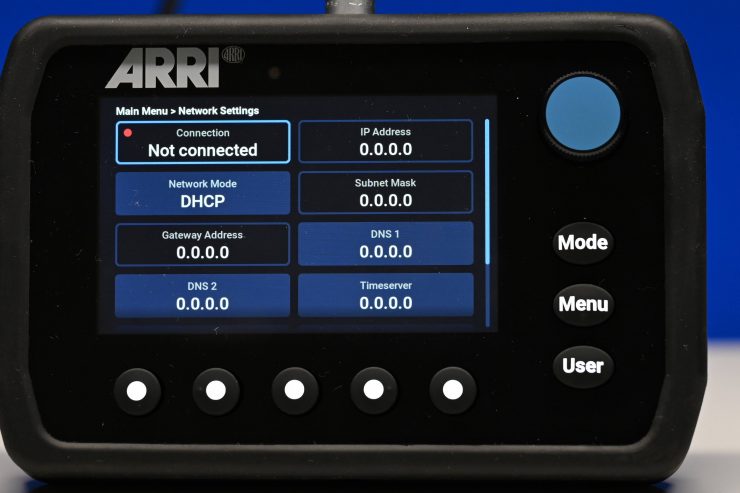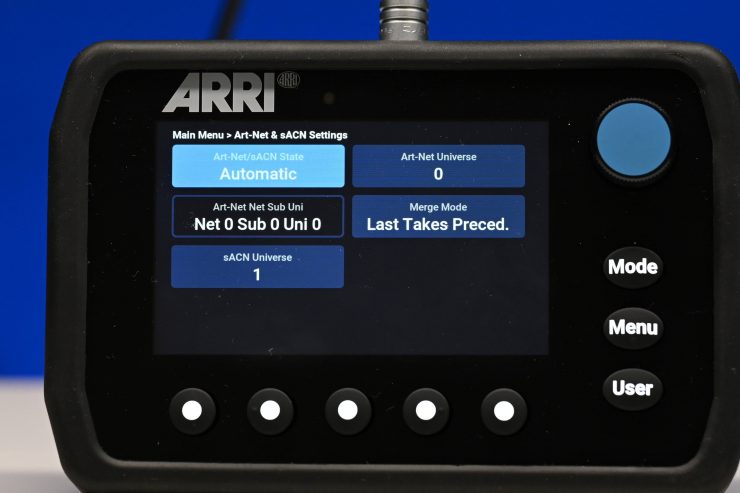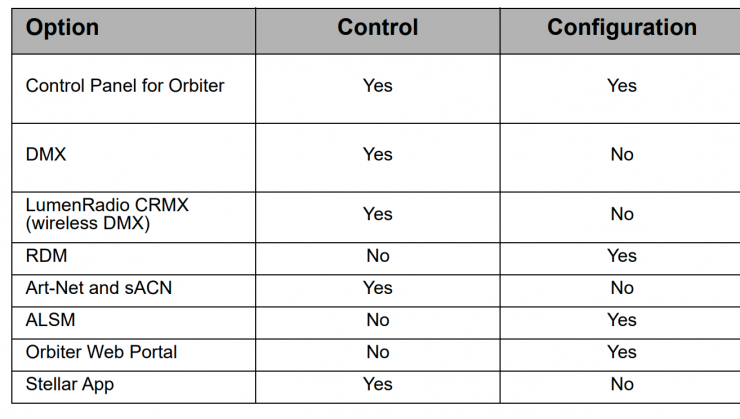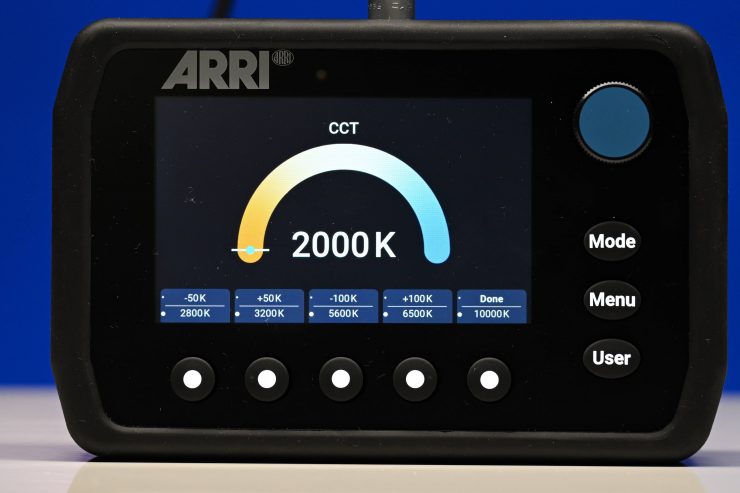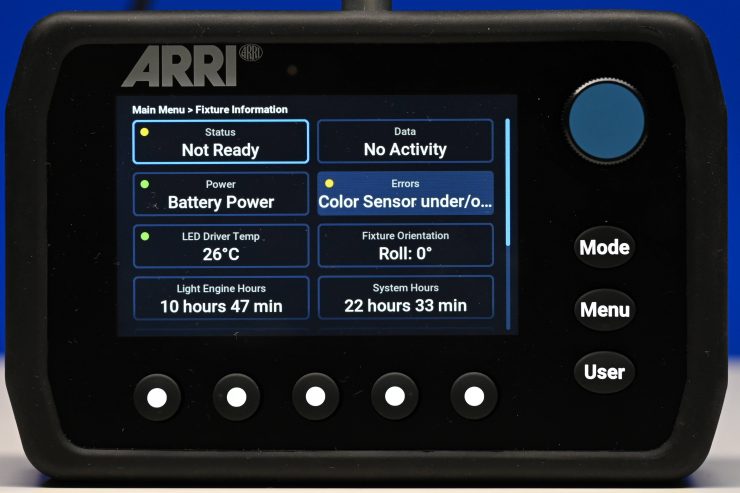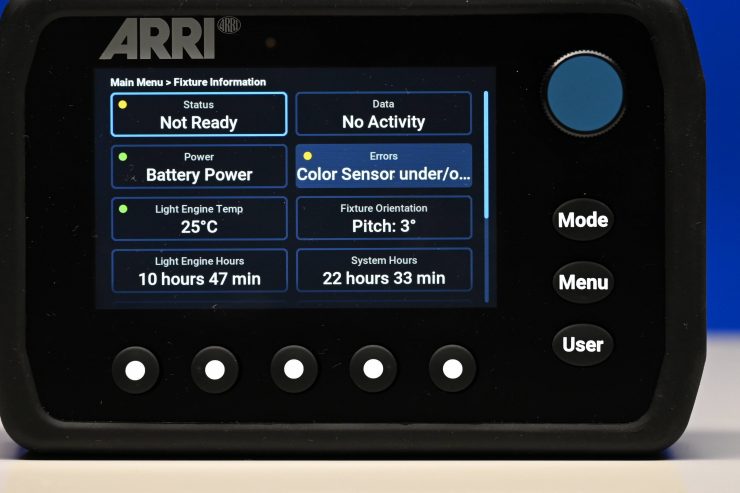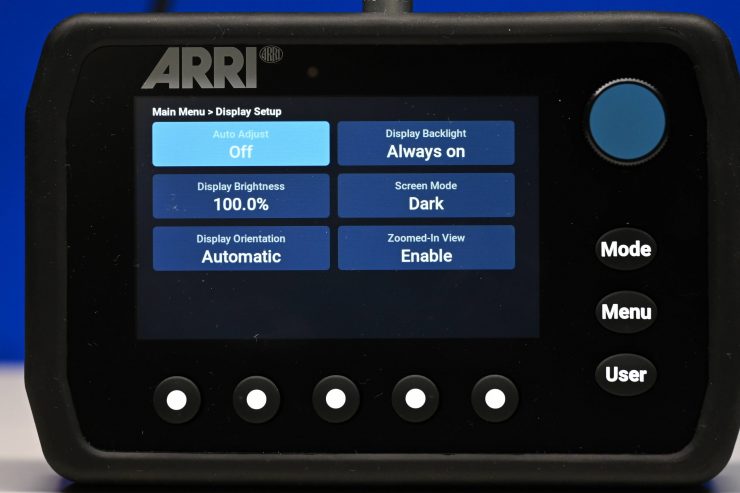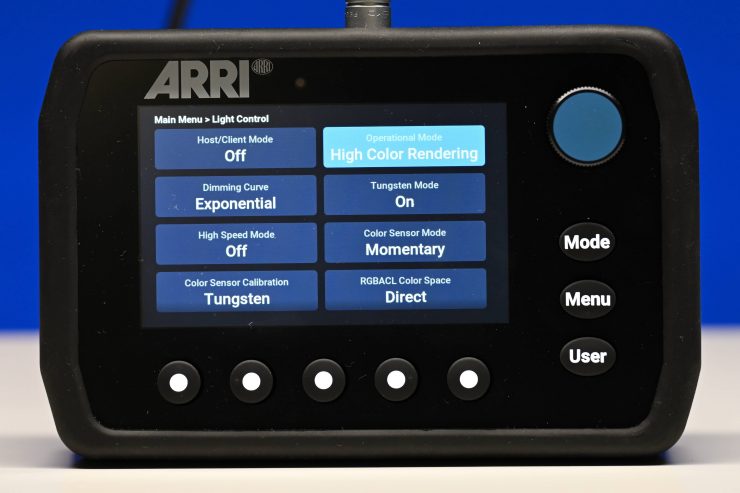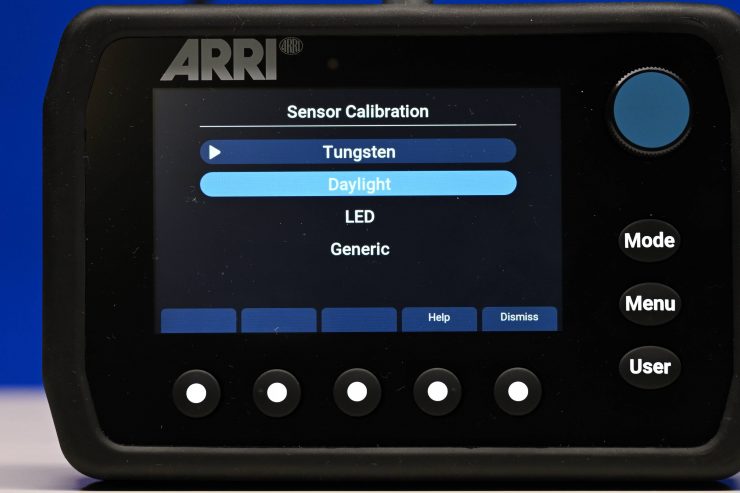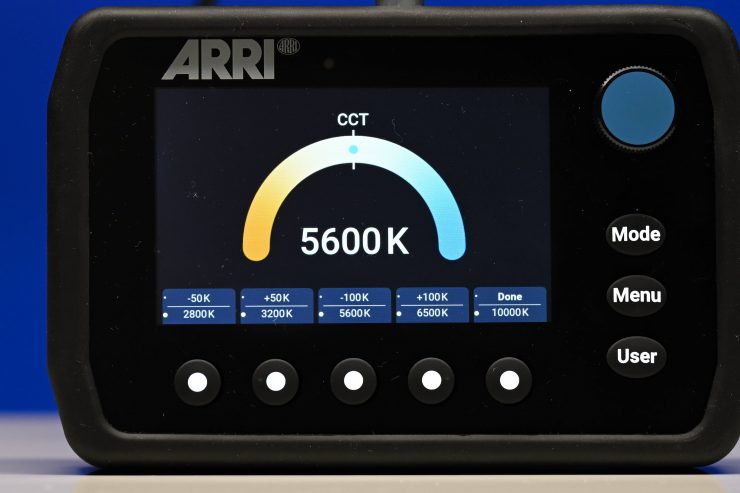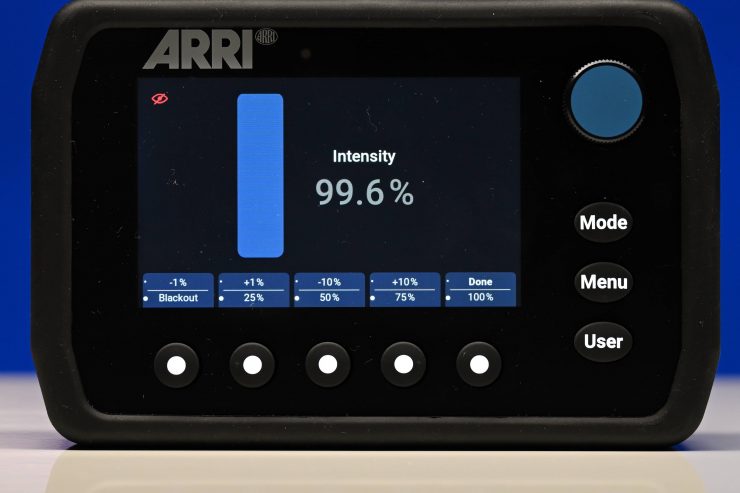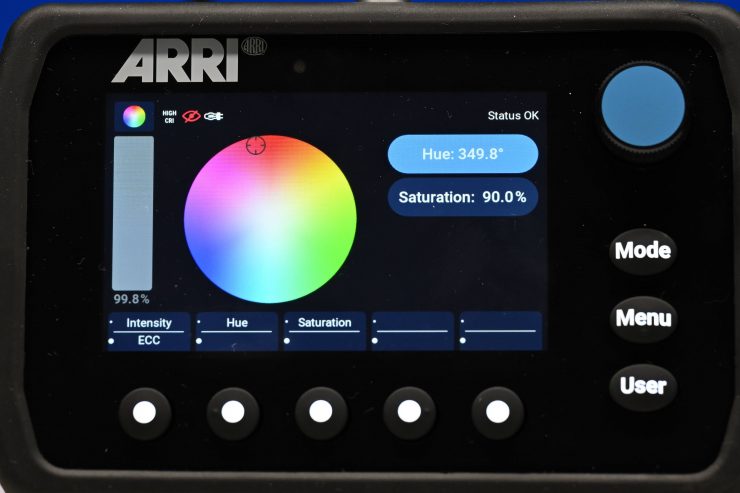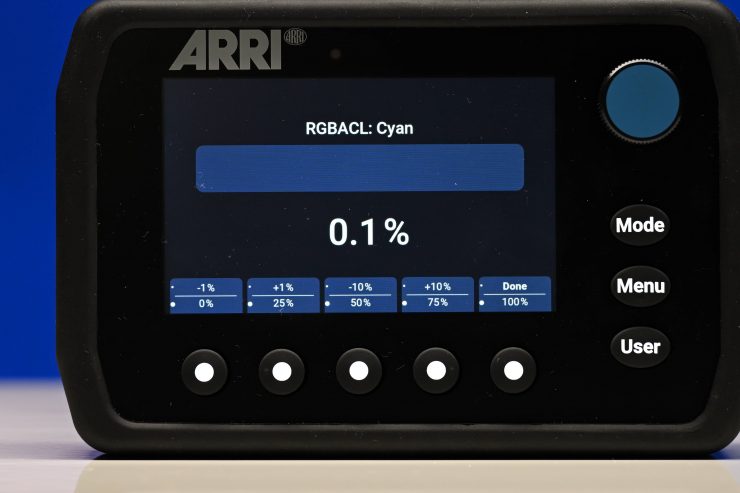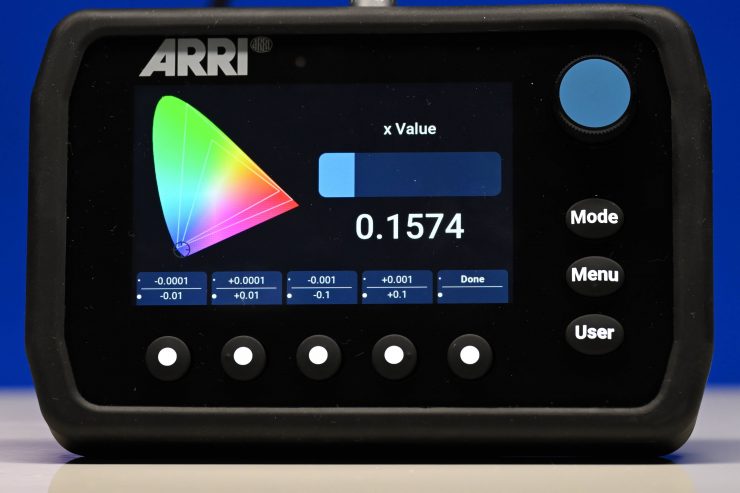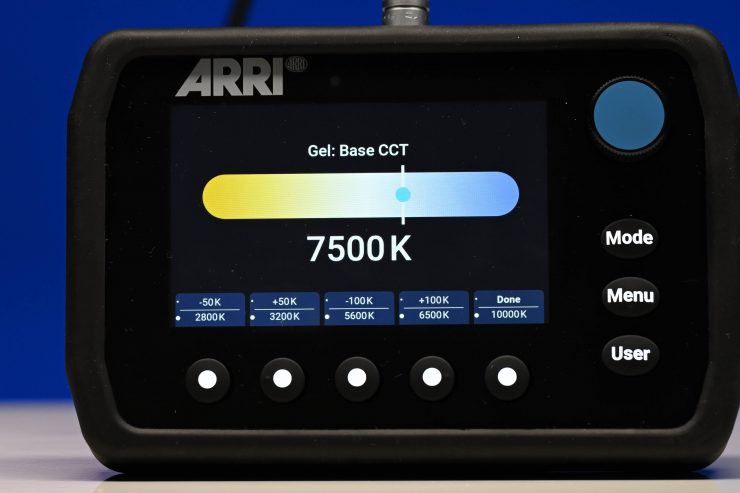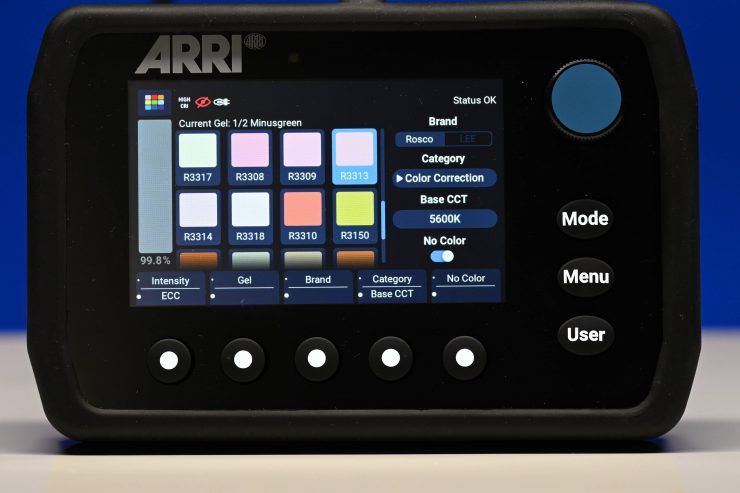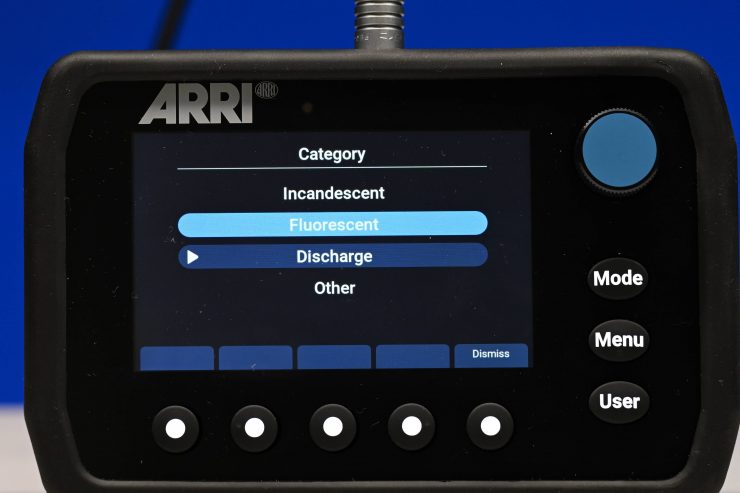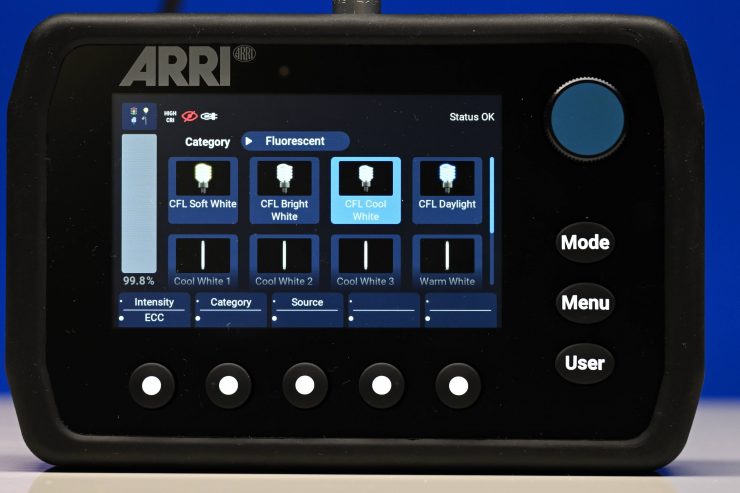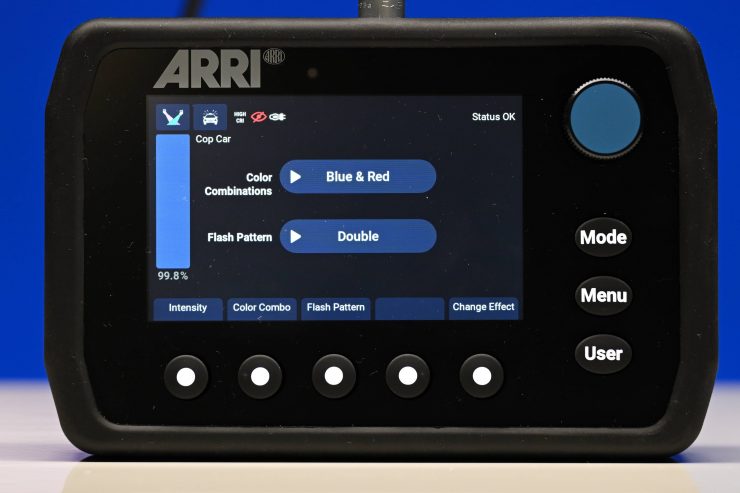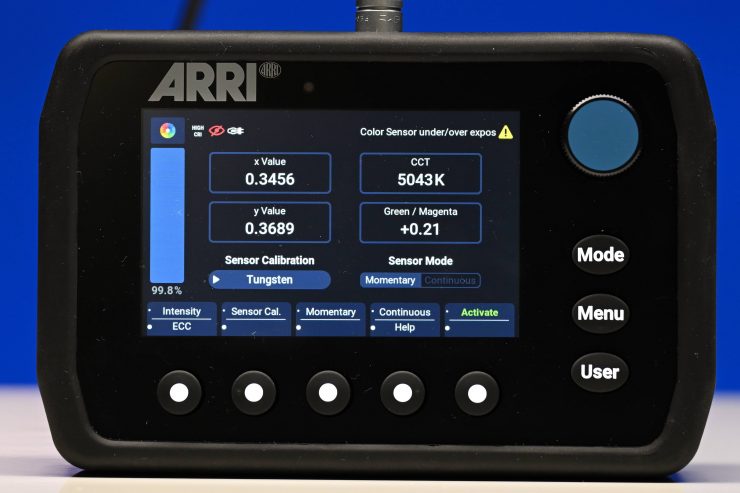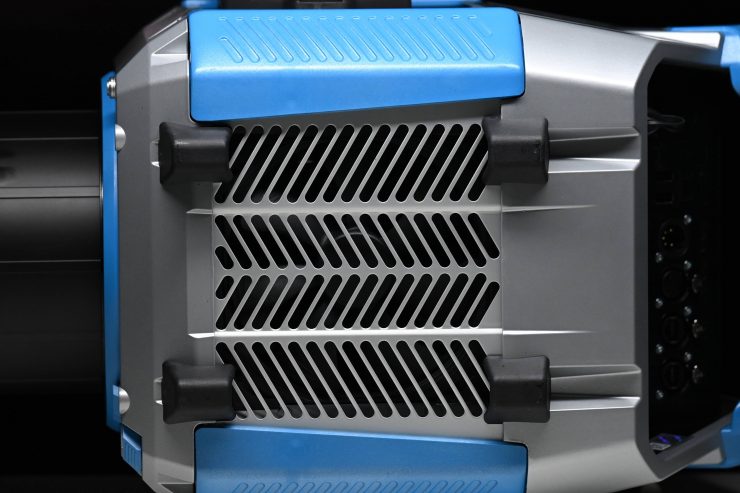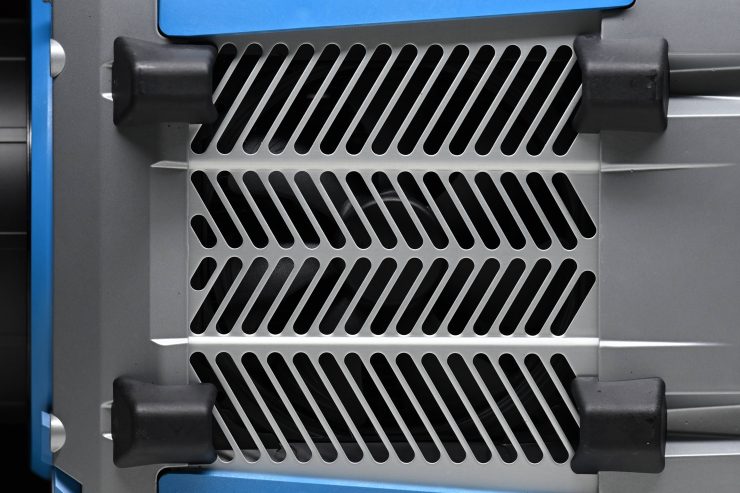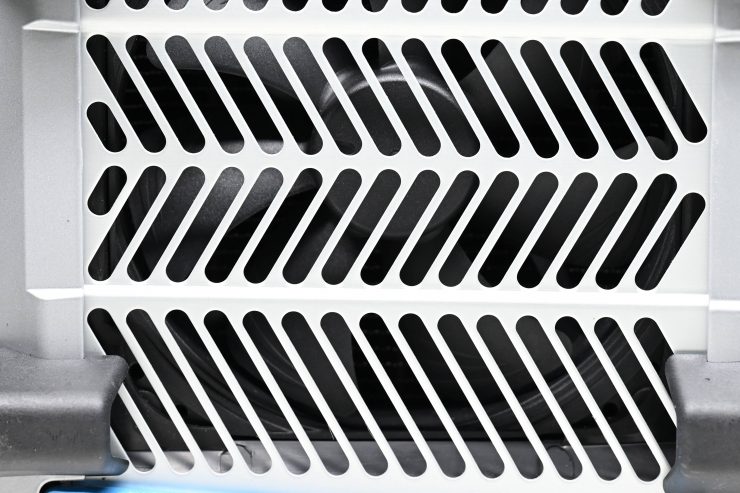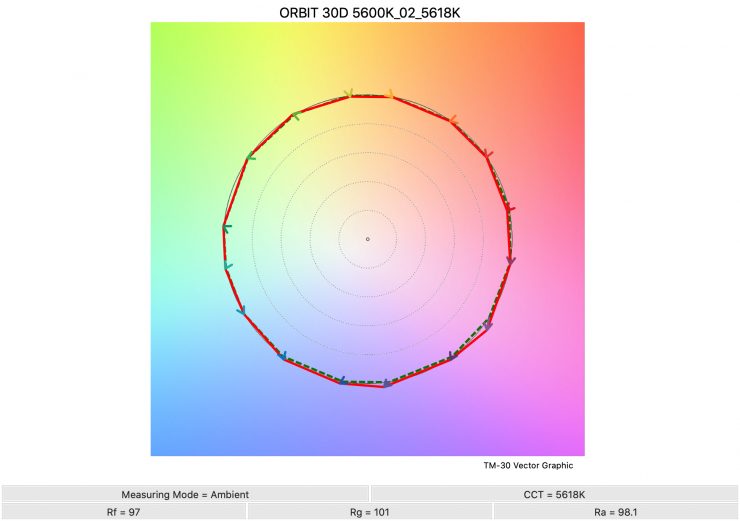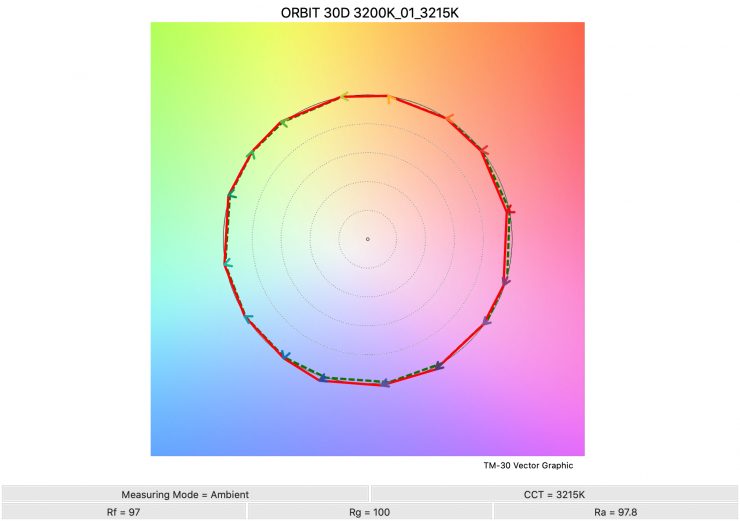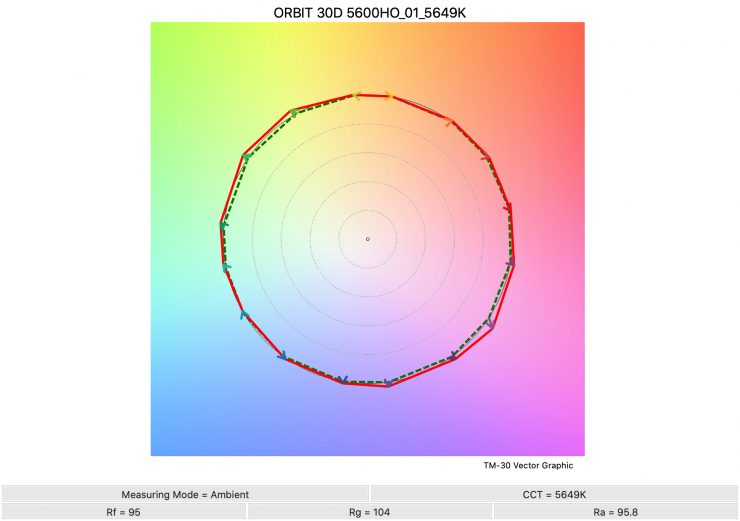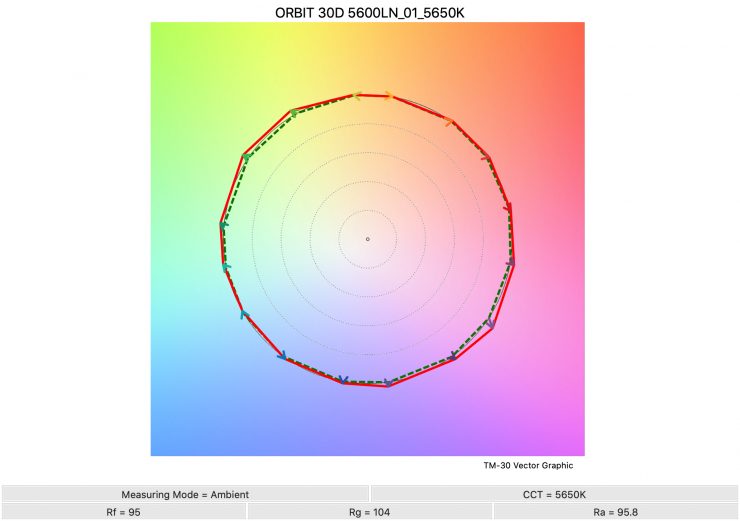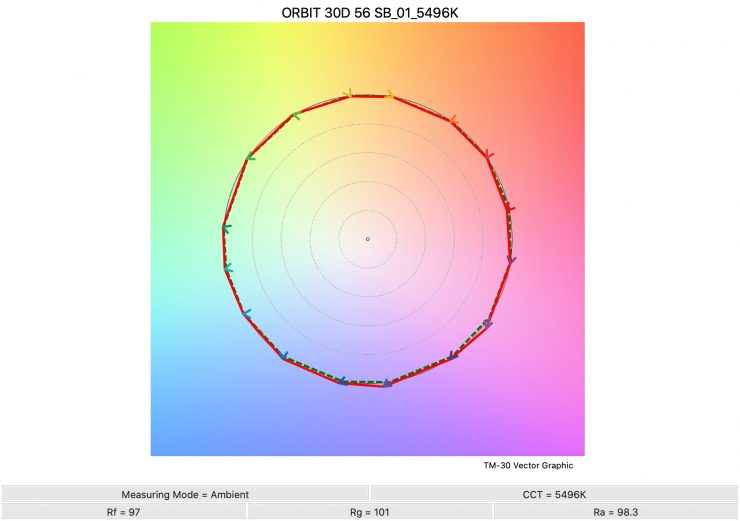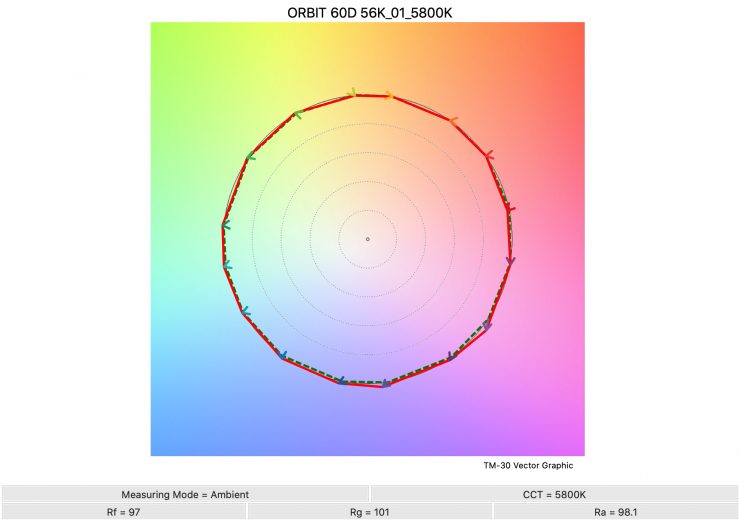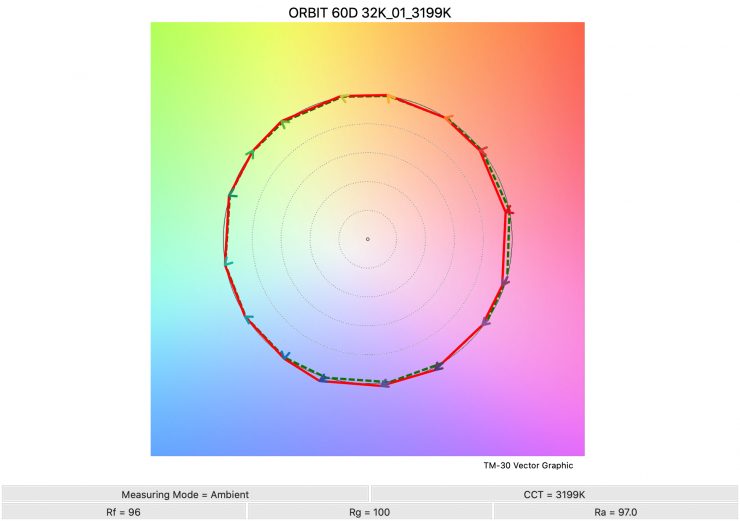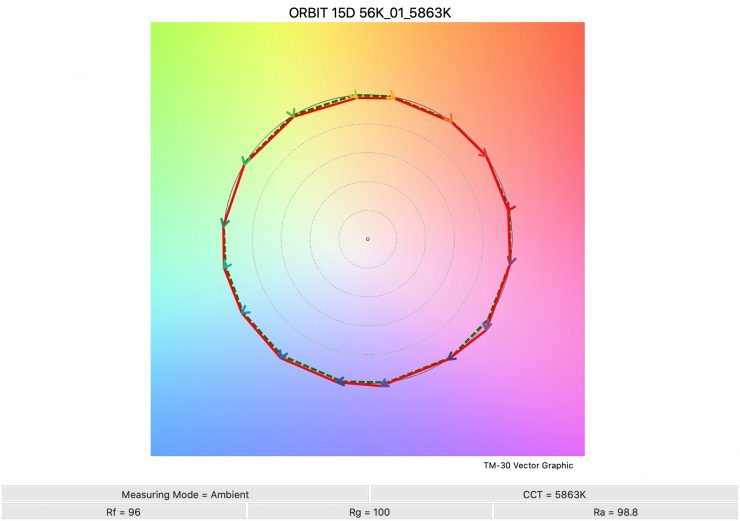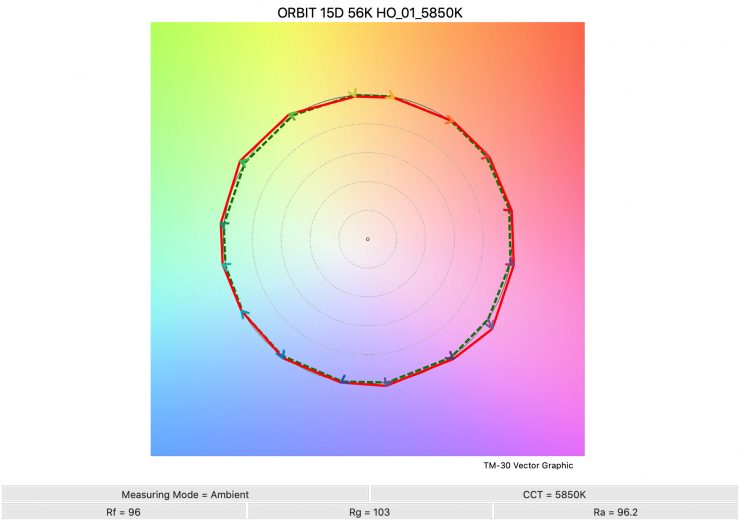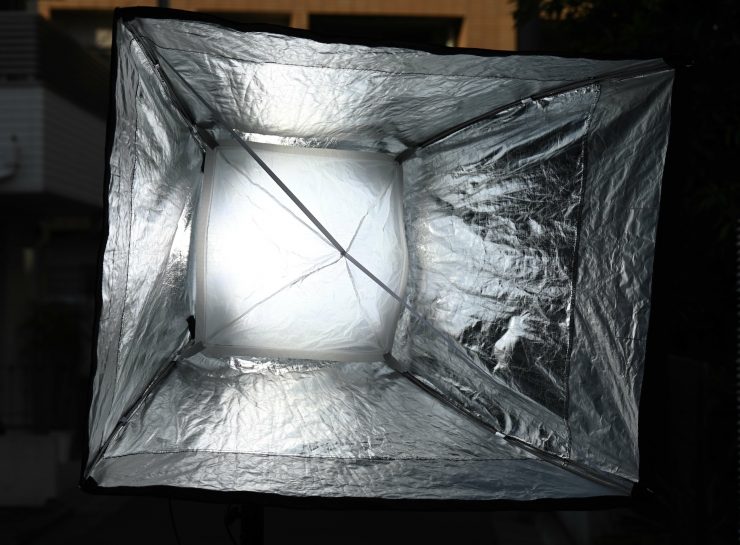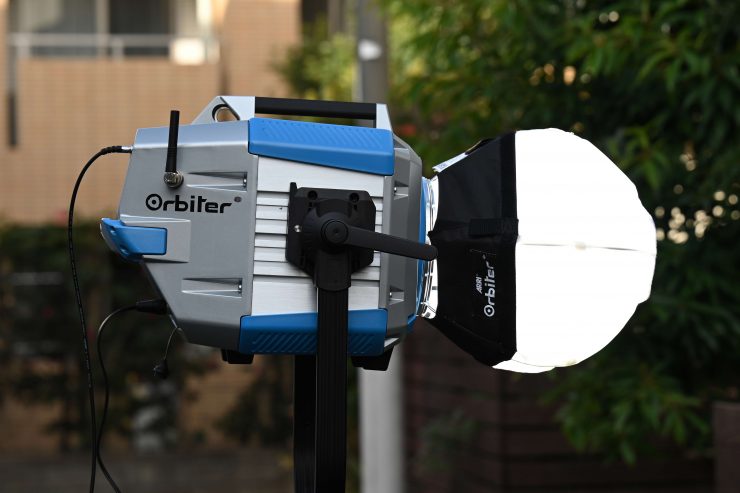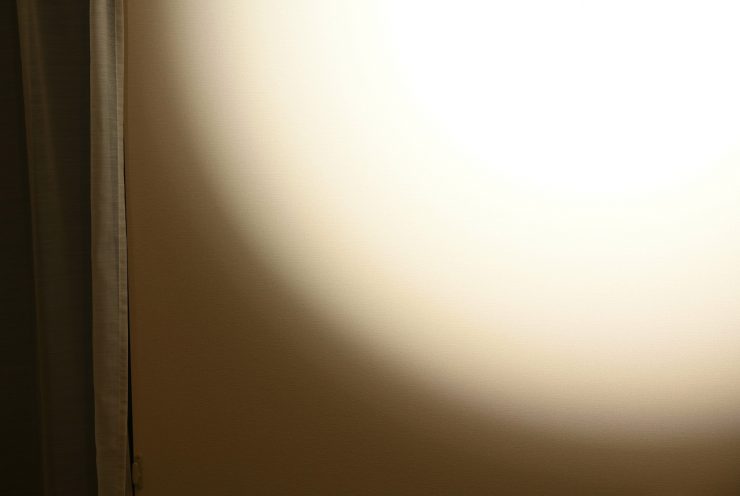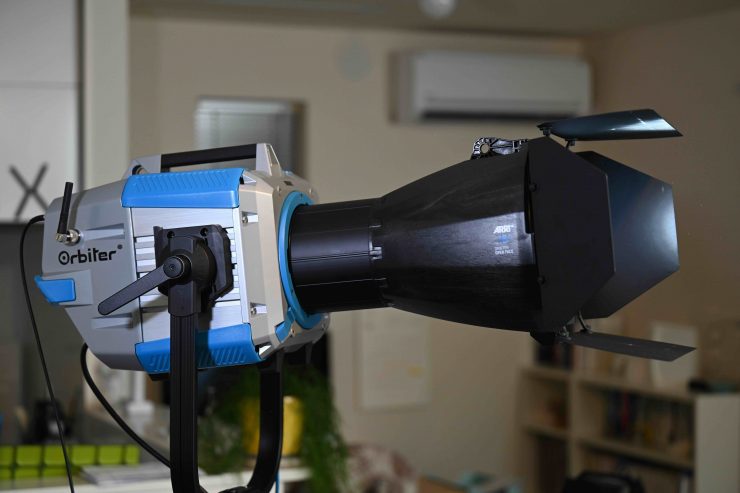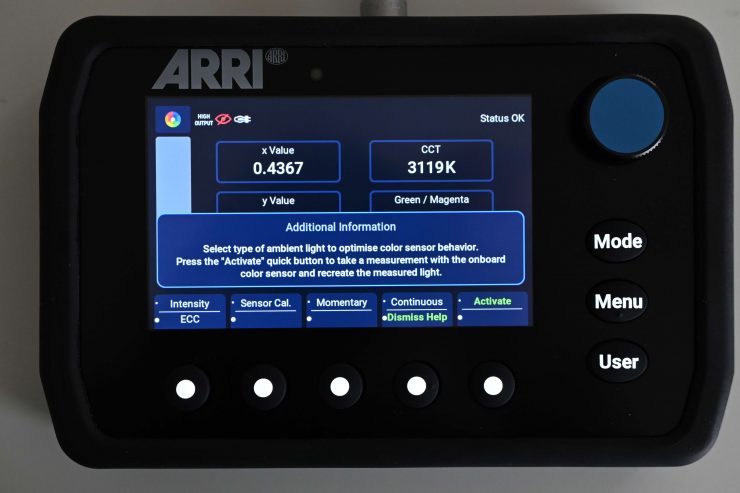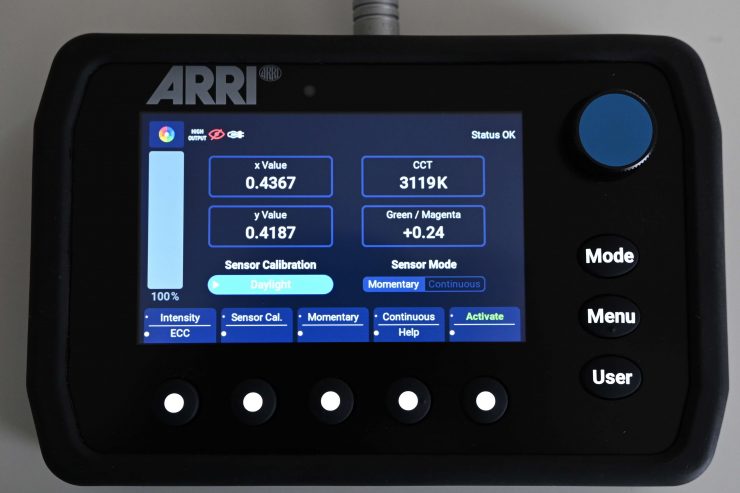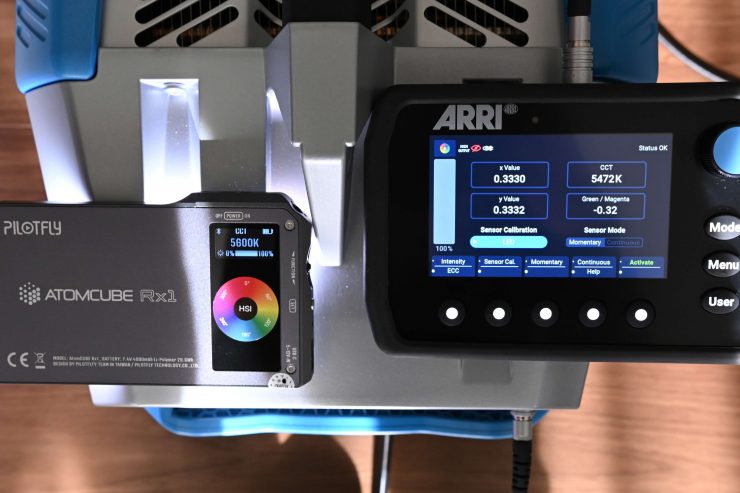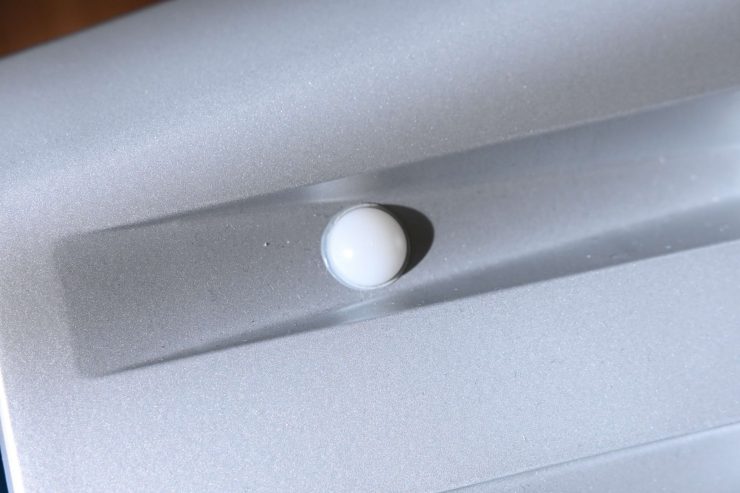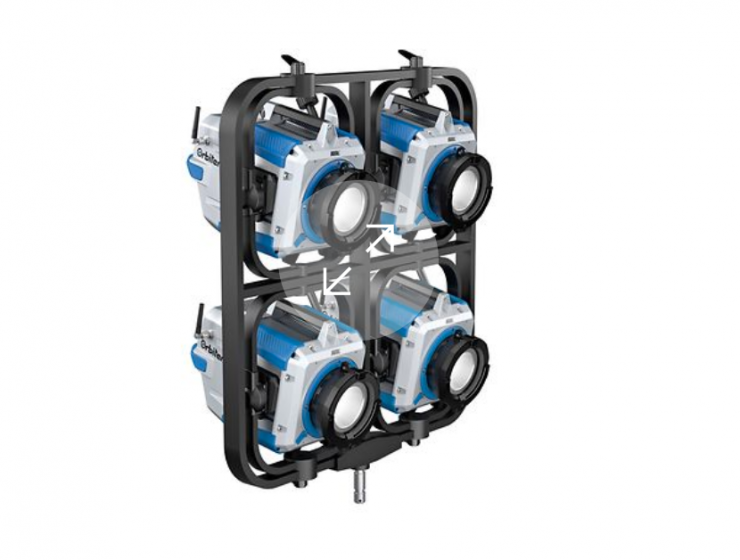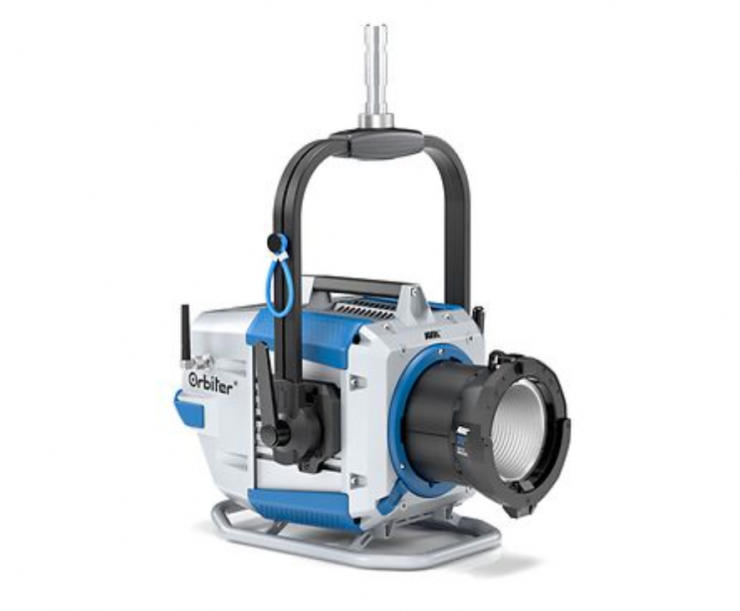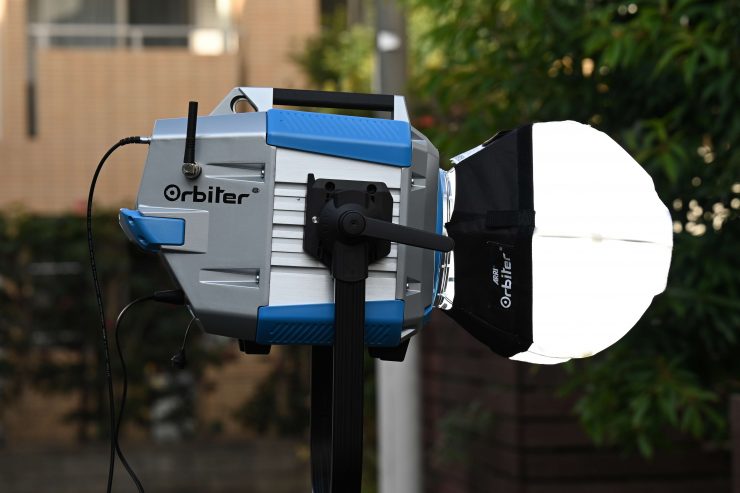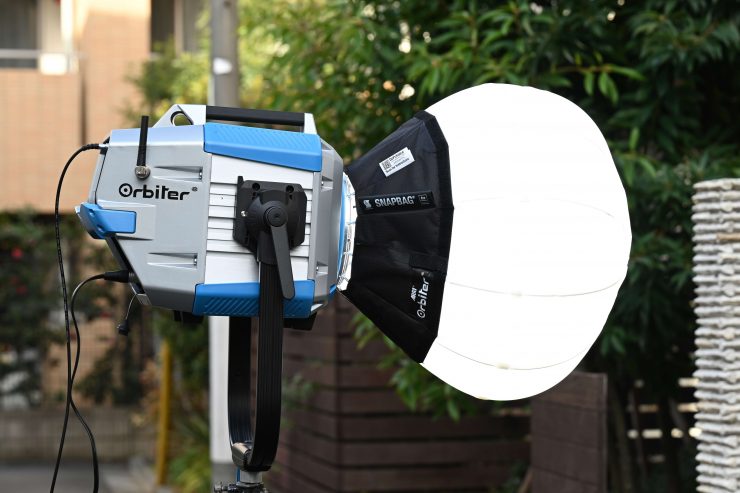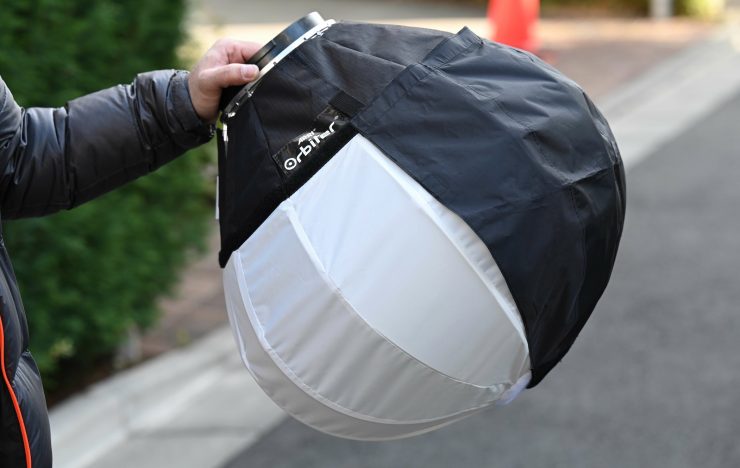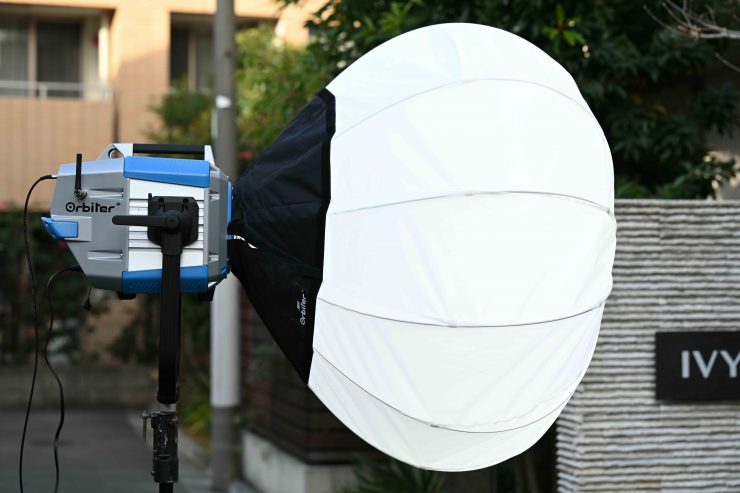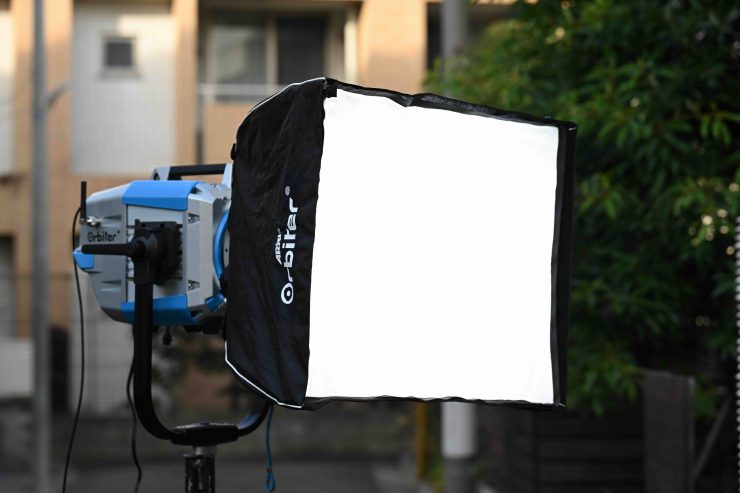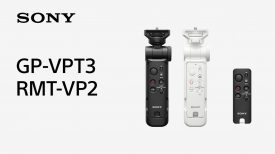
The ARRI Orbiter really caught my eye when I first saw it at IBC 2019. It was one of the lights I was really hoping to get hold of in 2020 to review.
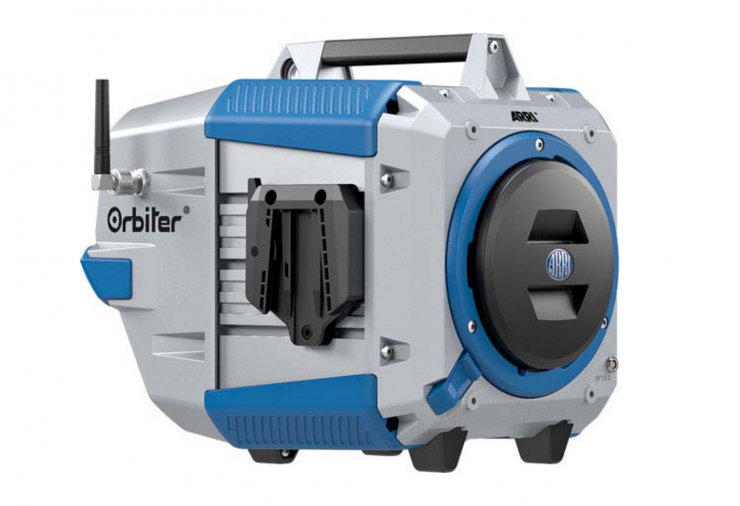
The Orbiter doesn’t look like any lighting fixture we have seen before. Not only does it have a very unique design, but it’s also a bright, tunable, and directional LED fixture. In a lot of ways, the Orbiter could be considered as the Swiss (German) Army Knife of lighting.
At the heart of the Obiter is ARRI’s Spectra six-color wide gamut light engine, as well as the Lighting Operating System (LiOS) with employs powerful software features. There is an integrated color sensor for matching ambient light, a weatherproof housing, and a removable, intuitive control panel. There is also a full suite of connectors and sensors, an internal power supply, wireless DMX, and battery input. The Orbiter is a marriage of both software and hardware.
The Orbiter produces white or colored light with adjustable color temperature and adjustable green-magenta point. According to ARRI, the light spectrum has been optimized for excellent color reproduction and perfect interaction with digital cameras.
Concept
According to ARRI, the concept behind the Orbiter was to utilize state-of-the-art technology and combine it with a versatile design to make it an optimal lamp head that will not only work well today but also well into the future.
The way ARRI has designed the Orbiter is quite smart. As it relies so much on software, the fixture can be continually enhanced and improved through software updates. The multi-versatile nature of the Orbiter also allows you to attach a variety of optics including open face projection, dome, and light banks. ARRI is well aware that people tend to use its products for many, many years, and the key to market adoption is to make something that not only works today but also well into the future.
If you are going to make a big investment in a lighting fixture, you want that lighting fixture to have a long shelf life. This is especially true for rental houses.
Build Quality
The build quality of the Orbiter is very ARRI. In other words, it is very good. ARRI fixtures are extremely popular in rental houses across the globe, and some of the primary reasons for that are long term reliability and durability.
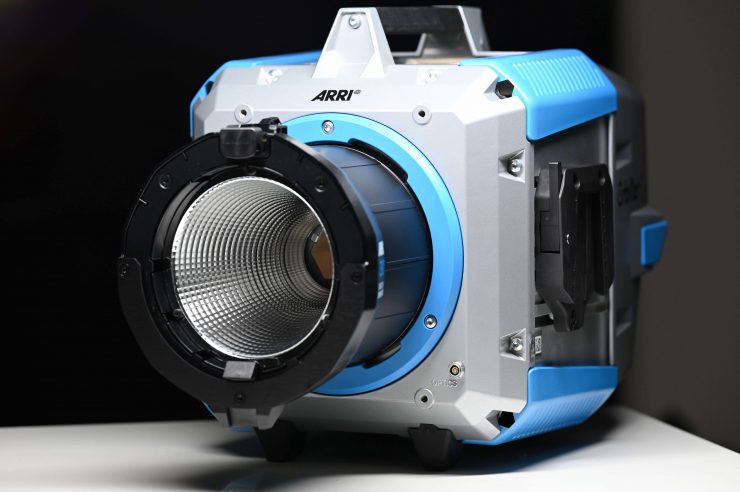
The nice aspect of the Orbiter is that it is a self-contained unit. There is no separate controller or power supply that you have to tangle with. This has its pros and its cons. Having a self-contained unit makes it quicker to set up, but on the flip side, you do need to use larger lighting stands that can correctly support its weight.
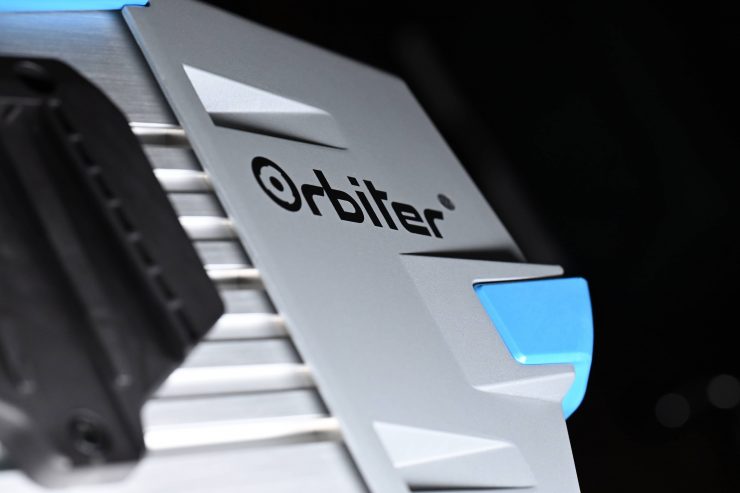
The outer design of Orbiter features a weatherproof housing. It is constructed out of an aluminum cast body and the bumpers are made of reinforced plastic. The handle makes transporting and lifting the fixture pretty easy.
The Orbiter comes with a 3-year extended warranty for electronics, a 5-year warranty on service parts, and up to 10-years on mechanical parts.
Design
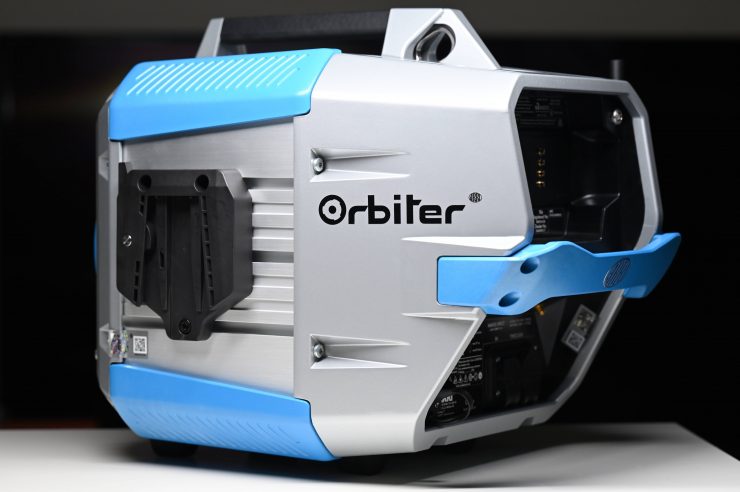
As far as the design goes, the Orbiter looks like an ALEXA Mini and a SkyPanel had a baby! A lot of lighting fixtures we see these days tend to look quite similar and there hasn’t really been a lot of innovation on that front. The Orbiter looks completely different from anything we have seen before.
There are and will be a wide variety of optics to choose from. The idea behind the changeable optics is so that Orbiter can transform into a variety of different lights without sacrificing beam, output, or color quality. The Quick Lighting Mount (QLM) used on Orbiter allows for optics with vastly different properties to be attached to the fixture.
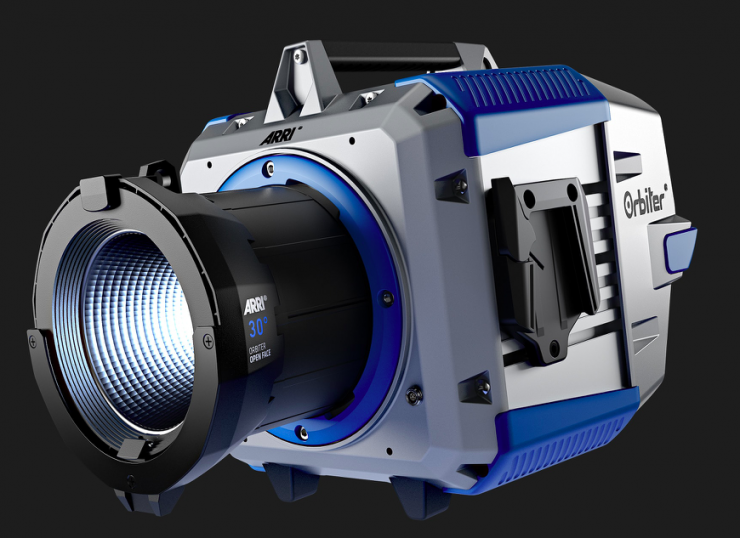
The high-output, directional beam of the open face optic can be used for throwing light long distances. The high precision of the projection optics means that Obiter can create a perfect circle of light that can be shaped with cutters, focus, and gobos. The dome optic provides omnidirectional, soft light, which is nice for lighting up large spaces. The universal QLM adapter creates a direct mounting point for Orbiter-specific Chimera and DoPchoice products.
Gone are the days where a light was just a light. If you look at the classic ARRI 650, it is a pretty basic feature, however, a lot of today’s modern lights are now a seamless blend of hardware and software. This is especially true with the Orbiter. It is a marriage of both software and hardware. This is something we are going to be seeing a lot more of going forward. The key to longevity is to make a product that can be updated over time. Lighting technology is improving at a rapid rate and nobody wants to buy a fixture that will be obsolete in a few years.
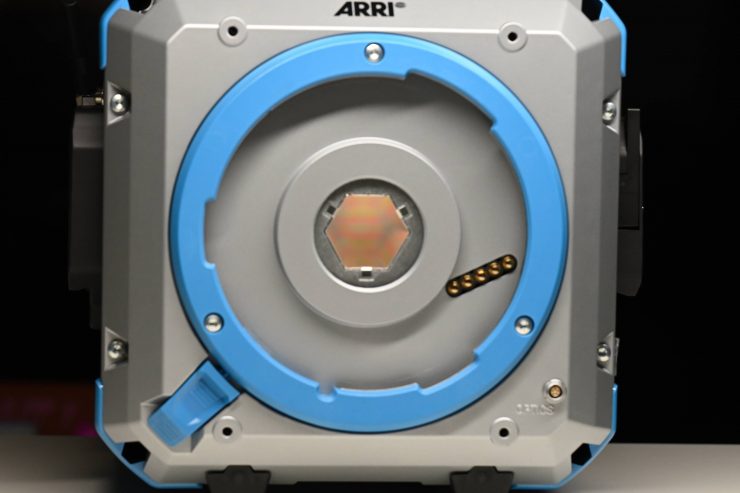
Quite a few LED lights on the market, including the Orbiter, are using COB technology. COB stands for “Chip On Board” where multiple LED chips are packaged together as one lighting module. The advantage of COB LEDs being multi-chip packaged is that the light-emitting area of a COB LED can contain many times more light sources in the same area that standard LEDs could occupy. This results in a greatly increased lumen output per square inch.
According to ARRI, the Orbiter is a directional LED fixture with an output similar to that of corresponding HMI systems. Please note that ARRI is saying similar output, not equivalent output. The Orbiter’s light engine is 76 times smaller than the L10’s light engine, but it is claimed to have the same power draw and greater output. There is a dense arrangement of over 190 LEDs which gives Orbiter a point source-like aperture while maintaining full-color tunability with a new six-color LED mixture.
The biggest problem with COB LED lights is that unless you diffuse them they are very bright to look at and unsuitable for directly lighting talent.
Weight & Size
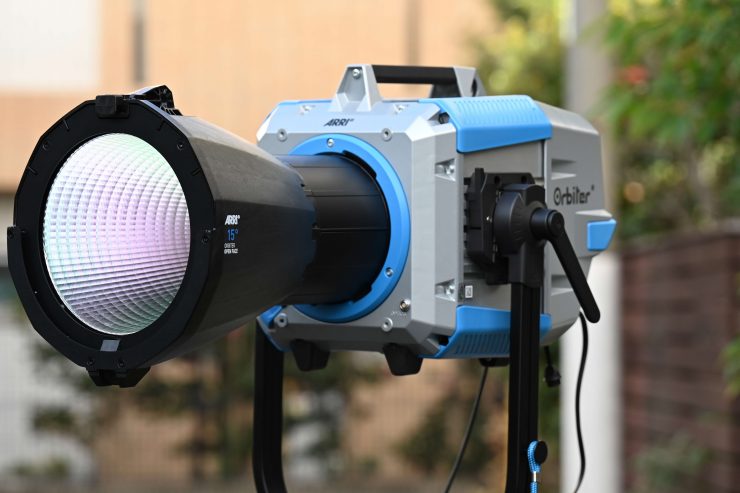
The Orbiter weighs in at 11.7kg / 25.8 lb. With the yoke frame, it tips the scales at 15 kg / 33 lb. This makes it quite a heavy fixture, but then again, it’s lighter than an S60-C SkyPanel and power supply. In saying that, 15kg is heavy no matter which way you look at it.
So how does this weight compare to some other similar fixtures?
| Light Head | Power Supply | |
| ARRI Orbiter | 11.7 kg (15 kg with yoke frame) | No external power supply |
| PROLYCHT Orion 300 | 3.5 kg | 3.2 kg |
| HIVE LIGHTING Super Hornet 575-C Open Face Omni-Color Led Light | 2.49 kg | 3.6 kg |
| Aputure Light Storm LS300X | 3.23 kg | 2.24 kg |
| Godox VL300 LED Video Light | 2.64 kg | 1.26 kg |
| Nanlite Forza 300 LED Monolight | 2.31 kg | not listed |
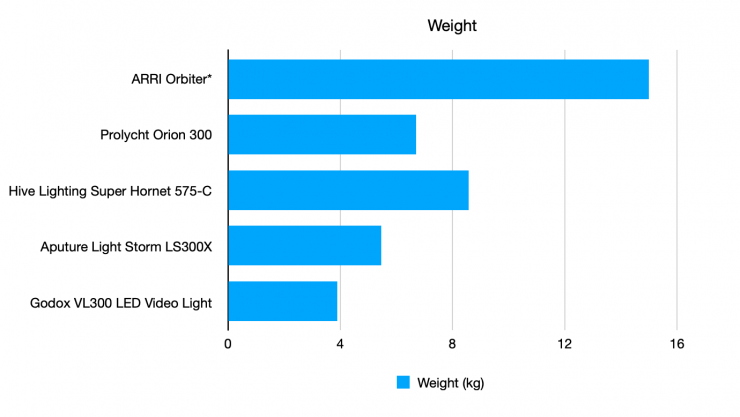
Just to be crystal clear, some of these fixtures don’t have the features of the Orbiter. The only real competition comes from the PROLYCHT Orion 300 and the HIVE LIGHTING Super Hornet 575-C Open Face Omni-Color Led Light. I have listed some other lights just so you get a reference as to how it compares weight wise to other fixtures that can use various modifiers and optic attachments.
Just as another weight reference, below you can see what a few HMI fixtures weigh:
| Light Head | Power Supply | |
| ARRI Orbiter | 11.7 kg (15 kg with yoke frame) | No external power supply |
| ARRI M8 | 7.8 kg | 6.5 kg |
| K 5600 Lighting Joker2 800W | 4.1 kg | 6.35 kg |
| Bron Kobold DW800 HMI | 3.9 kg | 2.6 kg |
| Mole-Richardson 800 Watt HMI DayLite Par | 5.9 kg | 2.72 kg |
| Dedolight Daylight 400DT HMI | 4 kg | 3.4 kg |
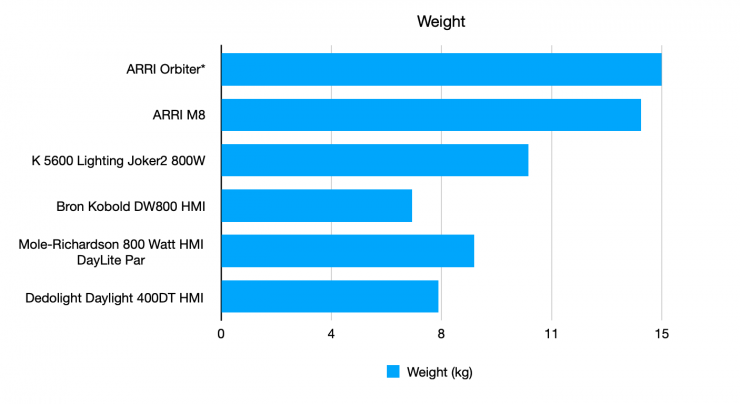
It is interesting to see that the Orbiter basically weighs the same as the M8 with its ballast.
Mounting
With the standard ARRI Orbiter LED Light you don’t get a yoke, it is an optional extra. The Orbiter’s mounting points let you secure the optional yoke for positioning with a +/-90° tilt. The yoke features a standard 1 1/8″ Junior pin. The ARRI Manual Yoke with Spigot for Orbiter costs an additional $200 USD.
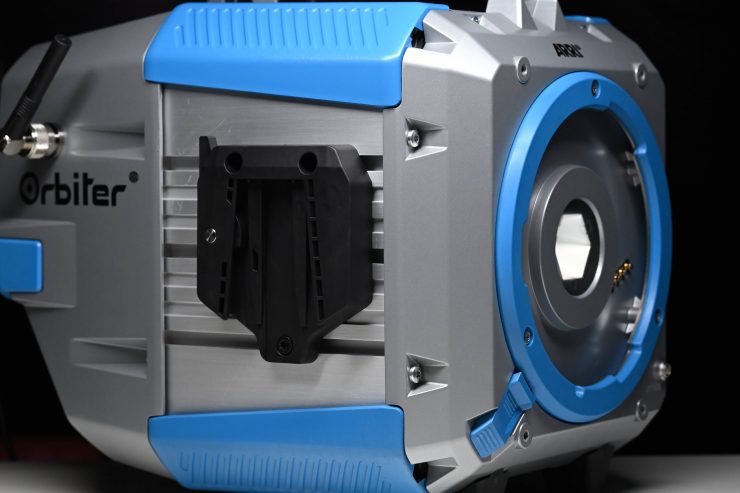
I love the quick release system on the Orbiter. It allows you to place the light on the yoke and remove it very quickly.
Above you can see how easy it is to put the Orbiter on the yoke frame and take it back off using the quick release system.
It is a little bit cheeky of ARRI to charge an additional $200 USD for a yoke when the base light costs $5,239.08 USD. The rationale behind this is that there are so many different mounting options available they thought it was better that the customer makes the choice.
Power Draw
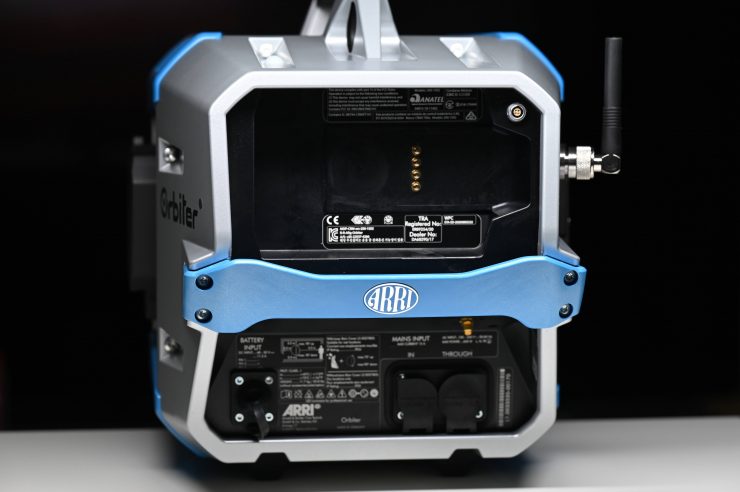
Orbiter includes a lightweight internal power supply and a 3-pin XLR battery input for 48V batteries. The light draws 400W Nominal, 500W Maximum.
The value of 500W includes the entire set of ports, including interfaces like USB and Ethernet switches, and electronics in addition to the ARRI Spectra LE (light engine). Also considered are an external supply like the control panel in remote setup, and future motorized accessories.
The overall power consumption of all these additional electronics is about 100W, leaving 400W for the light engine. Divided between the light engine’s six channels, this equates to about 65W per channel, which is approximately 35% less per channel compared to the SkyPanel. Additionally, the ARRI Spectra design prioritizes optimum color rendition and the smallest footprint over maximum brightness. The efficiency of Orbiter is less than the SkyPanel at the same power consumption.
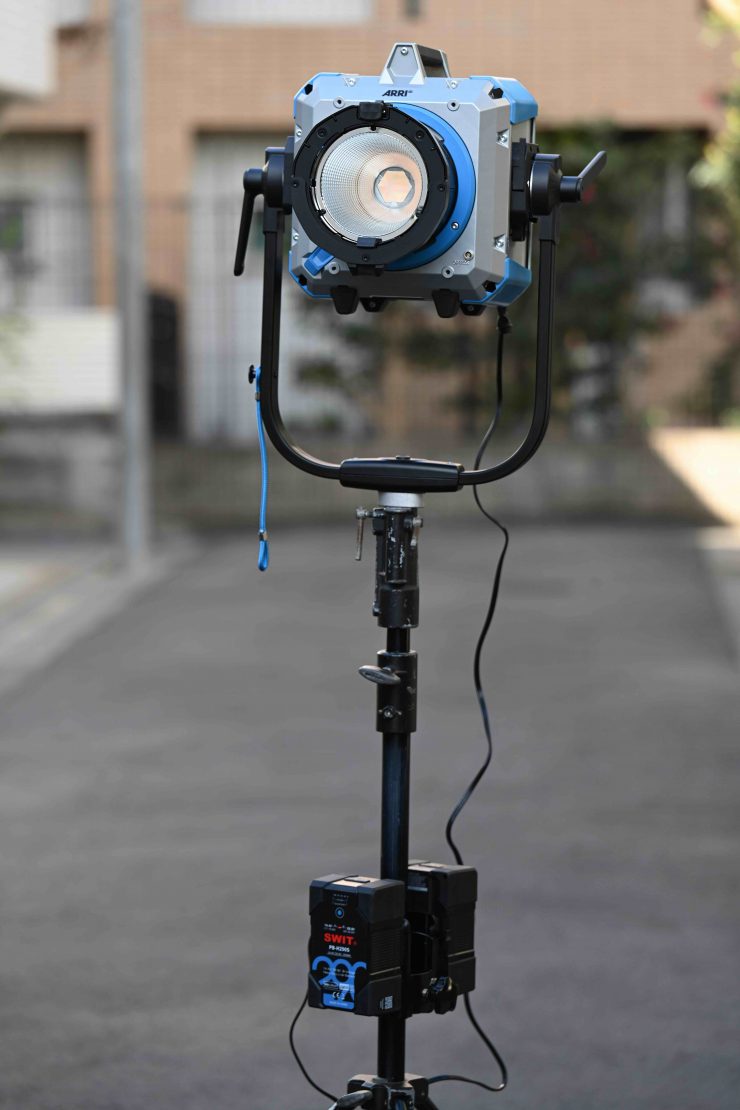
I used the SWIT TD-R210S 24V/48V Light Stand Power Adaptor with two SWIT PB-H290S 290Wh Intelligent Bi-voltage Batteries to power the Orbiter remotely. With this solution, I could power the fixture at 100% output with no limitations for well over an hour.
So how does the power draw compare to some other similar fixtures?
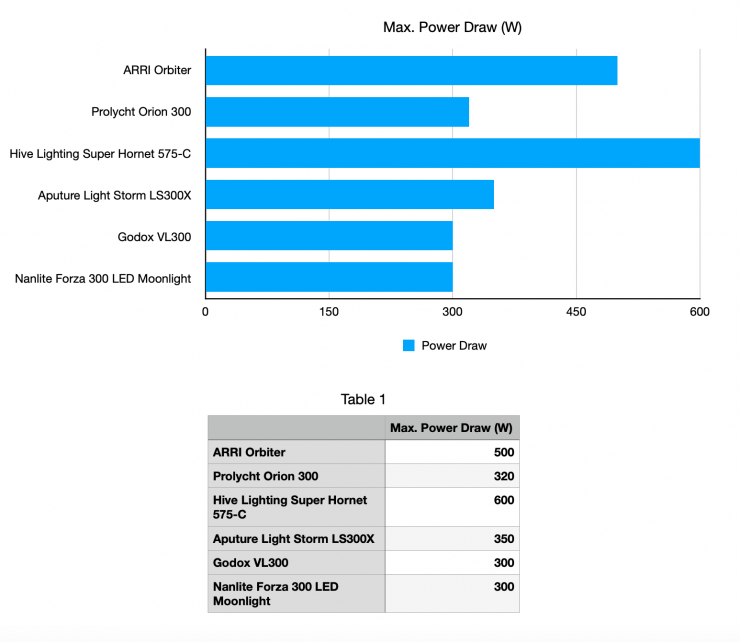
How does the power draw compare against some traditional HMI fixtures? Below you can see.
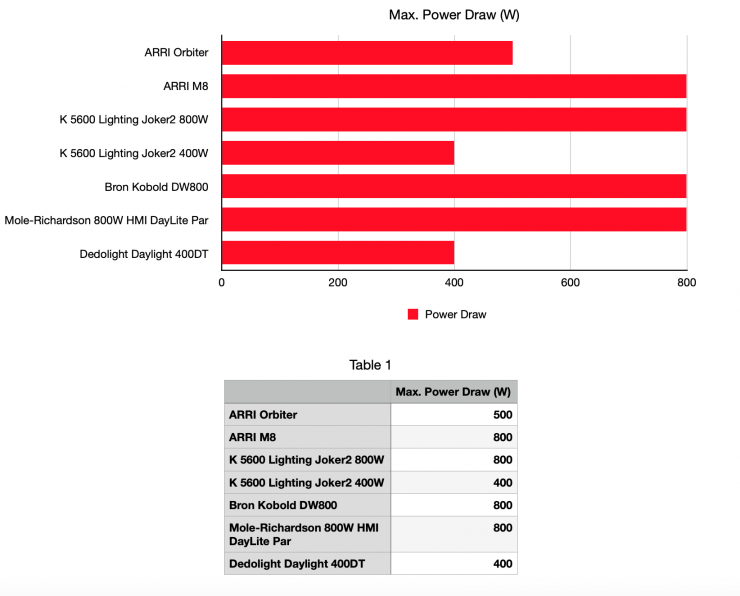
Quick Lighting Mount (QLM)
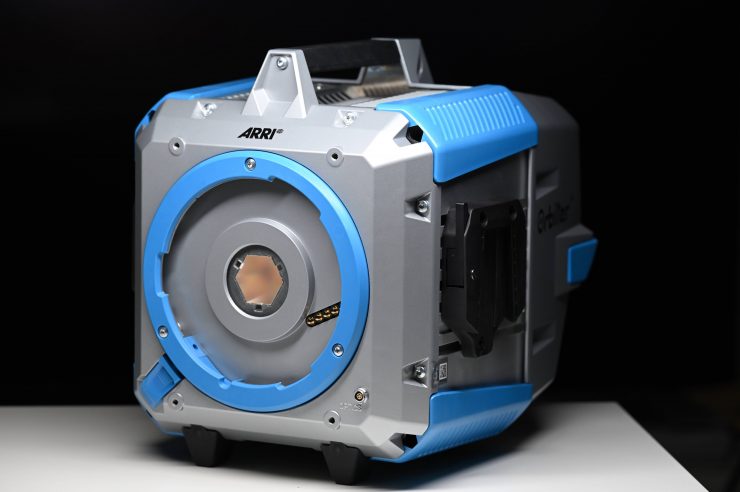
ARRI’s Quick Lighting Mount (QLM) is a bayonet-style connection similar to a camera lens mount. In a lot of ways, it is similar to a gigantic Canon EF mount.
Above you can see how easy it is to put optics on the Orbiter using the QLM mount.
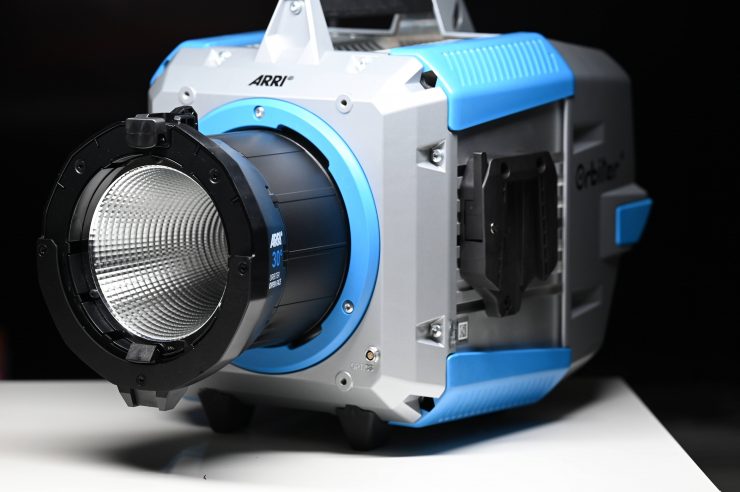
You can use this mount to attach optional optics which include 15, 30, and 60° open-face that produce directional, sharp, focused beams with evenly distributed color. There are also third party small, medium, and large domes that provide a large area of soft light. The light can also be used with separately available light banks, barn doors, honeycombs, and other light-shaping accessories with the appropriate adapter.
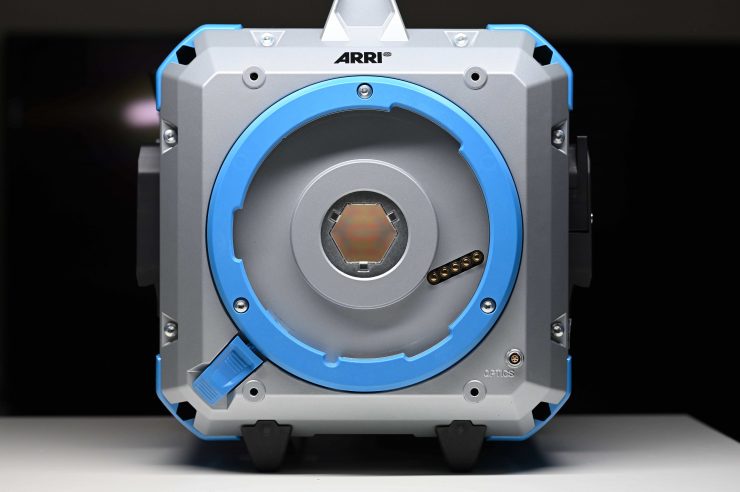
Unlike Bowens-S mounts that wobble around and don’t actually lock in solidly to anything, the ARRI QLM mount is rock solid.
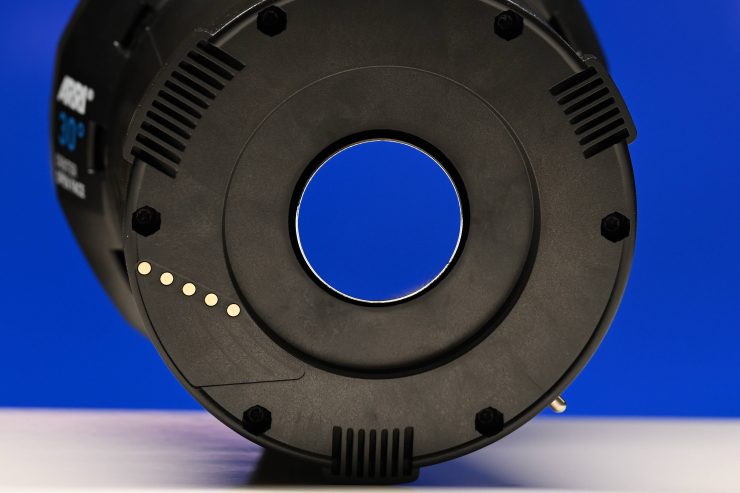
The Orbiter also has a sensor that integrates with whatever optical attachment you place in front of the light. This lets the Orbiter know exactly what is being attached. Even if you put a softbox on the Orbiter, it knows which one you have attached. The interface port can also act as a power supply for an optical accessory when required.
You can’t use the Orbiter without an optic attached. If you try and turn the light on without having an optic or softbox with the correct mount attached you will get a warning on the control panel that says: Optics Recognition Failed.
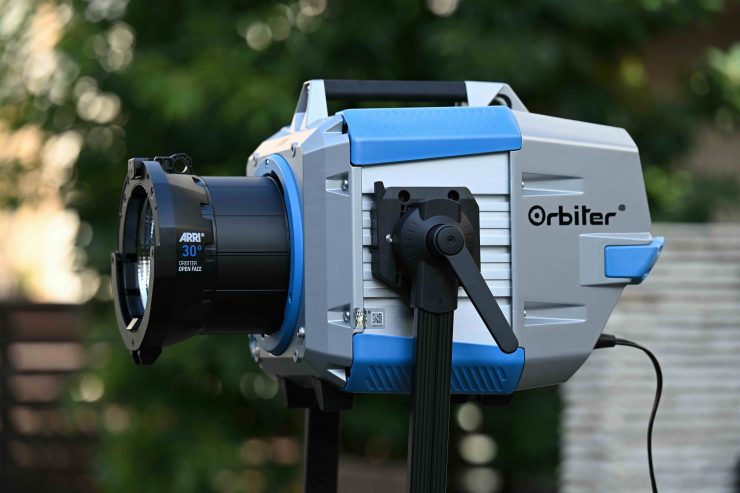
Having a proprietary mount comes with its own caveats. Whereas mounts such the Bowens-S allow you to use a wide array of affordable lighting modifiers, the ARRI QLM still has a quite limited selection of attachments. It will be interesting to see if other third-party companies start making optical accessories for this mount.
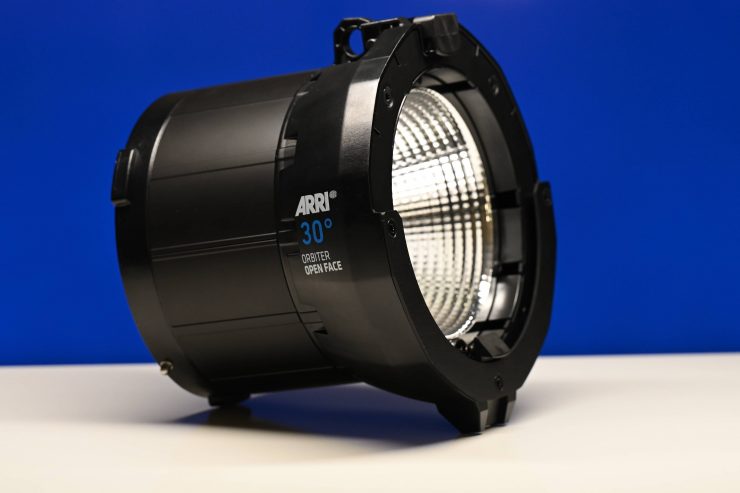
The optical Open Face lenses that ARRI does make for the Orbiter are quite large, but they are fairly lightweight. Here are the lengths and weights of the various Open Face Optics:
| WEIGHT | LENGTH | |
| 15° | 2kg / 4.4 lbs | 38cm / 14.96″ |
| 30° | 850g / 1.87 lbs | 15.6cm / 6.1″ |
| 60° | 590g / 1.3 lbs | 8.7cm / 3.4″ |
The downside of a system that utilizes interchangeable optics is that you have to carry around a lot of extra accessories. Unlike a Swiss Army Knife where everything folds into the unit, the German Army Knife of lighting is going to take up a lot of space once you start adding optics and lighting modifiers.
Removable Control Panel & Operation
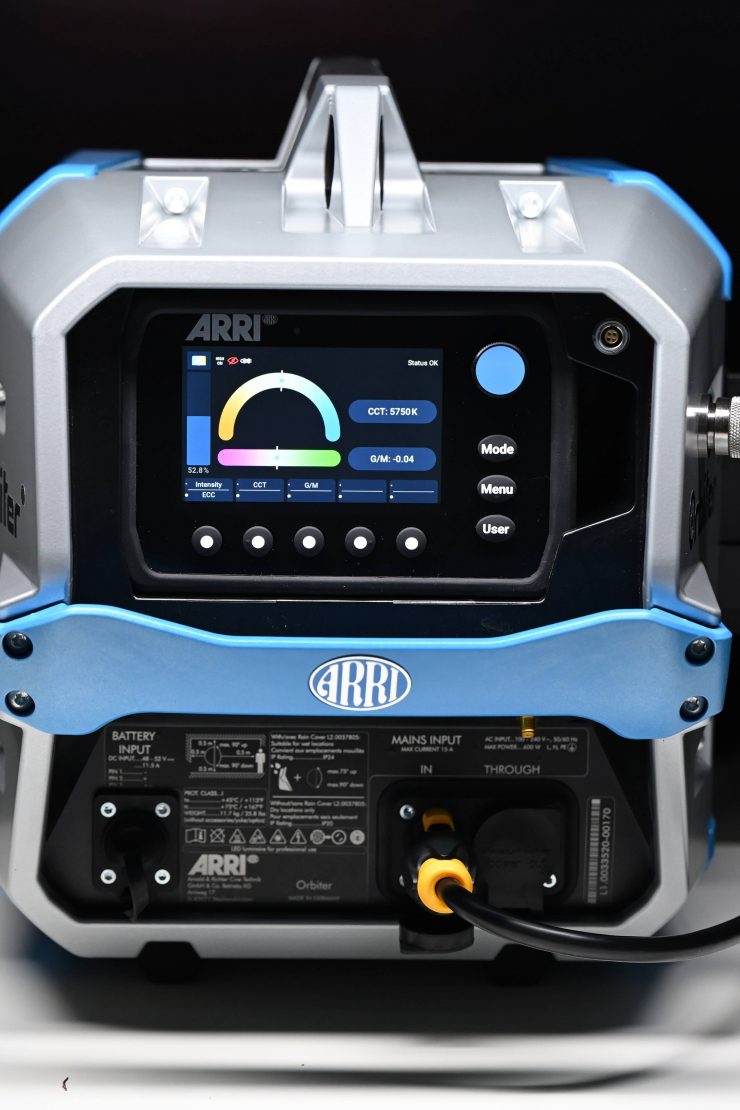
The Orbiter features a 4” full-color display, quick navigation buttons, and integrated sensors. The Orbiter’s control panel is easy to use and it has a nice graphic user interface. While the light has a ton of functionality, ARRI has included a really simplified menu structure and uncluttered screens. If you have ever used an ARRI camera you will know how easy it is to use the menus, and that same philosophy has been carried forward to the Orbiter.
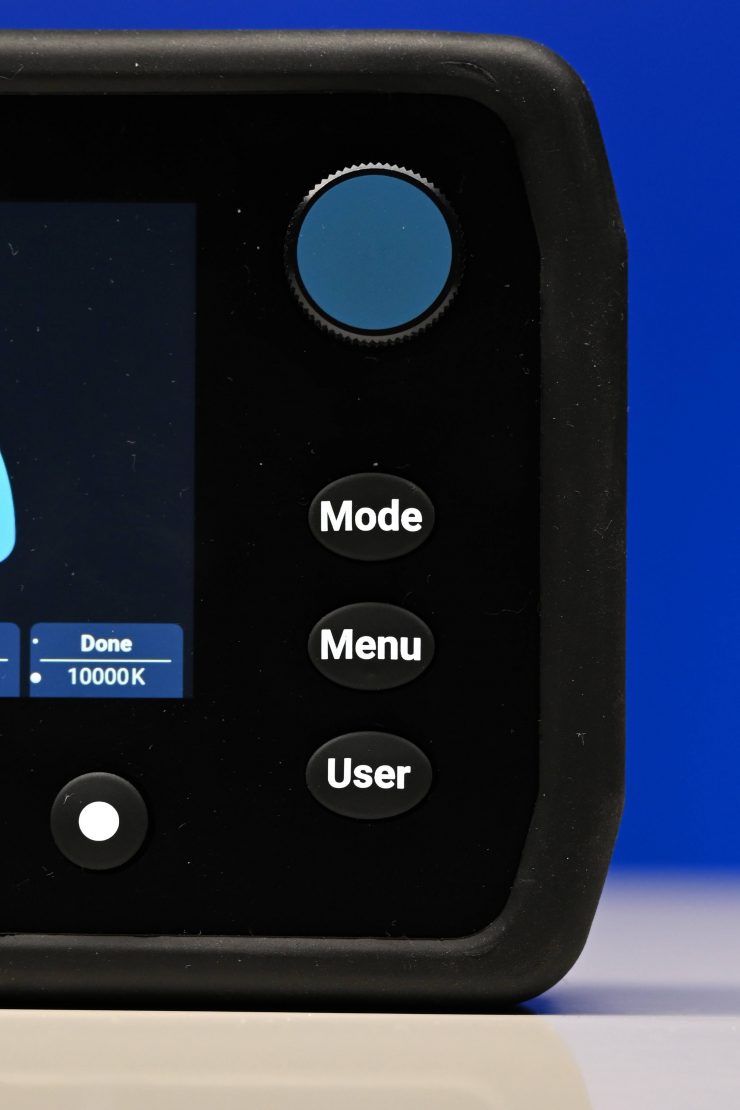
The user interface on the Orbiter is very similar to that of Stellar, and anyone who has used that system will be comfortable using the Orbiter. The interface isn’t a touch screen. Instead, everything is controlled via dials and buttons. In a way, I would have liked to have seen a touchscreen interface with the option to use buttons and dials if you wanted to.
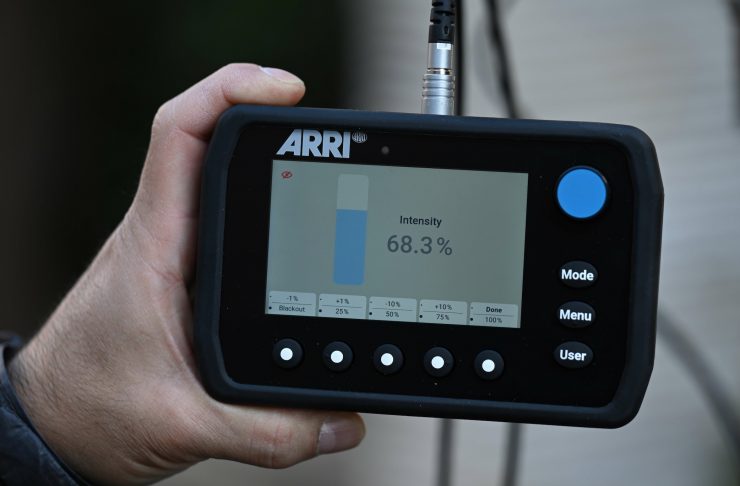
When I first started using the Orbiter I kept trying to make changes by touching on the control panel screen. In a world of touchscreen devices, we have a natural tendency and muscle memory that kicks in and our brain is just assuming the screen can be operated by touch.
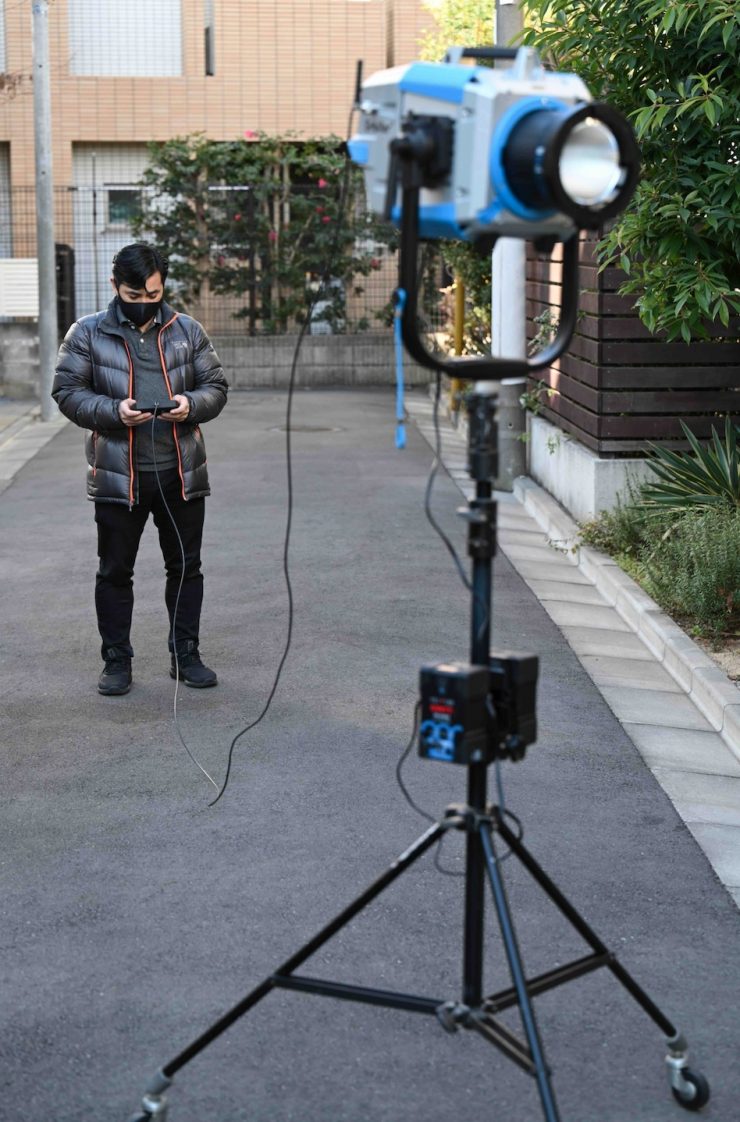
In addition, the control panel is removable and can be used handheld with the aid of a 5 or 15m (16.4 or 49.2 ft) control panel cable.
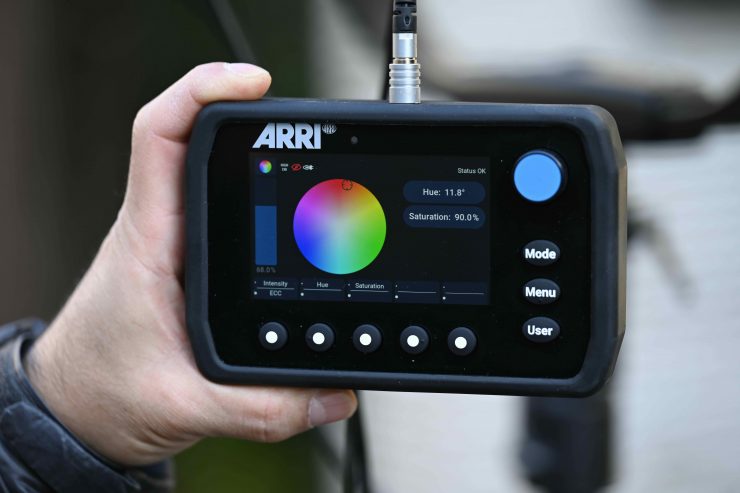
While some people may not be a fan of hard-wired controllers, I quite like them. It is nice that you can take the control panel out when the light is up high and then make adjustments. Would it have been great if this controller was completely cable-free? Yes, of course, however, there are other ways of controlling the light remotely.
The control panel display can be set to auto-rotate if it is used upside down, and you can also control the brightness and set whether you want the display to have a white or black background.
The control panel is not shipped with the base fixture as a standard. It is available as an accessory.
The Orbiter takes around 10-15 seconds to boot up and be ready to use from the time you turn on the power.
Enhanced connectivity
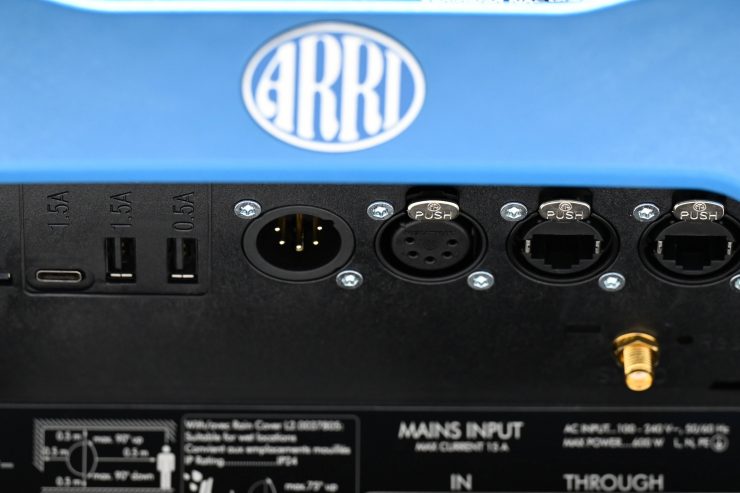
Orbiter includes a full suite of input and output connectors. Ethernet daisy chaining is possible through the use of two EtherCON ports that support Art-Net 4, sACN, and TCP/IP.
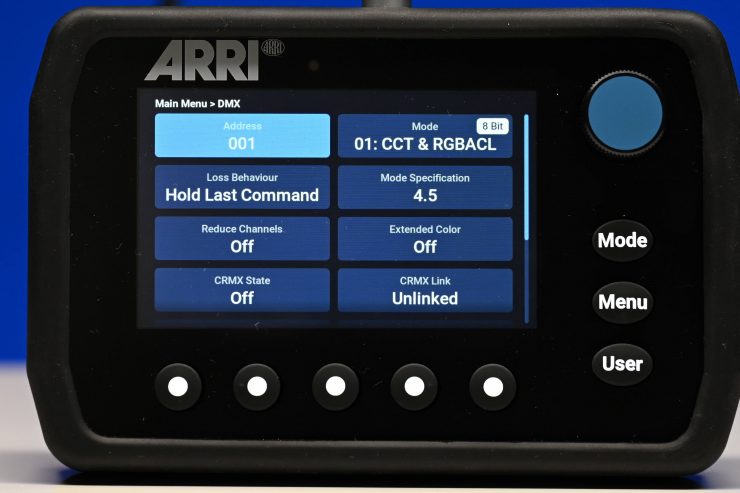
Two USB-A ports are used for LiOS updates and connection of third-party peripherals such as Wi-Fi USB dongles. LumenRadio’s CRMX solution is also included, which allows for wireless DMX.
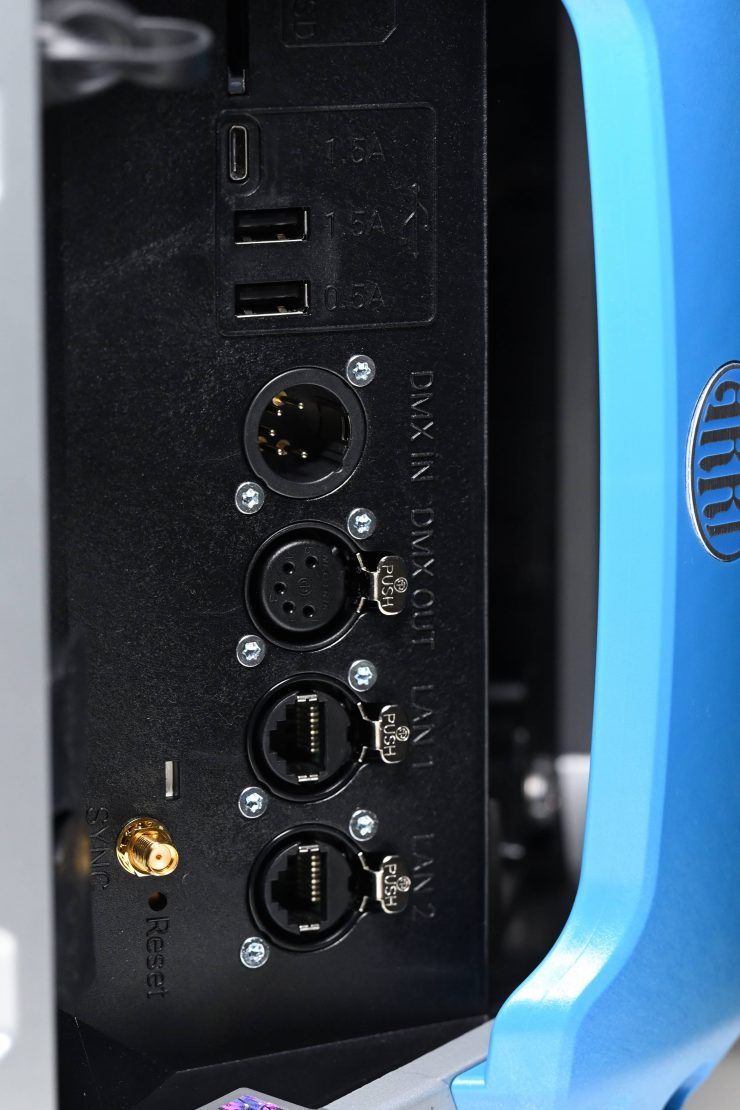
Two 5-pin XLR DMX ports can be used for conventional DMX & RDM communication in and through. The 3-pin XLR DC input is for a 48 V power station.
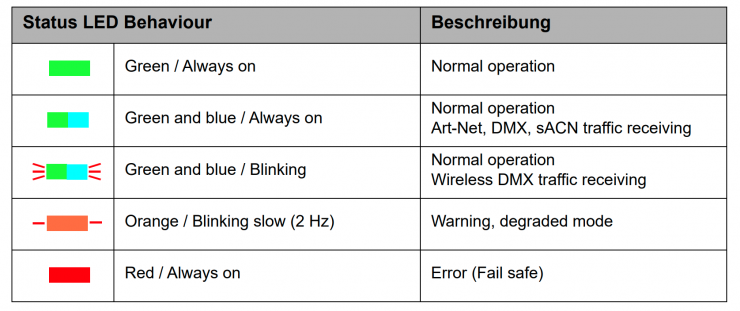
A status LED lets you know the behavior of the Orbiter. Above you can see what various colors indicate.
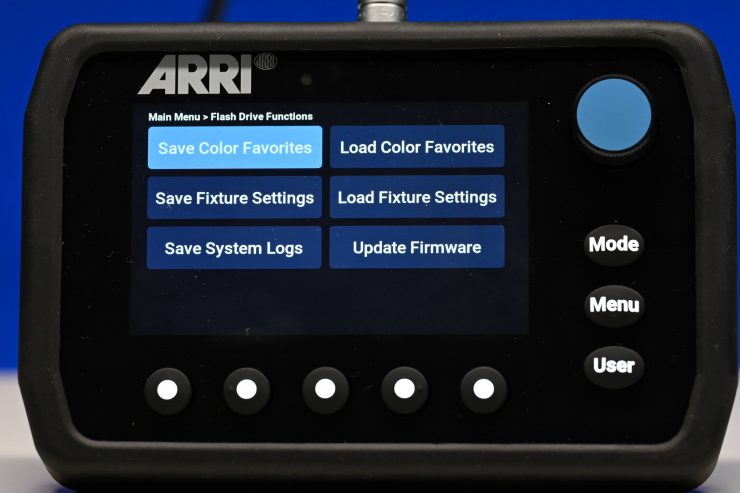
An SD Card slot enables future expansion of the software. Finally, a USB-C port is available for computer communication and servicing.
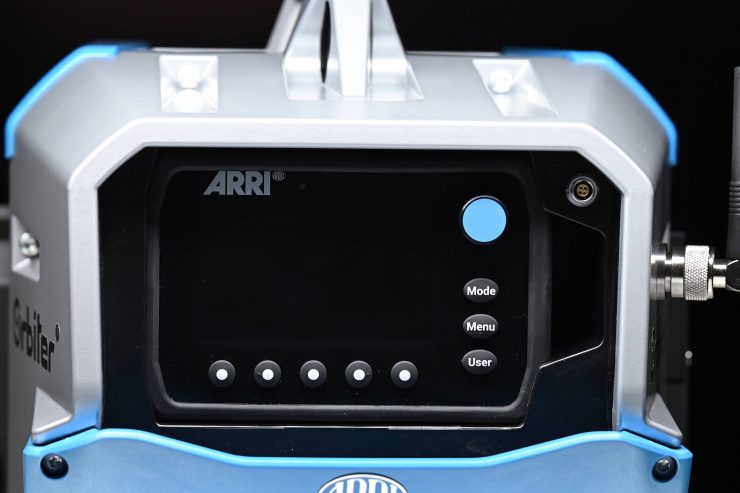
What is very interesting is that soon you will be able to attach the Orbiter directly to an ARRI camera through the LEMO connector and the data from the Orbiter will be recorded along with the camera’s metadata. This has lots of interesting and useful applications in post.
ARRI Spectra six-color LED light engine
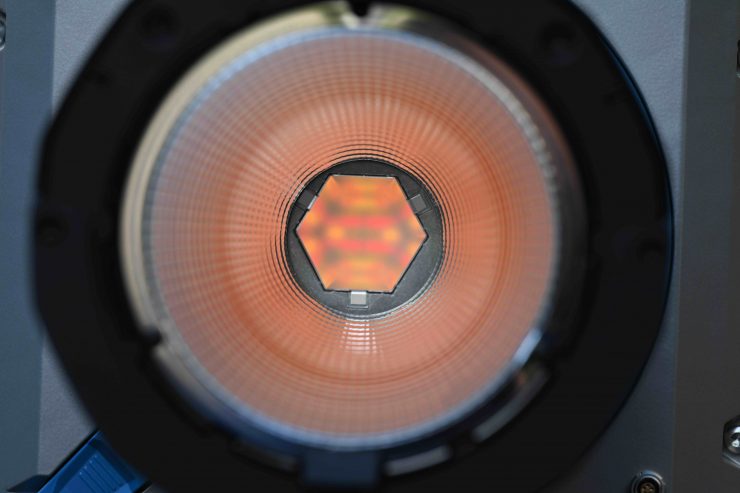
The processor being used in Orbiter is four times faster than the SkyPanel, and it has 125 times more memory. Like a lot of modern-day ARRI cameras, the processor becomes the brain, and the bigger and smarter the brain, the more extensive software features and updates you can implement in the future.
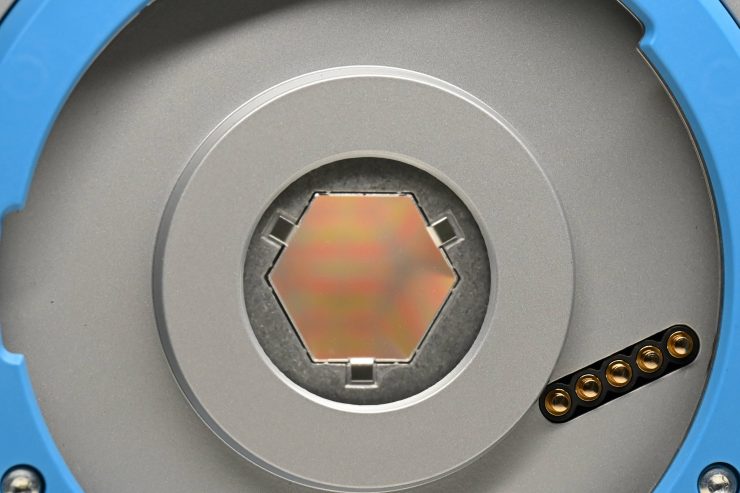
The Orbiter’s Spectra six-color light engine includes a red, green, blue, amber, cyan, and lime LED. ARRI states that the ARRI Spectra six-color light engine translates into a wider color gamut and more accurate colors. Compared to say the RGBW SkyPanels, the way hues are generated on the Orbiter follows a different algorithm.
The six new LED colors have been selected to create a more continuous spectrum that results in claimed ultra-high values in metrics like CRI, TLCI, and TM30-15.
All individual LED colors are selected by minimum binning variation to achieve a great spectrum. According to the company, ARRI Spectra utilizes a new generation of LEDs which are only available from ARRI.
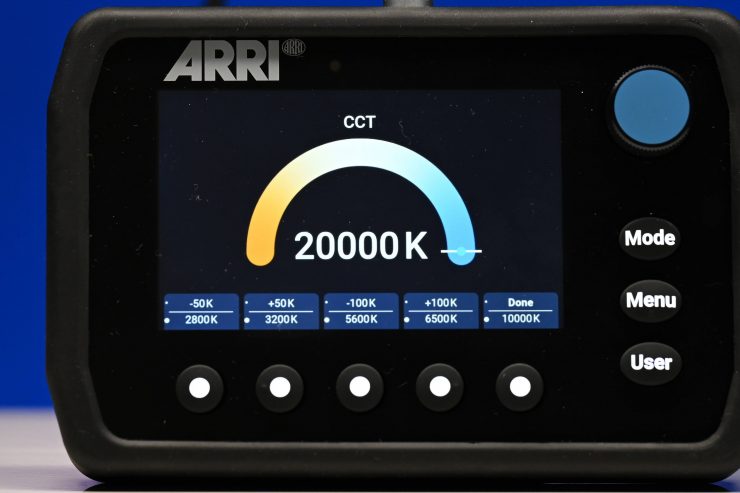
The Orbiter has a larger CCT range of 2,000 to 20,000K and the light is claimed to have ultra-high color rendition across all color temperatures. We will see if this is true later in the review.
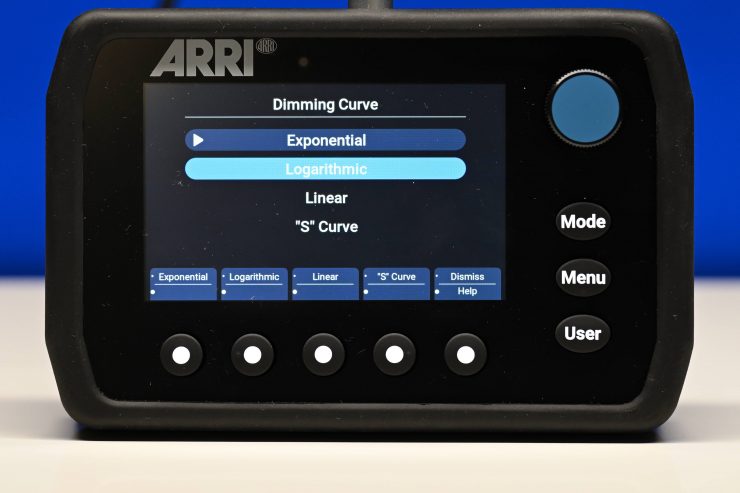
The fixture uses a combination of four dimming techniques so that Orbiter’s electronics can provide smooth dimming down to zero without color changes or jumps.
Full suite of sensors
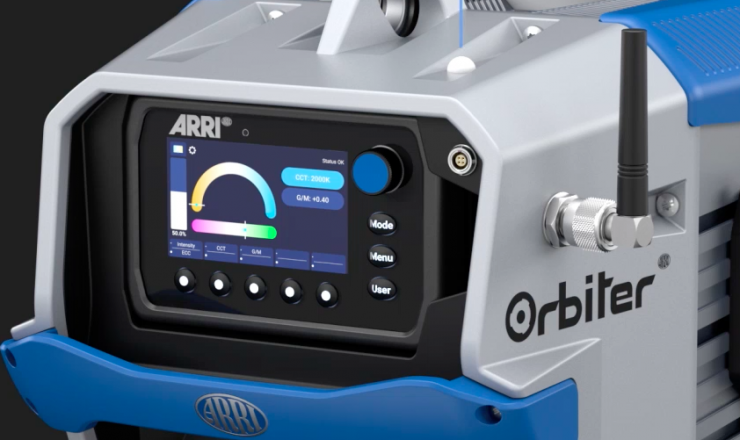
Orbiter features a color sensor for measuring the ambient light, a 3-axis accelerometer and magnetometer for sensing the pan, tilt, roll, and heading of the fixture, heat sensors for keeping the LEDs and electronics at exactly the right temperature, and an ambient light sensor for automatically dimming the control panel display. All this data can help improve workflows and postproduction.
LiOS
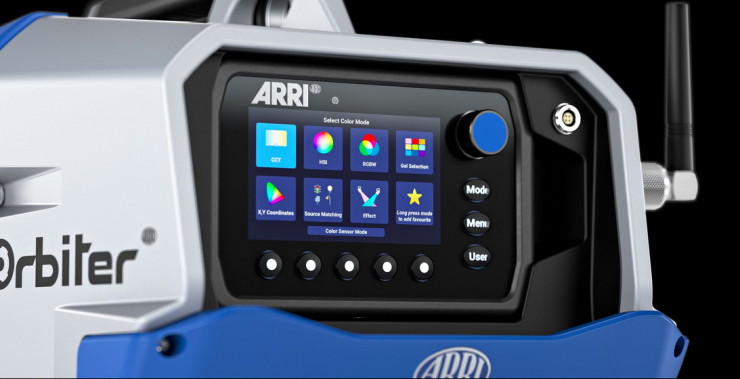
Orbiter takes advantage of more than five years of software development from the SkyPanel. Its new software called LiOS (Lighting Operating System) offers all the innovative features of the SkyPanel series, plus a host more.
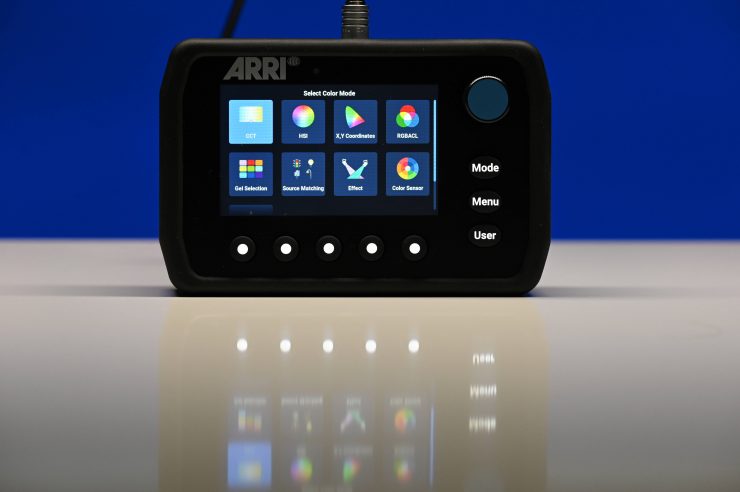
LiOS has eight-color modes:
- CCT
- HSI
- RGBW
- X/Y coordinates
- Gel Selection
- Source matching
- Effects
- Color Sensor Mode
Other new features in LiOS include simplified DMX modes, performance-enhancing operational modes, optics recognition, multi-language support, and a custom boot screen. Again because of the light’s processing power, a lot more features can be added in the future.
CCT Mode
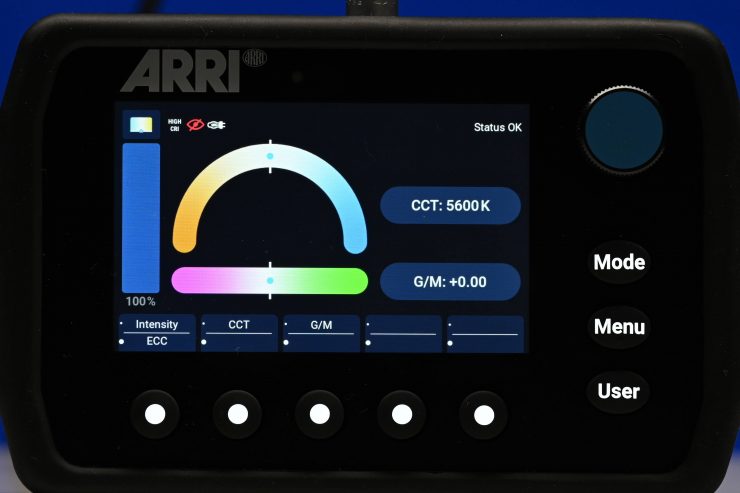
In the CCT mode you can adjust the Kelvin color temperature from 2000-10000K. You can also adjust the intensity. ARRI also lets you use the small buttons below the screen to increase/decrease Kelvin color temperature and intensity in small increments.
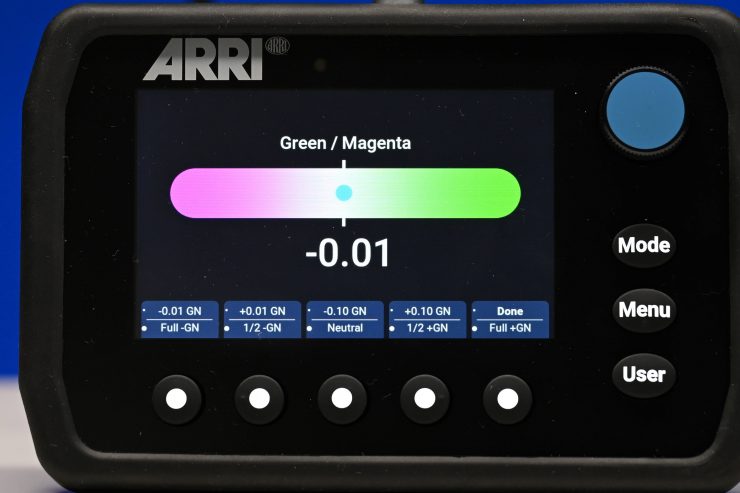
As the fixture includes +/- Green adjustment you can quite easily correct any tint. While there is no exact science to this, and it really depends on what camera you are using as well, it’s just a matter of trial and error to see what setting actually works the best. The nice thing is, any light with +/- Green adjustment can be fine-tuned to deliver better results.
HSI Mode
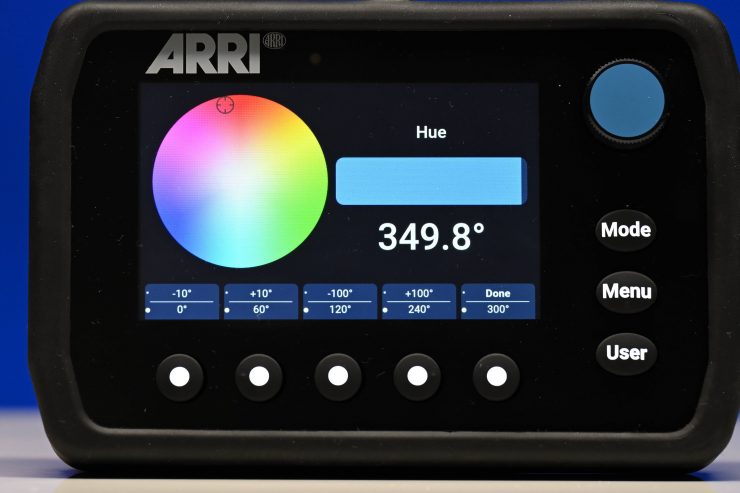
In HSI Mode you can independently control hue, saturation and intensity. ARRI also gives you a lot of customization with the ability to adjust all 6 independent LED colors that make up the Orbiter.
RGBW Mode
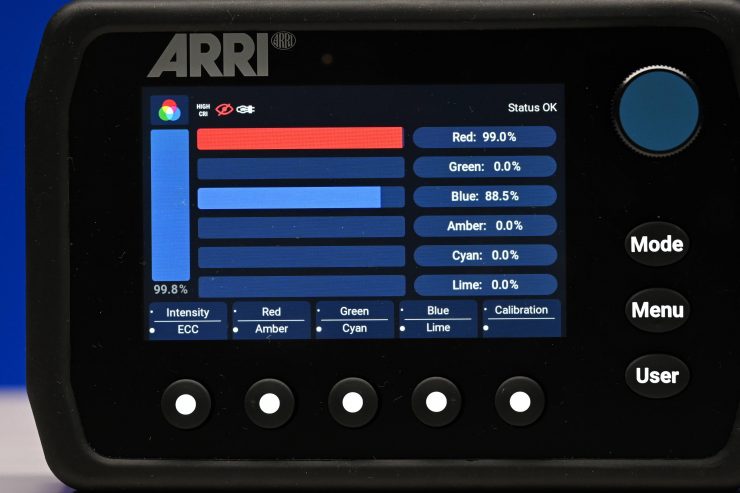
In RGBW Mode you can individually control each of the 6 colors that make up the Orbiter’s light engine.
X/Y Coordinates Mode
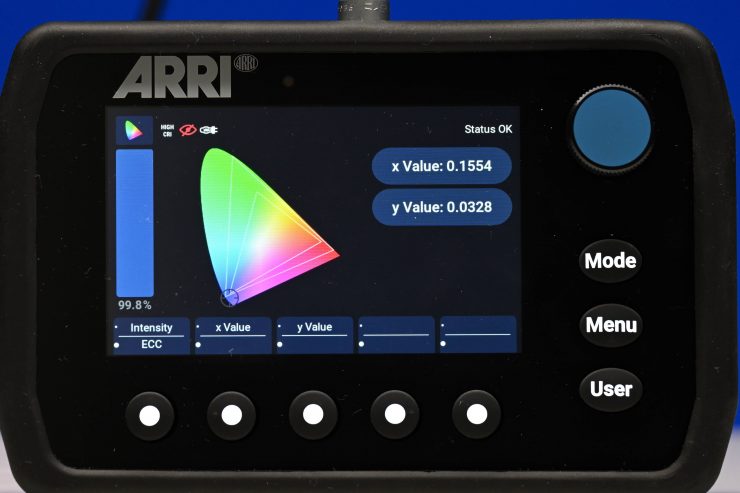
In this mode you can dial in exact x/y co-ordinates to create colors or match other fixtures.
Gel Selection Mode
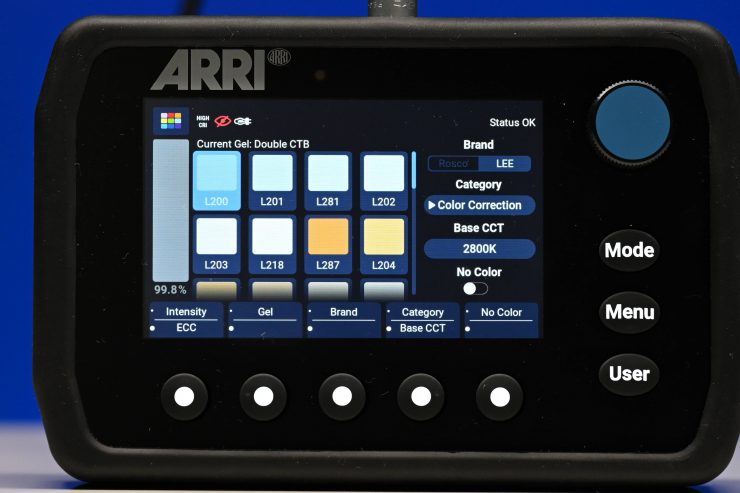
In Gel Selection Mode you can choose from a wide range of Rosco and LEE filters. You can also choose the base CCT you want to use with the gels.
Source Matching Mode
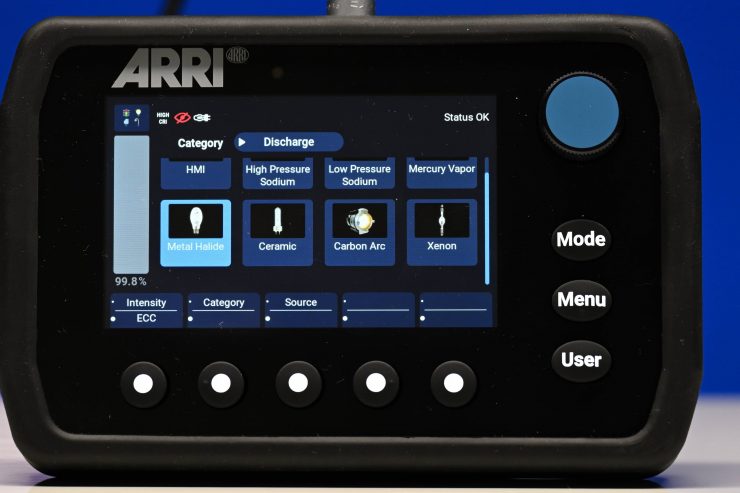
In Source Matching Mode you can choose from a variety of pre-set lighting sources that fall into three categories: Incandescent, Fluroscent, and Discharge. These are very handy is you are shooting under certain lighting conditions and you want the Orbiter to mimic those conditions.
Effects Mode
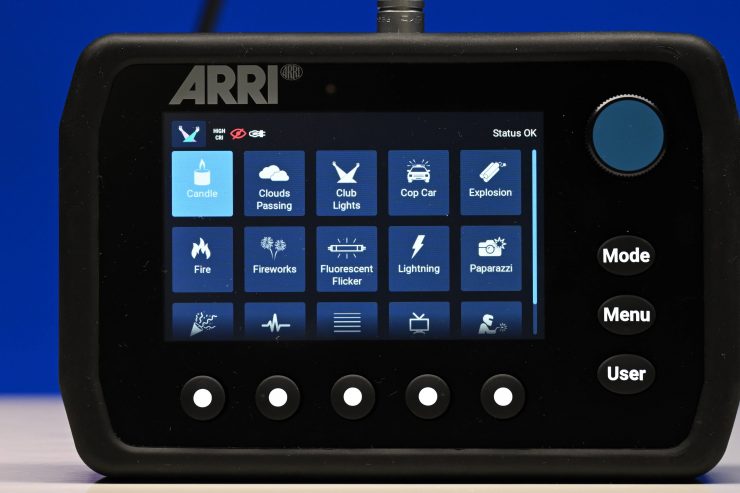
As its name suggests, Effects Mode lets you re-create a variety of lighting effects. You can also tailor these effects as you see fit. The effects in the Orbiter are really good and the additional color LEDs certainly help with creating more realistic look.
Color Sensor Mode
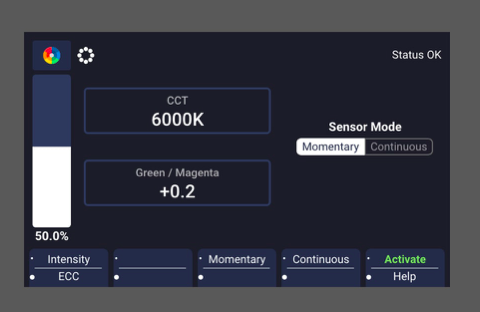
The new Color Sensor Mode in Orbiter reads the ambient color surrounding the fixture and reproduces the color with what ARRI claims is great accuracy.
There are two measurement types: Continuous and Momentary. Continuous will constantly measure the ambient color and update the light output accordingly. Momentary will only take one measurement of the ambient color with the press of a button. This new color mode is useful for situations where the light in your environment is changing. Orbiter can automatically adjust for color changes without you needing to do anything.
It sounds like magic, but it is just clever use of software and hardware that makes this possible. We will see how this actually works further down in the review.
Extended Color Control (ECC)
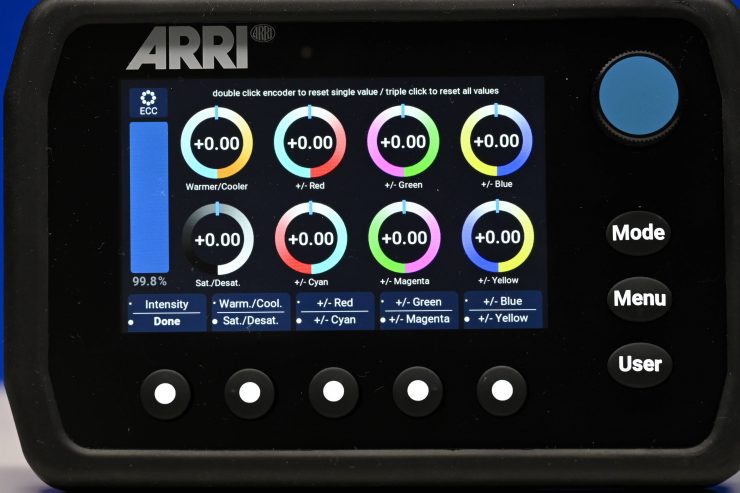
The extended color control (ECC) allows the modification of the selected color. It can be used both via the control panel or DMX. It is available in all modes except Effects and Favorites,
The eight stylized rotary controls with neutral position in the middle represent the parameters of the extended color control. The crossbars show the current value of the parameter. The active parameter is marked
by a light blue frame around its rotary control.
Double-clicking the encoder sets the selected parameter to the neutral position, triple-clicking sets all parameters of the extended color control to the neutral position.
When changing the mode, the current values of the parameters are stored and will be recalled the next time this mode is called up. The parameters are retained when the Orbiter is switched off.
When extended color control is active:
• The mode symbol in the display is followed by the symbol for extended color control in the main menu.
• The parameters are saved with a favorite. Favorites with parameters of the extended color control are marked with an asterisk, an active favorite is left when a parameter is changed.
• The calibrated RGBACL color space is activated when extended color control via DMX is active.
• The direct RGBACL color space cannot be used.
• The parameters are taken into account during crossfade.
• The parameters are not considered when an effect is activated.
Favorites
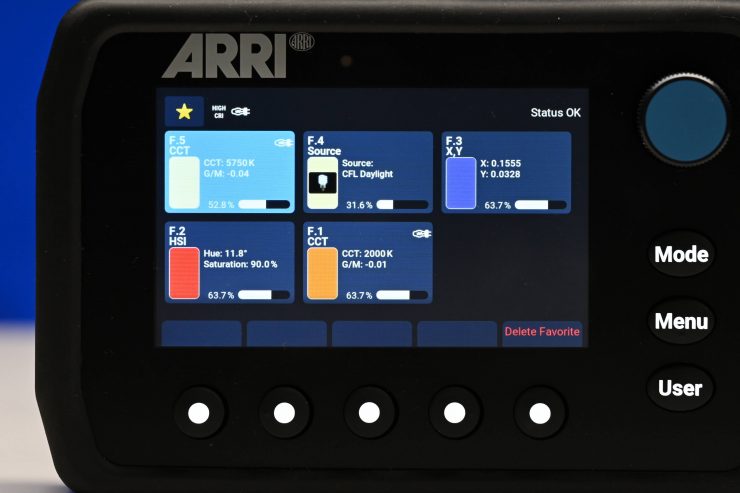
246 favorite colors or lighting effects can be stored in Orbiter. These favorites can be easily selected via the user interface or via DMX.
All you have to do to save a favorite is just long-press on the Mode button.
Favorites are shown in order of their creation date. I wish there was a way to actually label the favorites so it would be easier to recall the exact one you want to use.
Dimming Curves
The Orbiter supports four dimming curves. The dimming curves are global: They affect both the intensity control via the control panel or DMX, WDMX, Art-Net and sACN.
• Linear: The intensity changes proportional to the encoder or the channel value.
• Exponential: This is the default setting. The resolution is high at lower intensity levels and low at higher intensity levels. Use this dimming curve when you need a high resolution at low-intensity levels. This is the default setting.
• Logarithmic: The resolution is low at lower intensity levels and high at higher intensity levels. Use this dimming curve when you need a high resolution at high-intensity levels.
• S curve: The resolution is both high at lower and higher intensity levels and low at intensity levels in between. Use this dimming curve, when you need a high resolution at low and high-intensity levels.
High Speed Mode
The High Speed mode generates flicker-free light for High Speed shooting. According to ARRI, the High Speed Mode has been tested up to 25,000 fps and down to 2° shutter angle with no flicker or rolling bars.
Operational Modes
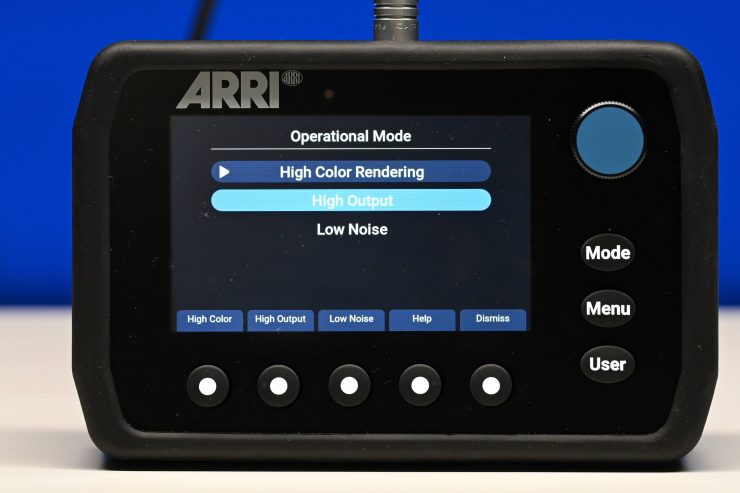
Orbiter offers three operational modes to optimize the fixture’s performance for different applications:
- High color rendering mode provides the best color quality possible
- High output mode generates the best brightness with slightly lower color rendition
- Low noise mode creates a balance for quiet operation with decent output.
What does the Orbiter offer that its competition doesn’t?
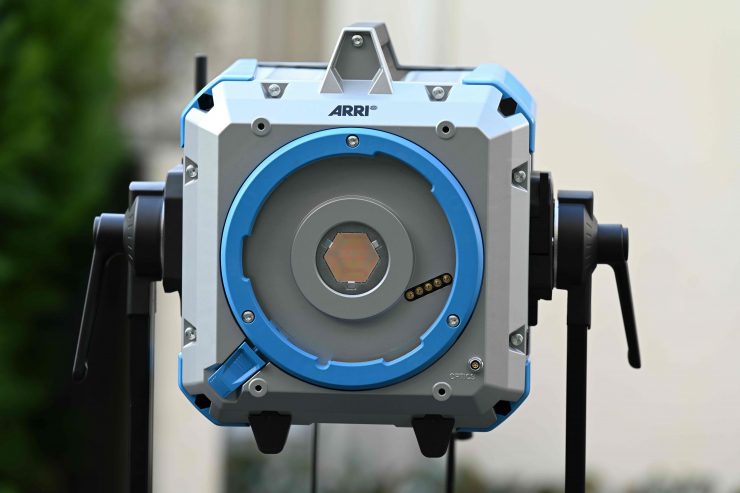
The Orbiter offers a lot of functionality and features that are not found in similar sized lights with similar power draws. The only other two similar spot lights to my knowledge that you could really compare based on features and functionality, are the PROLYCHT Orion 300 and the HIVE LIGHTING Super Hornet 575-C Open Face Omni-Color Led Light. Out of those two, the PROLYCHT is the closest to the Orbiter.
Let’s compare it directly against the two lights that could be considered direct competition, the PROLIGHT Orion 300 and the HIVE LIGHTING Super Hornet 575-C Open Face Omni-Color Led Light.
| HIVE LIGHTING Super Hornet 575-C Open Face Omni-Color Led Light | ARRI Orbiter | |
| CCT Range | 1650-19,500K | 2000-20000K |
| +/- GM | Yes | Yes |
| HSI | Yes | Yes |
| Gels | Yes | Yes |
| Source Mode | Yes | Yes |
| X/Y coordinates | Yes | Yes |
| Effects | Yes | Yes |
| Onboard Sensors | No | Yes |
| Mount | 100mm diameter Profoto-type modifier mount | Quick Lighting Mount (QLM) |
| Power Draw | 400-600W | 400-500W |
| App Control | Yes | Yes |
| Battery Plate | No (only 48V DC IN) | No (only 48V DC IN) |
| Weight | 2.49 kg (lamp head) 3.63 kg (controller/ power supply) | 15 kg (Including Yoke) |
| PROLYCHT Orion 300 | ARRI Orbiter | |
| CCT Range | 2000-20000K | 2000-20000K |
| +/- GM | Yes | Yes |
| HSI | Yes | Yes |
| Gels | Yes | Yes |
| Source Mode | Yes | Yes |
| X/Y coordinates | No | Yes |
| Effects | Yes | Yes |
| Onboard Sensors | No | Yes |
| Mount | Bowens-S Mount | Quick Lighting Mount (QLM) |
| Power Draw | 300-320W | 500W |
| App Control | Yes | Yes |
| Battery Plate | Yes, 2x V-Lock | No (only 48V DC IN) |
| Weight | 3.5kg (lamp head) 3.2kg (controller/ power supply) | 15 kg (Including Yoke) |
How does it stay cool?
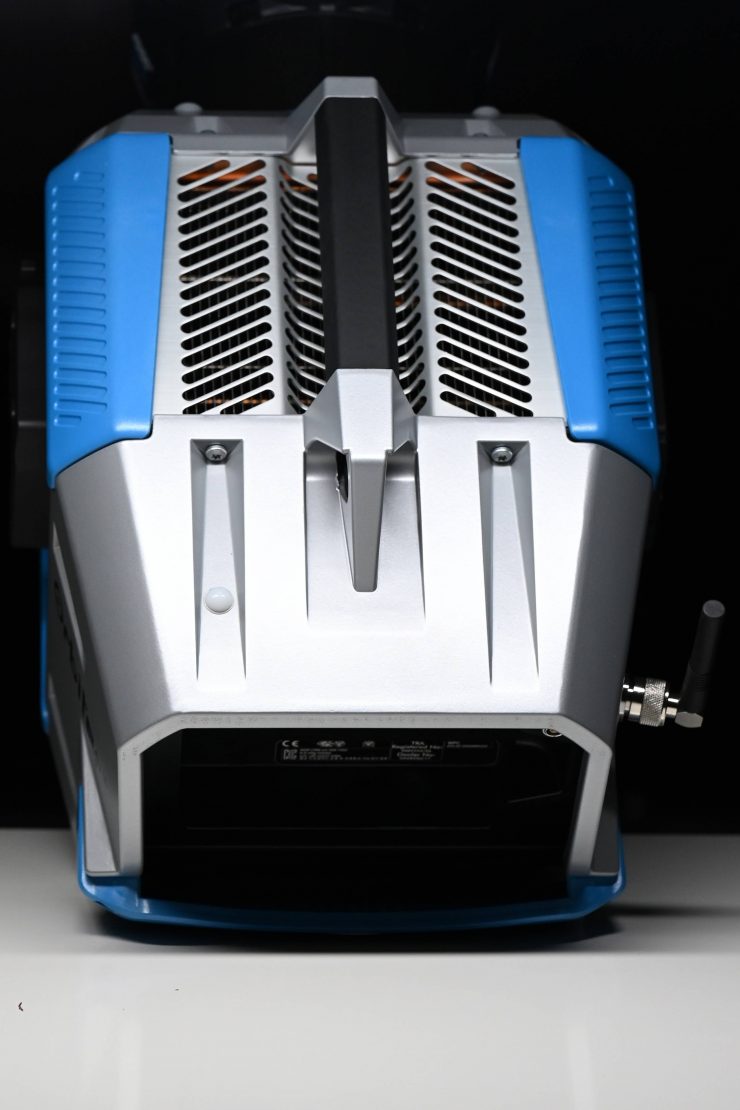
Large, high powered COB lights get very hot, and keeping them cool is not an easy task.
The Orbiter has a fan and a giant cooling system to deal with the heat. There really isn’t any way of building a COB high output, high power draw based fixture without using a fan.
The fan is only really noticeable when you are using the light in the High Output Mode, otherwise, it is really quiet.
The light doesn’t get very hot even when you leave it on for long periods of time.
Photometrics
So now let’s get to the photometric results. I always test lights in this way so that I get a reference to how they compare to other fixtures. Results only tell part of the story and should never be used alone to judge a light. I have found from extensive testing over the years that certain lights that have good photometric results don’t always look good, and lights that have worse photometric scores can sometimes look better than their results indicate.
Different lights can also look different depending on what camera you happen to be using. Like the SkyPanel series, the Orbiter is arguably going to look better when using an ARRI camera.
Output & Color Temperature Accuracy
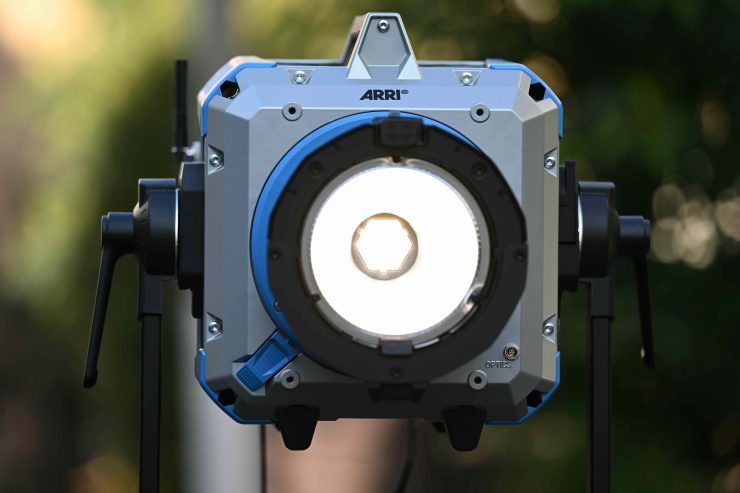
I tested the ARRI Orbiter at a variety of Kelvin color temperatures with a Sekonic C-800 Spectrometer to find out how much output the light had and how accurate the Kelvin color temperature reproduction was. All readings are taken at a distance of 1m (3.28ft) in a controlled environment.
Here is what ARRI states as the output for the Orbiter:
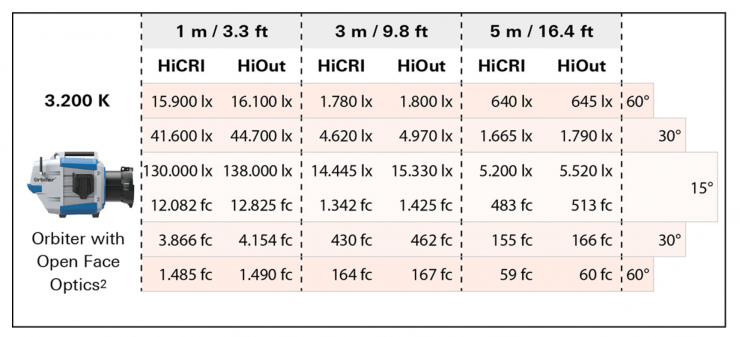
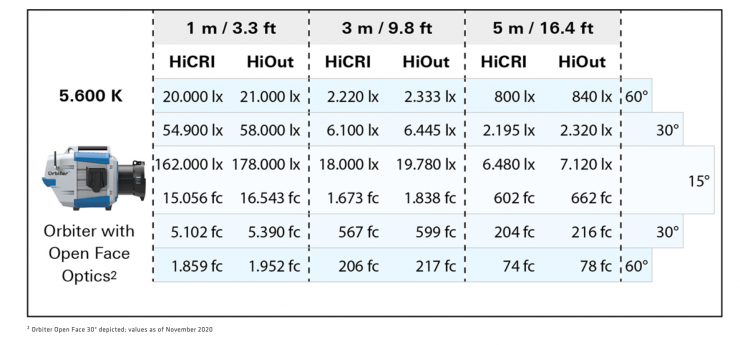
The Orbiter has a decent amount of output, but it isn’t going to have the same amount of output as something like a K 5600 Lighting Joker2 800W. The output is arguably going to be closer to a K 5600 Lighting Joker2 400W. The trouble is comparing HMI fixtures to something like an Orbiter is a slippery slope. They are totally different types of fixtures.
So let’s see my independent testing results. All my readings were taken from the edge of the Optics. I have included results for all three of the currently available optics. ARRI’s quoted figures may have been measured from the actual lighting element and not the edge of the optics.
30° Optic
5600K (30° Optic/ High CRI mode)
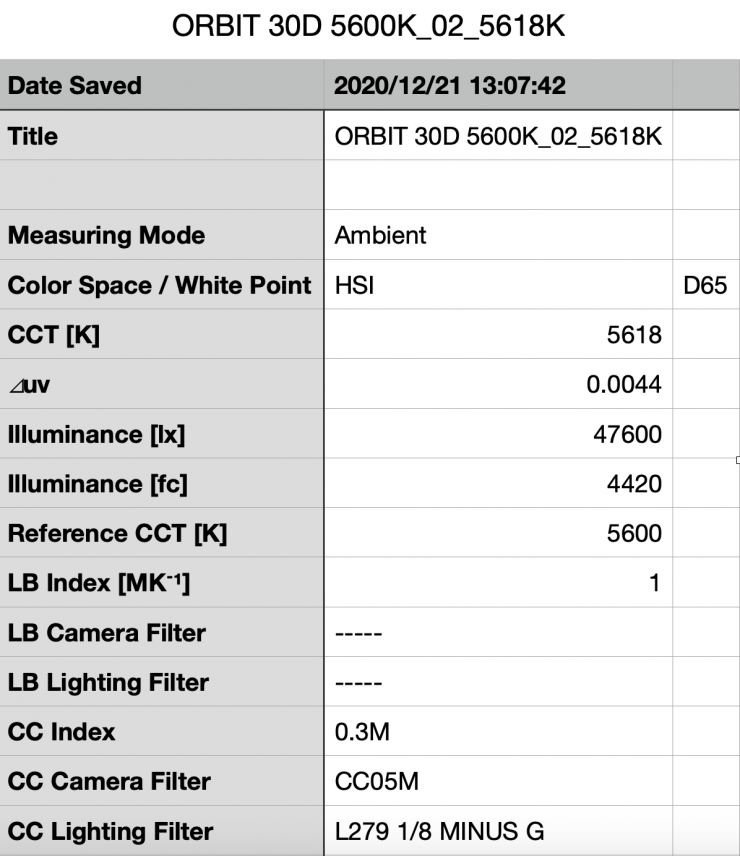
Above you can see the Orbiter recorded an output of 47600 lx (4420 fc) when set at 5600K using the 30° Optic and set to the High CRI mode. The figure of 47600 lx was less than the 54900 lx quoted by ARRI. Again, this discrepancy may well have to with ARRI presumably measuring the output distance from the light element and not from the edge on the optic attachment.
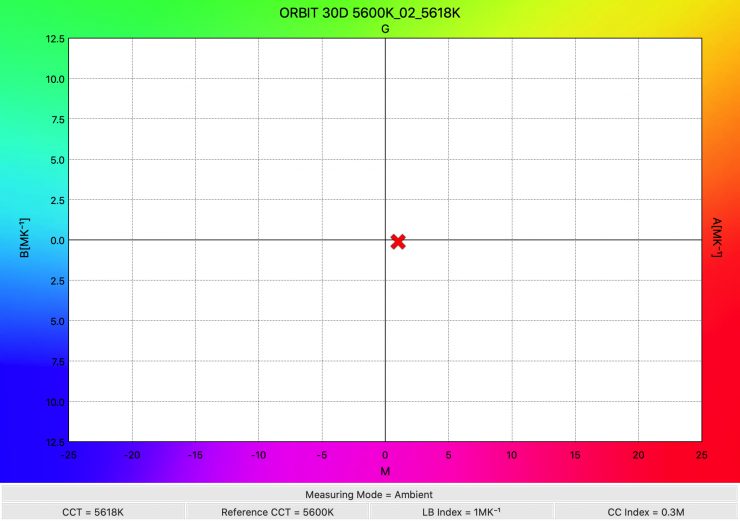
The light recorded a Kelvin color temperature reading of 5618K which was excellent.
3200K (30° Optic/ High CRI mode)
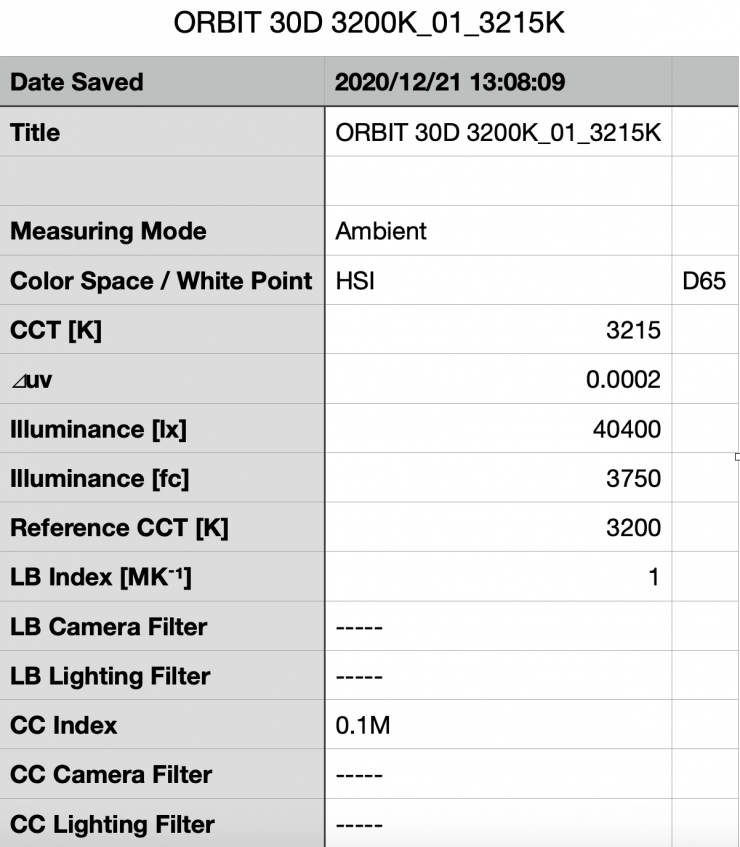
Above you can see the light’s output when it was set at 3200K with the 30° Optic and set to the High CRI mode. It produced 40400 lx (3750 fc), which is 15.1% less than the 41600 lx it produced at 5600K.
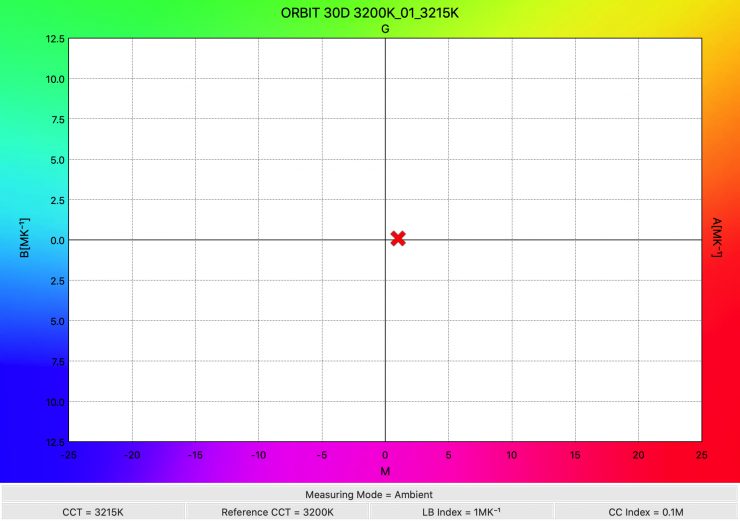
As far as Kelvin color temperature accuracy goes, it recorded an extremely accurate reading of 3215K.
5600K (30° Optic/ High Output mode)
You can change the Orbiter from High CRI to High Output mode. So let’s see how much extra output you get from doing that.
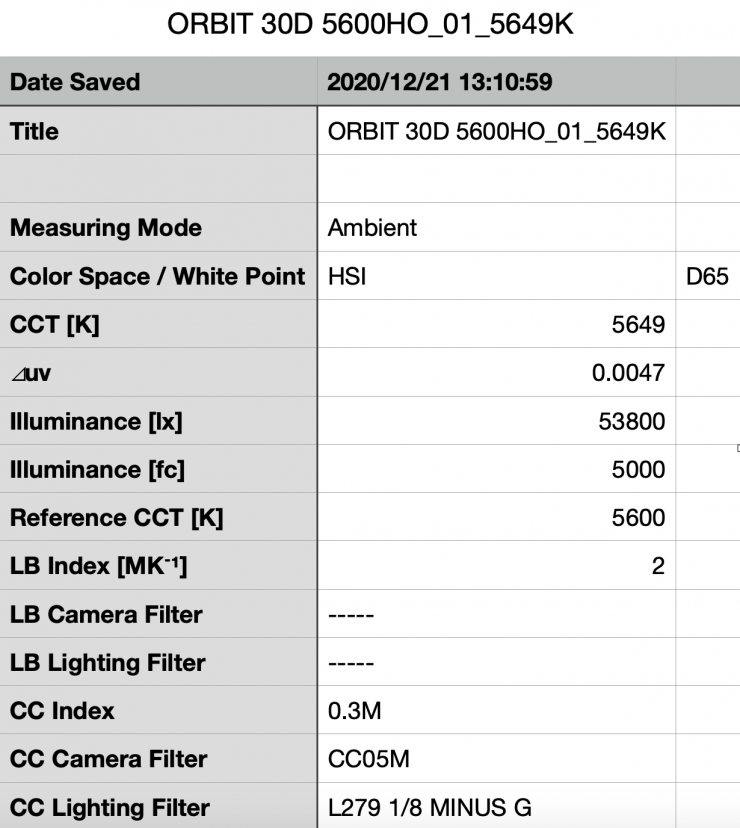
Above you can see the light’s output when it was set at 5600K with the 30° Optic and set to the High output mode. It produced 53800 lx (5000 fc), which is 11.5% more than the 47600 lx it produced at 5600K in the High CRI mode. This is not a dramatic increase, and given the fact that the fan is quite noticeable in the High Output mode users may not find it useful anywhere where audio needs to be recorded.
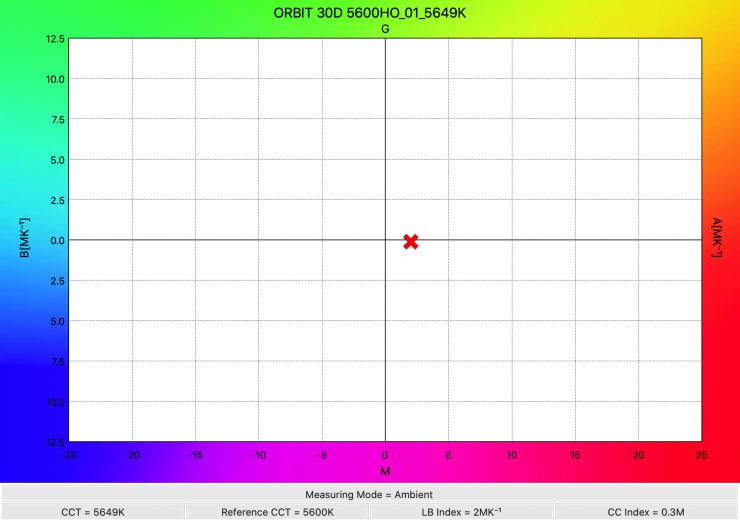
As far as Kelvin color temperature accuracy goes, it recorded a very accurate reading of 5649K. This tells me that the High Output mode doesn’t really alter the Kelvin color temperature in any real noticeable way.
I’m pretty sure ARRI could have gotten even more output from the Orbiter if they were willing to compromise on color accuracy, reliability, and longevity. Lots of LED lights on the market, especially ones utilizing a COB are being driven very hard. Some of these fixtures will end up with reduced longevity and inaccurate Kelvin color temperatures over time.
5600K (30° Optic/ Low Noise mode)
As well as being able to change the Orbiter from High CRI to High Output Mode, you can also set it in a Low Noise mode. So let’s see how or if this affects anything.
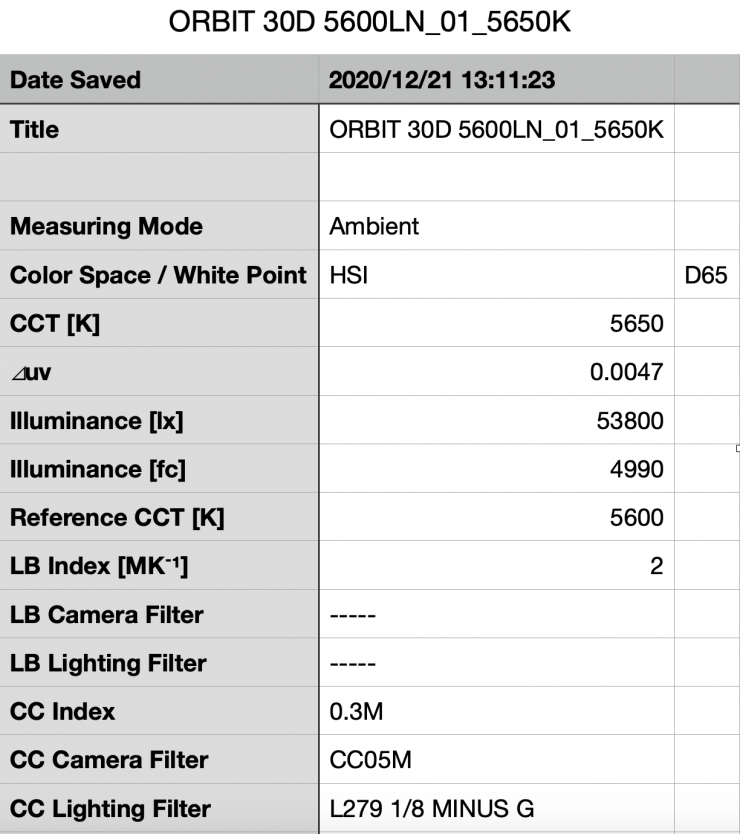
Above you can see the light’s output when it was set at 5600K with the 30° Optic and set to the Low Noise mode. It produced 53800 lx (4990 fc), which is identical to what it produced at 5600K in the High Output mode. This was surprising.
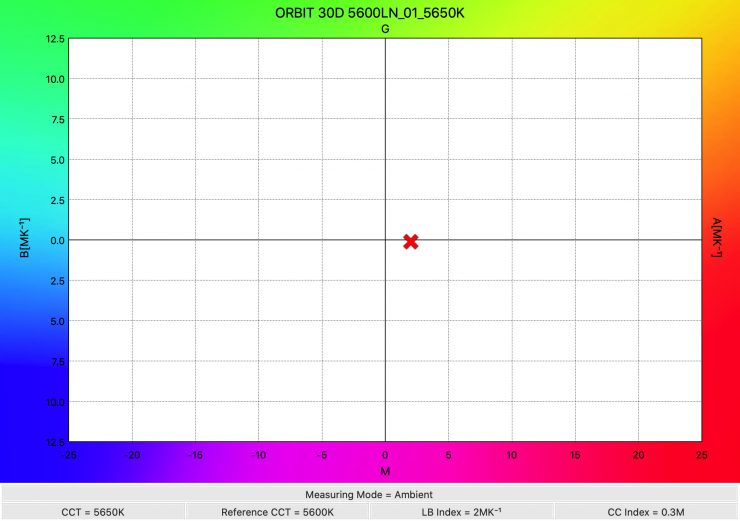
As far as Kelvin color temperature accuracy goes, it recorded a very accurate reading of 5650K. This tells me that the Low Noise mode doesn’t alter the Kelvin color temperature in any real noticeable way.
5600K (30° Optic/High CRI mode) +/- G/M Adjustment
As you can adjust the +/- G/M bias on the Orbiter, I decided to see if I could get even better Kelvin color accuracy by making some adjustments. I set the light at 5500K and set the G/M to -0.15.
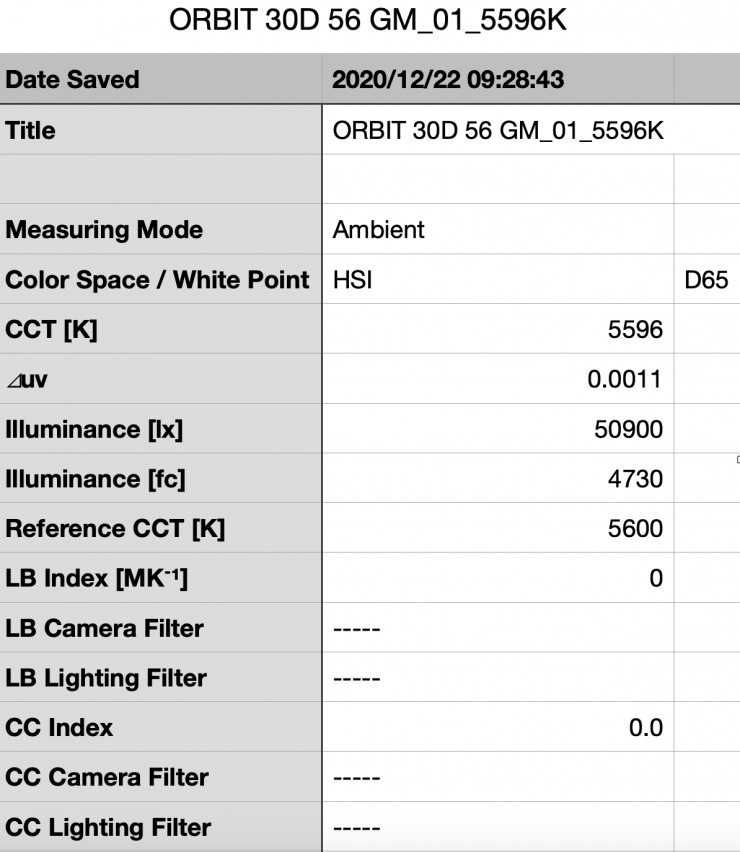
Above you can see the results. The light recorded an exceptionally accurate Kelvin color temperature reading of 5596K and it had a perfect CC Index score of 0.
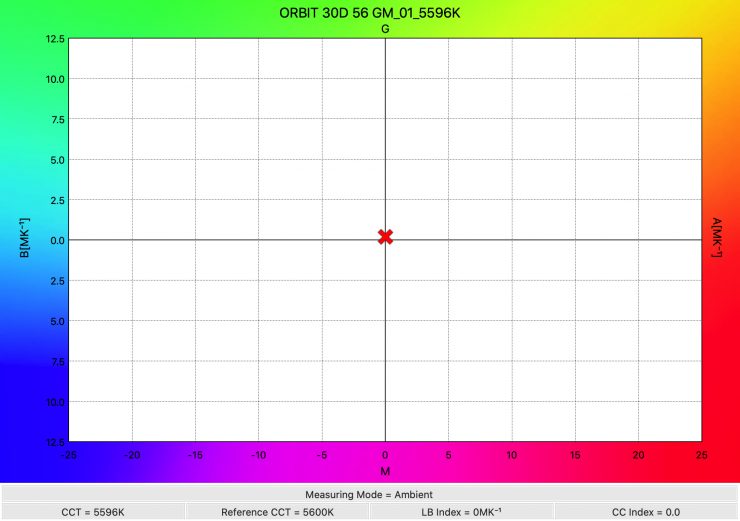
Look at the White Balance data above, it is almost perfect. This is one of the big benefits of being able to adjust the +/- G/M bias of a light. In saying that, just because a light records a perfect score on a meter doesn’t necessarily mean it looks great in real-life scenarios.
Battery Power
5600K (30° Optic/ High CRI mode)
I always like to see what the output of a light is when running off battery power. You shouldn’t just assume it will be identical to that when running off mains power. I tested the light at 5600K with the 30° Optic in the High CRI mode. I powered the Orbiter using the SWIT TD-R210A 24V/48V Light Stand Power Adaptor and two SWIT PB-H290S 290Wh Intelligent Bi-voltage Batteries.
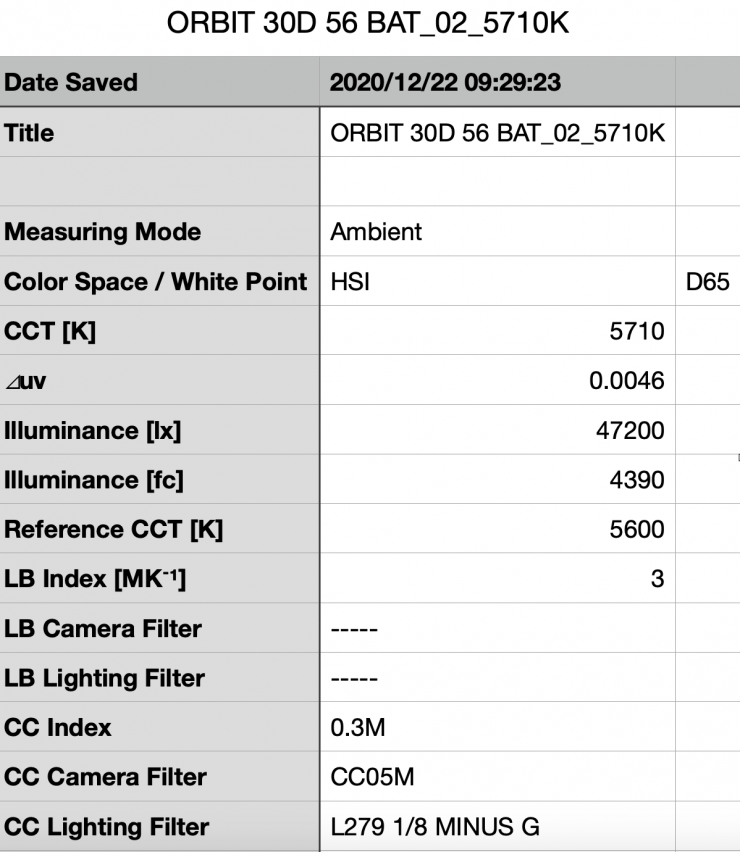
Above you can see the lights output when it was set at 5600K with the 30° Optic in the High CRI mode. It produced 47200 lx (4390 fc), which is just 400 lx less than the 47600 lx it produced at 5600K when run off mains power. This shows me that the light has essentially the exact same output when running off batteries or mains power.
DoPchoice SnapBag Small
5600K (30° Optic/ High CRI mode)
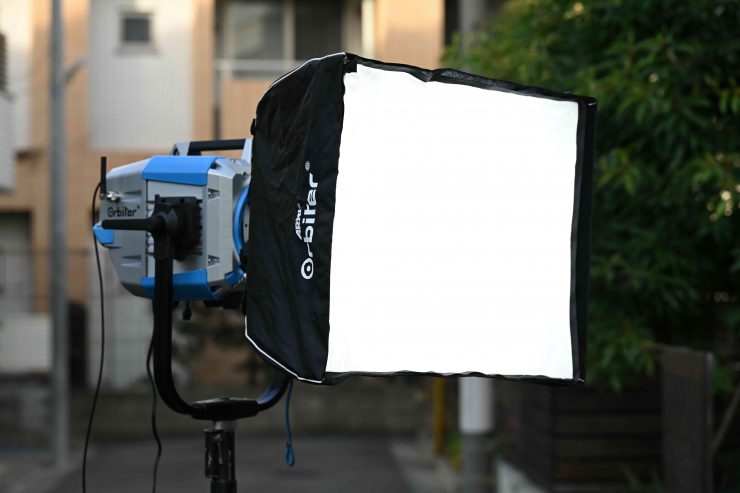
I also tested the light out with the optional DoPchoice SnapBag Small sized softbox to see how much output you lose and if it affected the Kelvin color temperature. The measurement was done 1m from the front of the softbox.
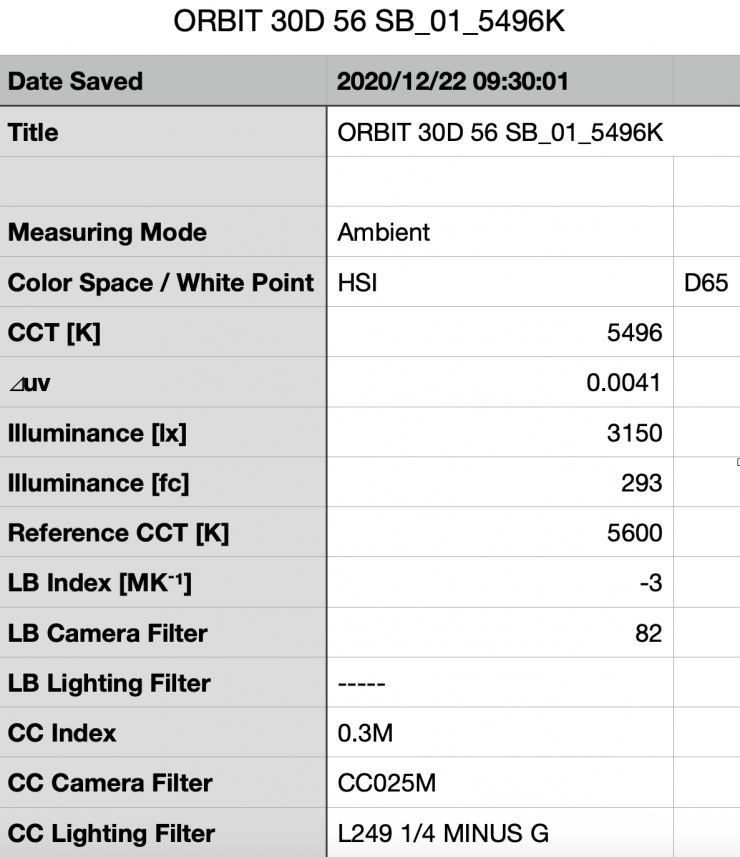
Above you can see the light’s output when it was set at 5600K with the soft box and set in the High CRI mode. It produced 3150 lx (293 fc), which was 96% less than the 47600 lx it produced with the 30° Optic.
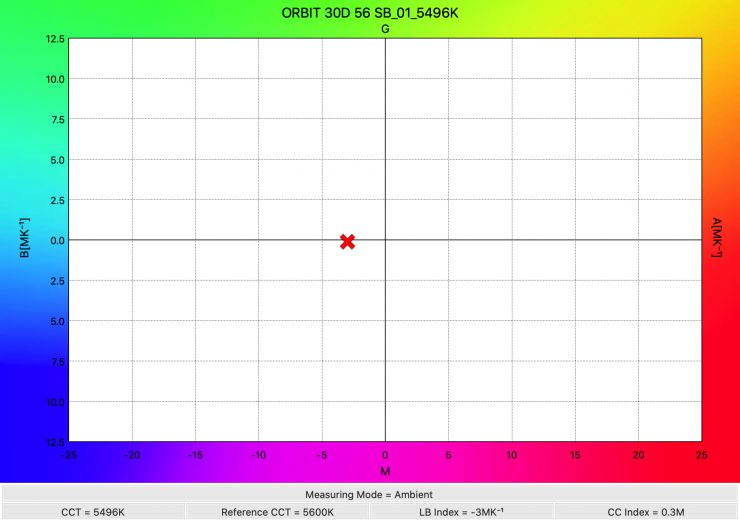
As far as Kelvin color temperature accuracy goes, it recorded a reading of 5496K, which was lower than the 5655K that it recorded when used with 30° Optic.
How does it perform at various Kelvin color temperatures?
Summary of results (30° Optic/ High CRI mode)
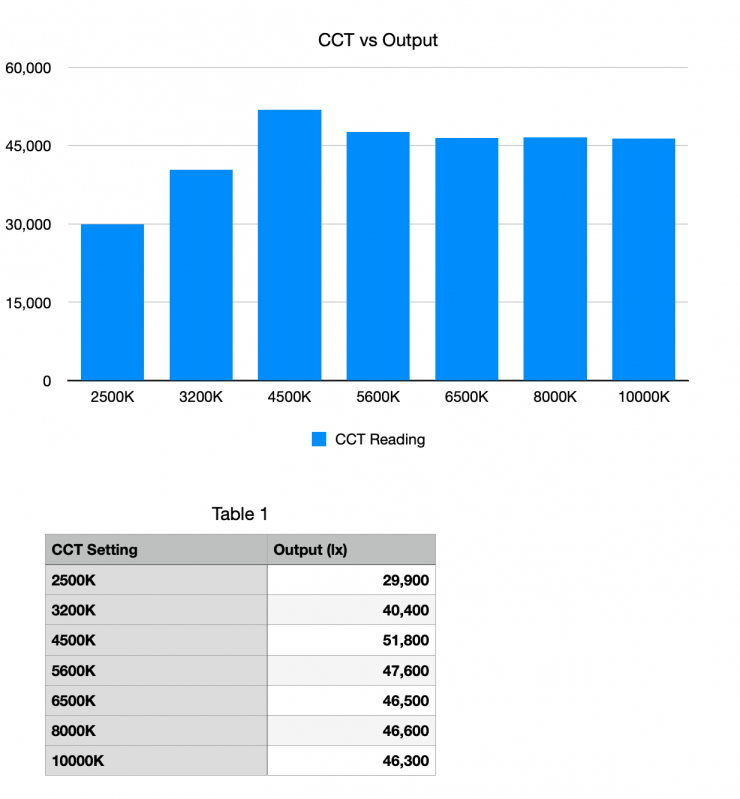
These results show me that the lights output is fairly consistent at most Kelvin color temperatures above 4500K, and that it has the most output when used at 4500K. The output across the 4500K to 10000K range only varies by 11.9%. It was interesting to see that the light doesn’t have as much output once you start getting to around 3500K and below.
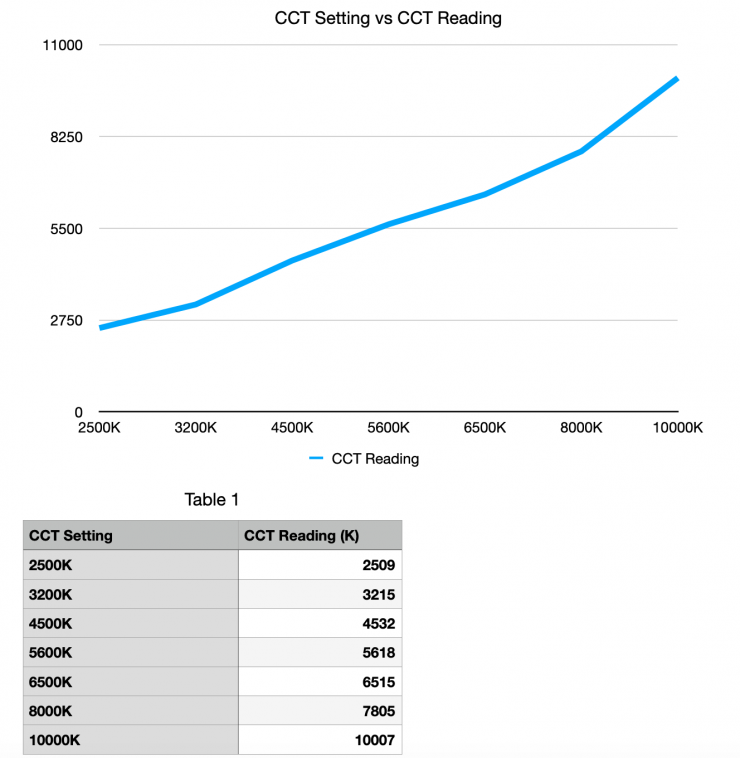
The results also show me that the light is highly accurate when it comes to Kelvin color temperature reproduction throughout its range. It doesn’t matter what Kelvin color temperature you run, the Orbiter is very good throughout its entire range. The light was no more than 32K off being perfect at almost all of its Kelvin color temperature settings that I was able to measure. Only at 8000K was it not as accurate.
The consistency of the Orbiter is very impressive.
What about if you start dimming the light down?
Nobody uses a light at 100% output every time they turn it on. It is important to test the Kelvin color temperature accuracy of a light when it is used at reduced outputs.
I tested the Orbiter at 3200K and 5600K with the 30° Optic in the High CRI mode at a variety of outputs. Below are the results I got:
3200K
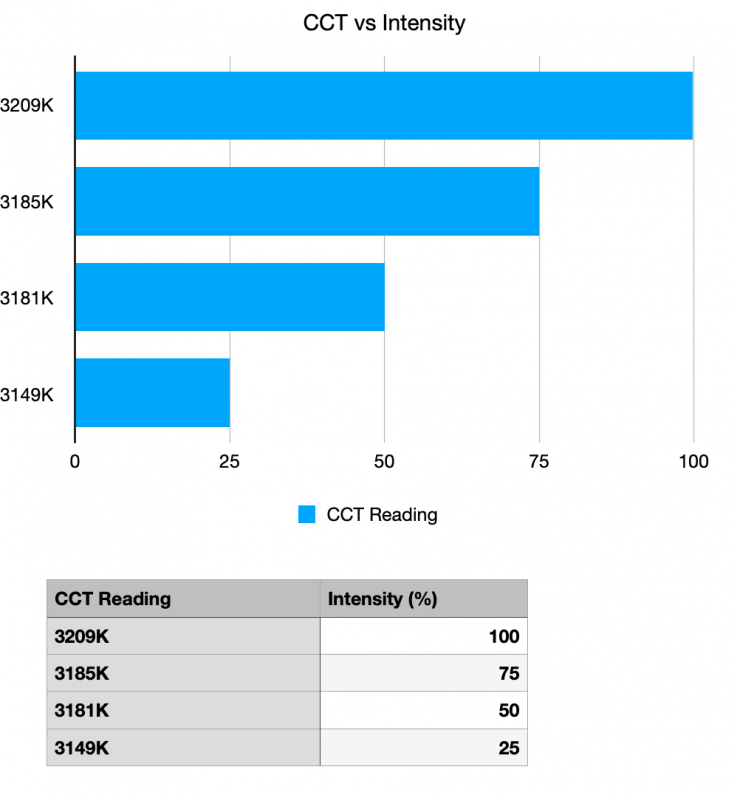
As you can see at 3200K, the Kelvin color temperature remains extremely consistent even once you start dimming the fixture down a long way.
5600K
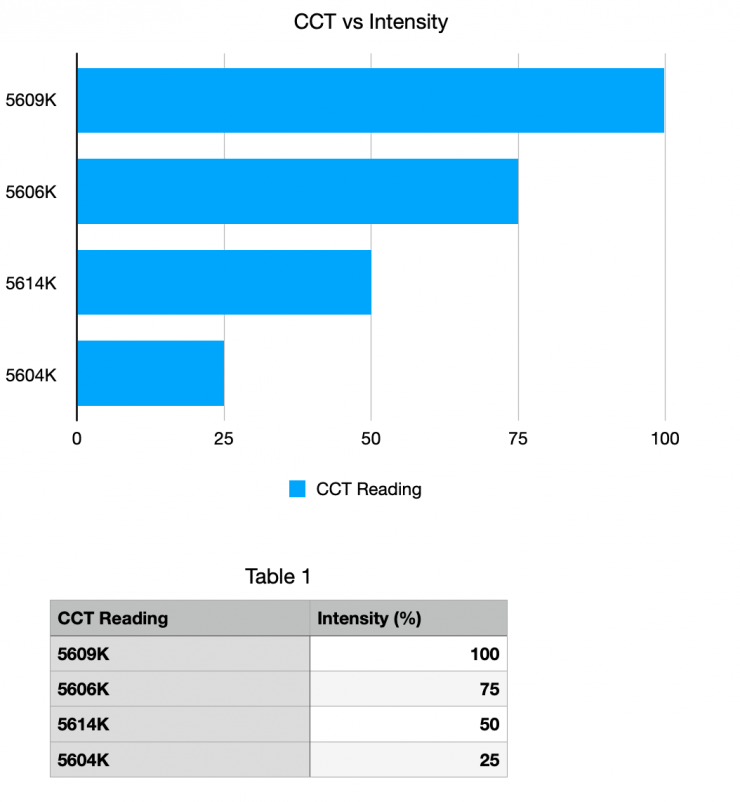
The light’s Kelvin color temperature doesn’t change at all when the Orbiter’s output is dimmed down.
60° Optic
5600K (60° Optic/ High CRI mode)
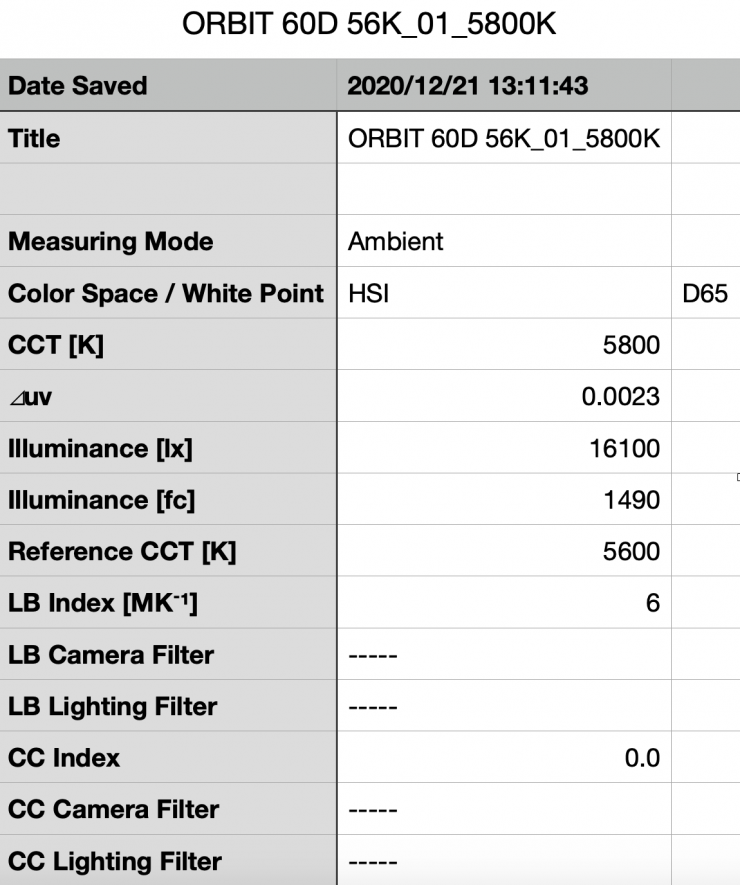
Above you can see the light’s output when it was set at 5600K with the 60° Optic and set to the High CRI mode. It produced 16100 lx (1490 fc), which is 195.6% less than what it produced at 5600K in the High CRI mode with the 30° Optic.
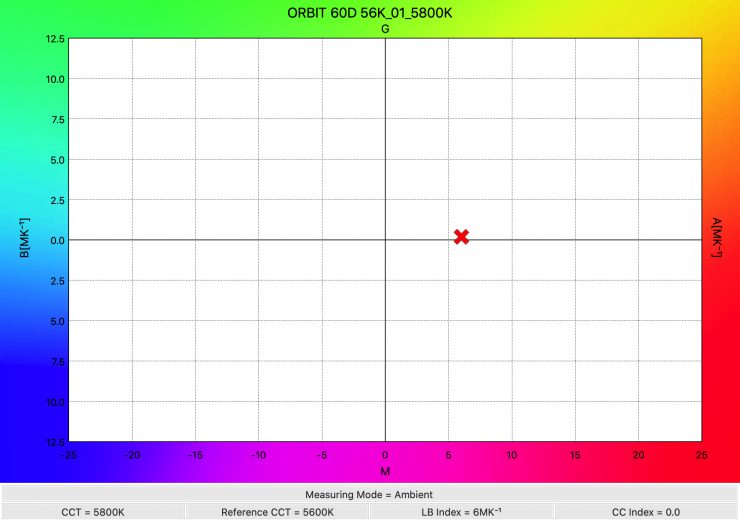
As far as Kelvin color temperature accuracy goes, it recorded a reading of 5800K. This tells me that 60° Optic is slightly affecting the Kelvin color temperature.
3200K (60° Optic/ High CRI mode)
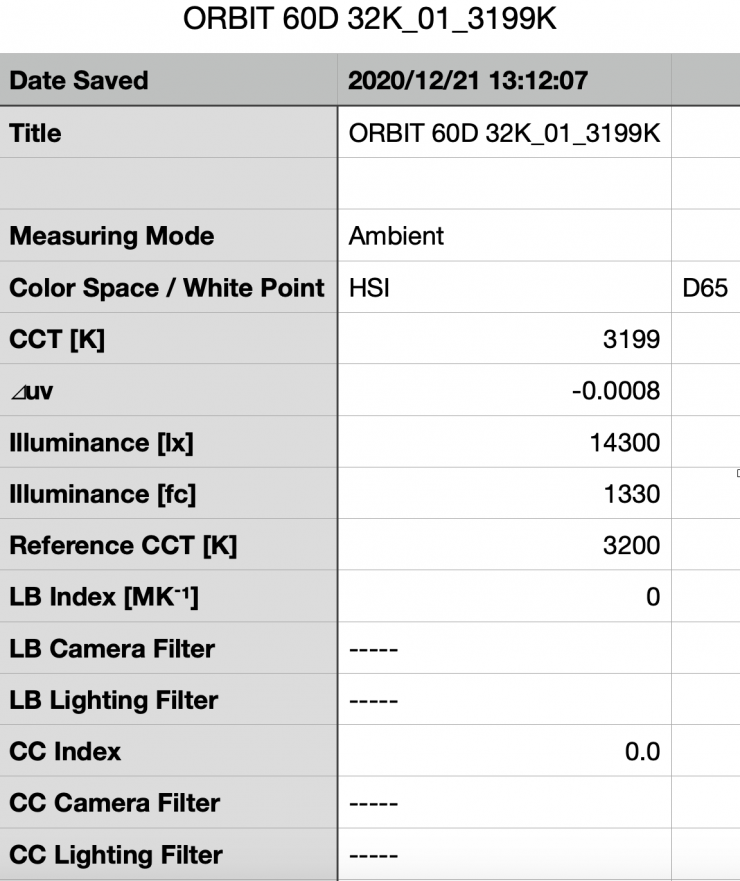
Above you can see the light’s output when it was set at 3200K with the 60° Optic and set to the High CRI mode. It produced 14300 lx (1330 fc), which is 182.5% less than what it produced at 3200K in the High CRI mode with the 30° Optic.
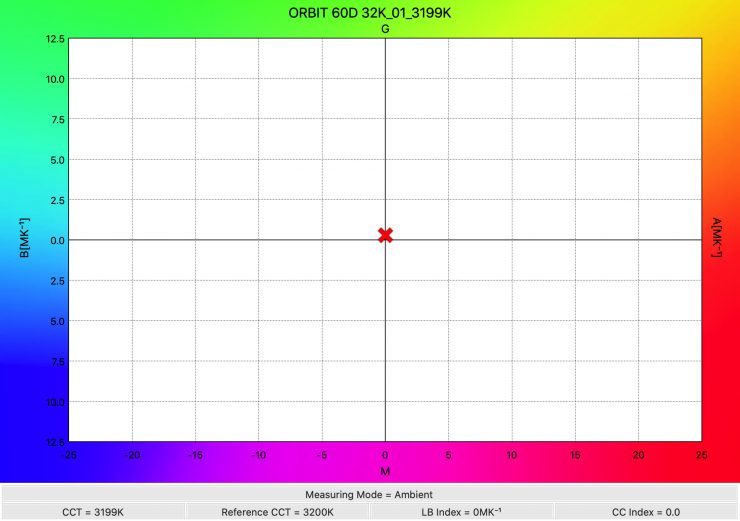
As far as Kelvin color temperature accuracy goes, it recorded an almost perfect reading of 3199K. Interestingly enough the light was more Kelvin color temperature accurate with the 60° Optic at 3200K than it was at 5600K.
5600K (60° Optic/ High Output mode)
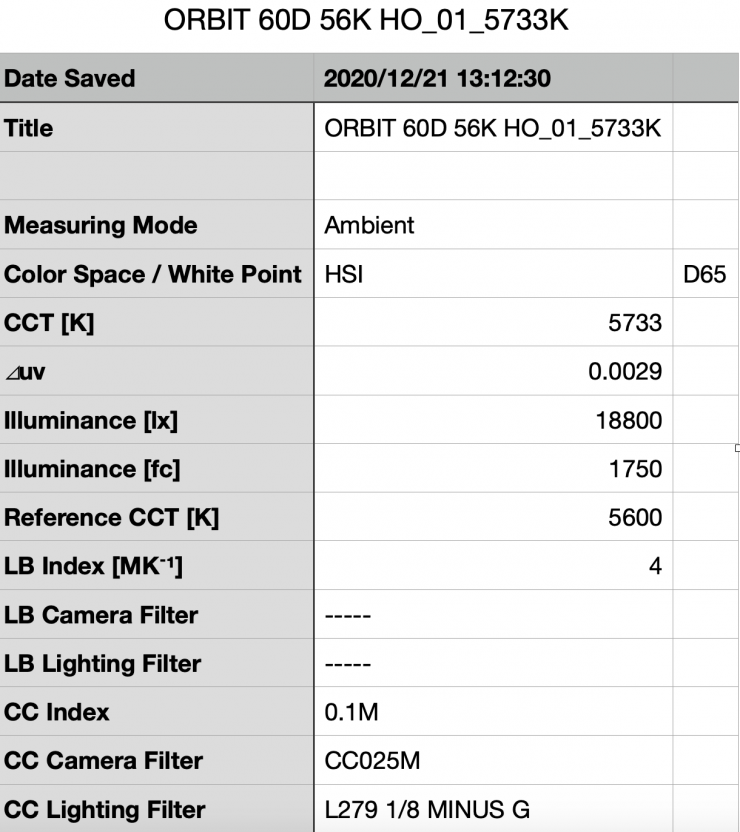
Above you can see the light’s output when it was set at 5600K with the 60° Optic and set to the High Output mode. It produced 18800 lx (1750 fc), which is 16.8% more than what it produced at 5600K in the High CRI mode.

As far as Kelvin color temperature accuracy goes, it recorded a reading of 5800K. This tells me that 60° Optic is slightly affecting the Kelvin color temperature.
15° Optic
5600K (15° Optic/ High CRI mode)
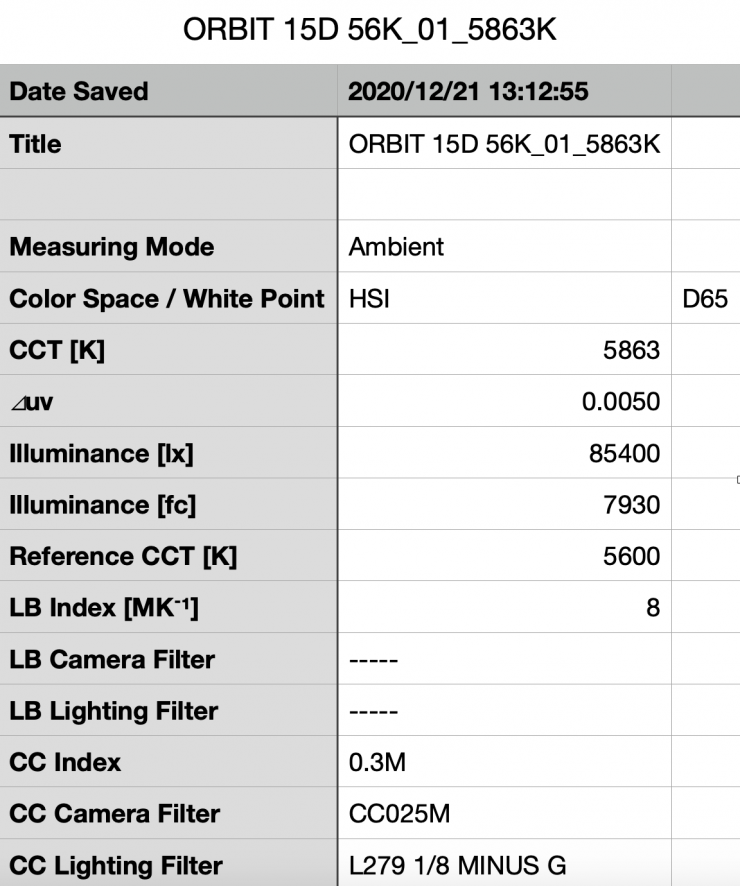
Above you can see the light’s output when it was set at 5600K with the 15° Optic and set to the High CRI mode. It produced 85400 lx (7930 fc). This was 44.2% more than its output at 5600K using the 30° Optic.
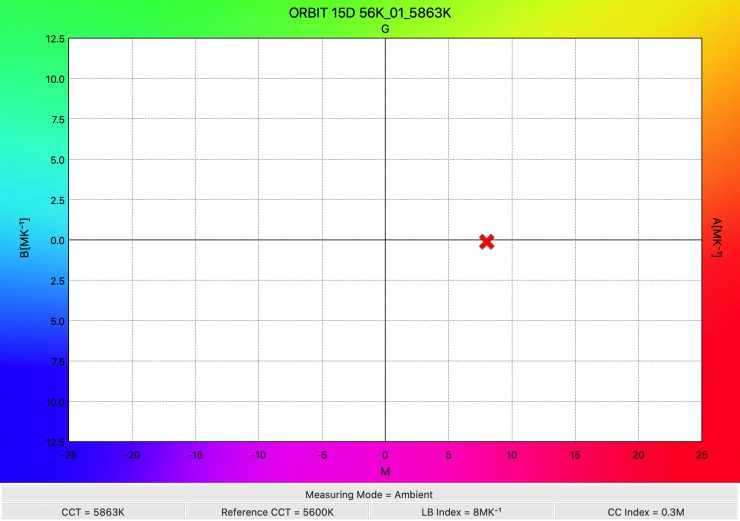
As far as Kelvin color temperature accuracy goes, it recorded a reading of 5863K. This tells me that 15° Optic is slightly affecting the Kelvin color temperature.
3200K (15° Optic/ High CRI mode)
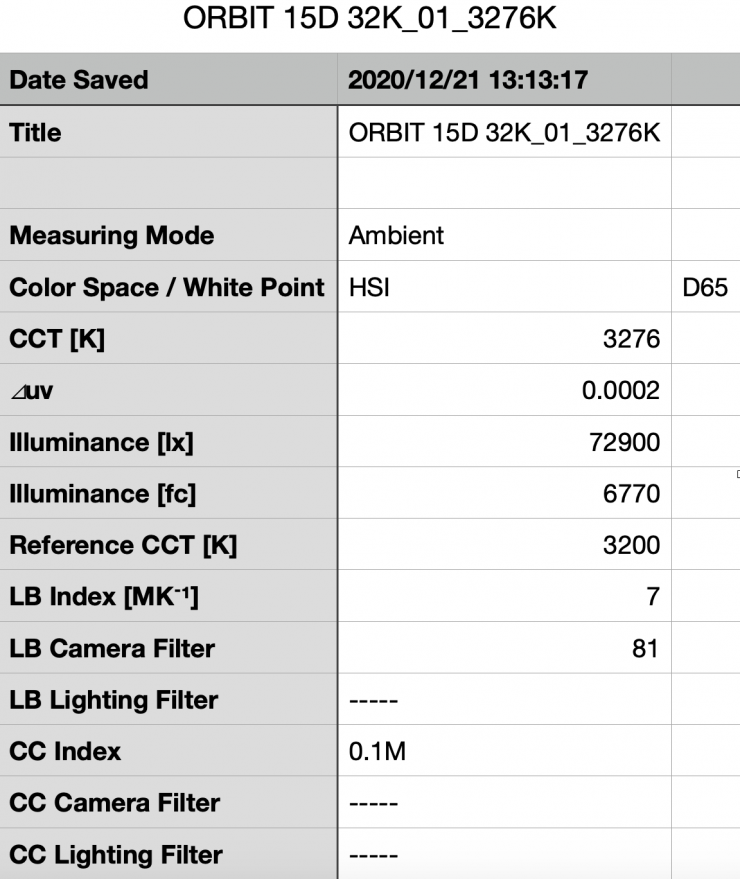
Above you can see the light’s output when it was set at 3200K with the 15° Optic and set to the High CRI mode. It produced 72900 lx (6770 fc). This was 44.6% more than its output at 3200K using the 30° Optic.

As far as Kelvin color temperature accuracy goes, it recorded a reading of 3276K. This tells me that 15° Optic is not really affecting the Kelvin color temperature.
5600K (15° Optic/ High Output mode)
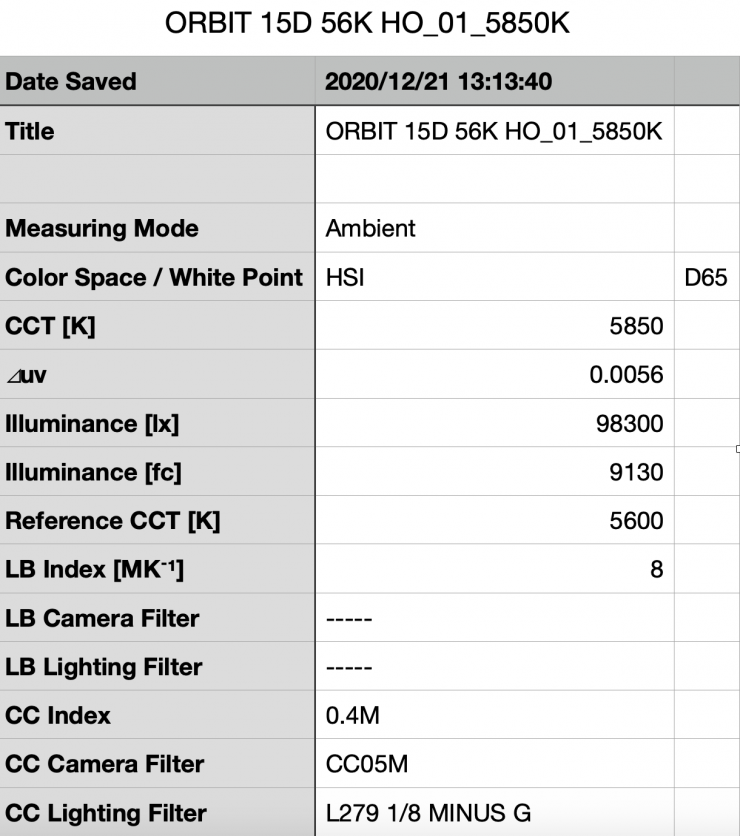
Above you can see the light’s output when it was set at 5600K with the 15° Optic and set to the High Output mode. It produced 98300 lx (9130 fc). This was 13.1% more than its output in the High CRI mode.
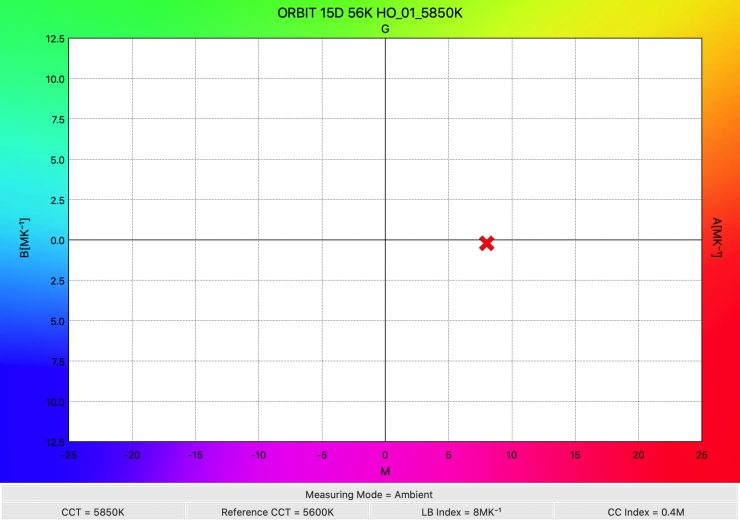
As far as Kelvin color temperature accuracy goes, it recorded a reading of 5850K.
RGB Output
With most RGB lights if you use them to generate or create colors the output gets massively reduced. So how does the Orbiter fare?
I decided to do a test to see how much output the light had when I created a super-saturated color. I set the light at 0° (saturated RED)
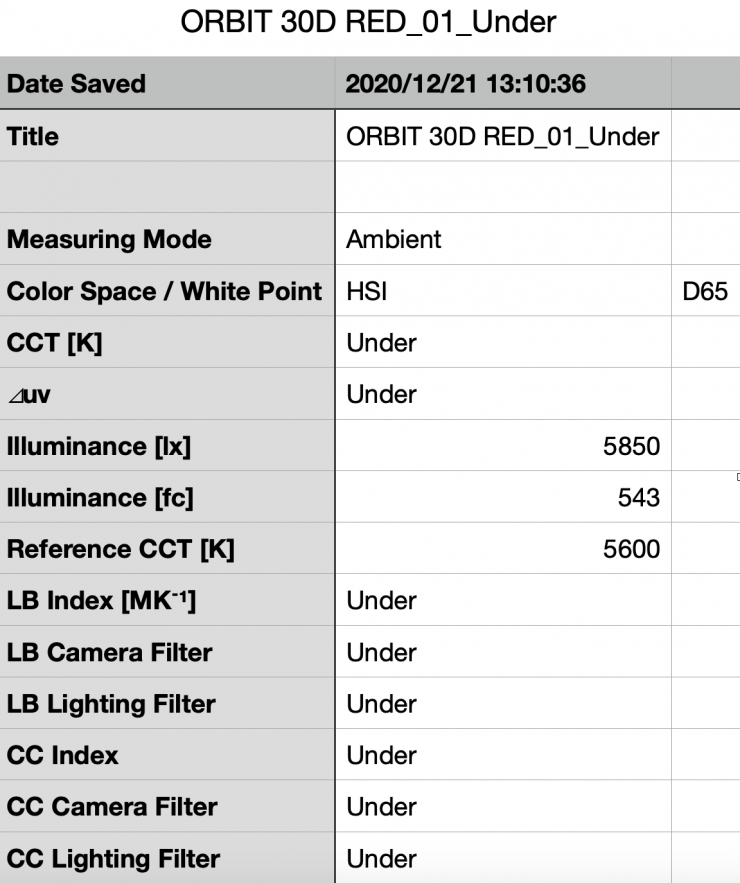
Above you can see that when it was in the HSI mode, choosing a saturated red, and set to 100% output, the light recorded 5850 lx. This is something you need to be clearly aware of when using RGB and HSI modes. The output is going to be significantly lower than when using the light in CCT mode.
How does this output compare to some other fixtures we have reviewed?
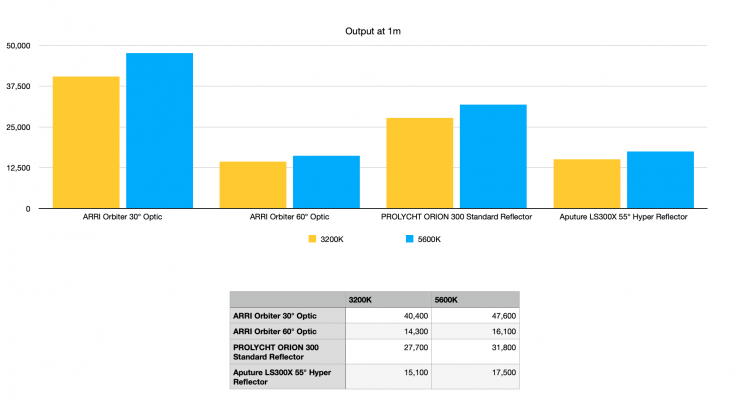
As far as output is concerned, the Orbiter when used with its 60° Optic is pretty compatible to using an Aputure LS300X with its 55° Hyper Reflector.
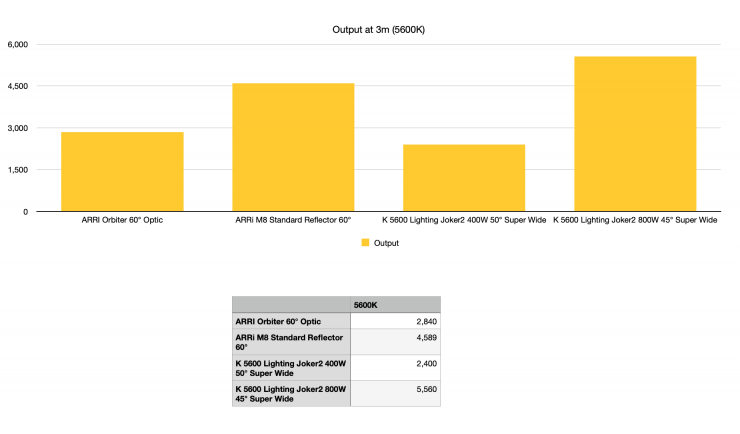
Above you can see how the Orbiter with its 60° Optic compares gainst some HMI fixtures. Please note that the figures for the K 5600 Joker2 fixtures are from slightly tighter beam angles. As you can see, the output of the Orbiter is fairly similar to a K 5600 Lighting Joker 400W.
Color Rendering
5600K (30° Optic/ High CRI mode)
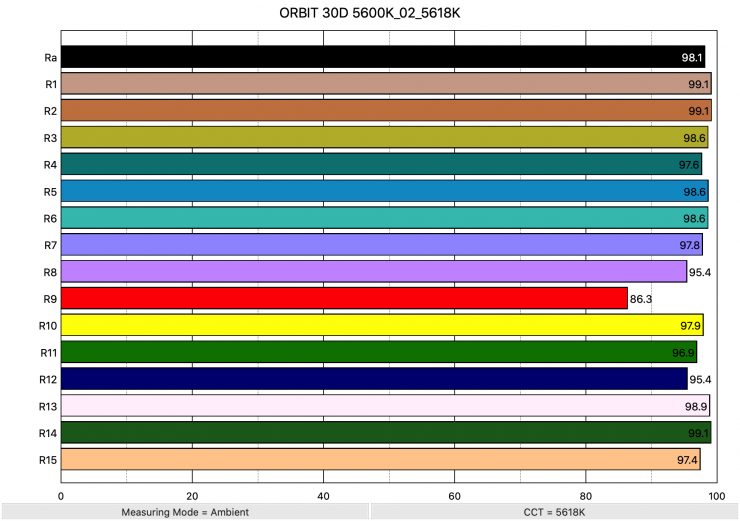
So now that we have seen how much output the Orbiter produces, how does it perform when it comes to replicating accurate color? Above you can see that when the light was set at 5600K using the 30° Optic in the High CRI mode it recorded an average CRI (R1-R8) of 98.1 and an extended CRI (R1-R15) of 97.1. For replicating accurate skin tones it recorded for R9 86.3 (red), 98.9 for R13 (closest to caucasian skin tones), and 97.4 for R15 (closest to Asian skin tones).
These are excellent results. In fact, the extended CRI of 97.1 is the highest figure I have ever seen from any LED fixture being used at 5600K. What is quite remarkable is that ARRI is blending 6 different colors together to create white light. Getting that mix just right isn’t an easy task.
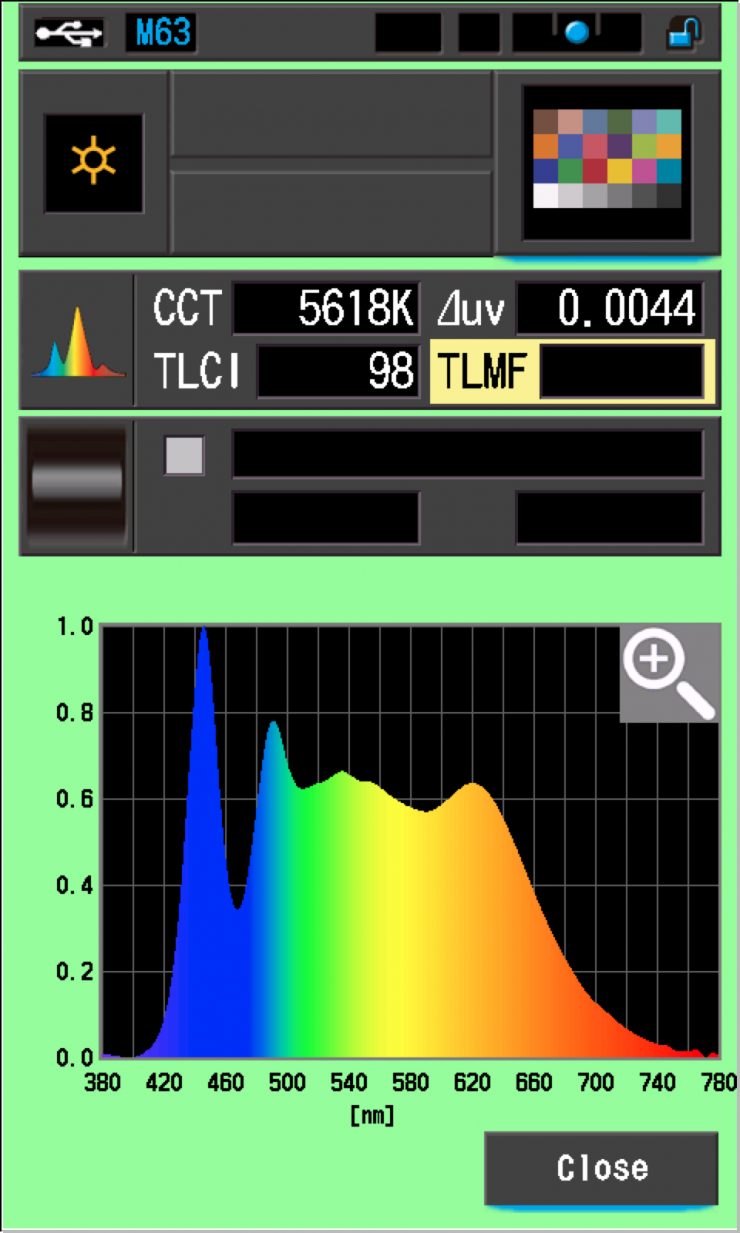
The light, when set at 5600K, recorded a TLCI score of 98.
3200K (30° Optic/ High CRI mode)
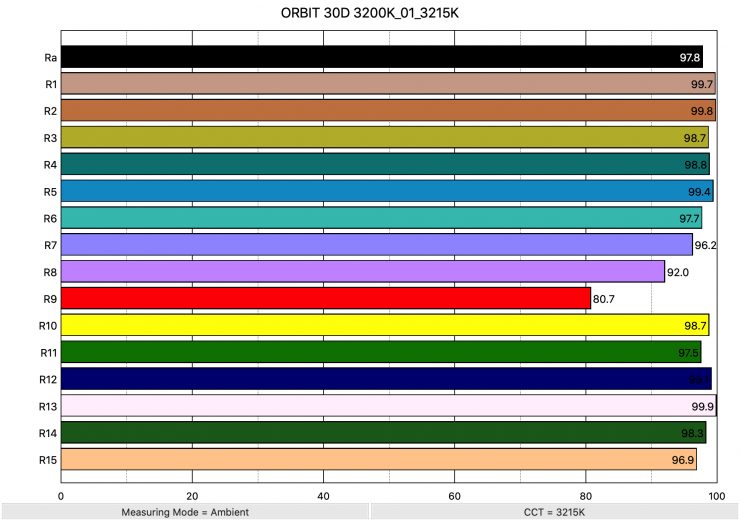
Above you can see the scores for when the light was used at 3200K. It recorded an average CRI (R1-R8) of 97.8 and an extended CRI (R1-R15) of 96.89. For replicating accurate skin tones it recorded 80.7 for R9 (red), 99.9 for R13 (closest to caucasian skin tones), and 95.9 for R15 (closest to Asian skin tones).
These results were outstanding and the light performs just as well as 3200K as it does at 5600K.
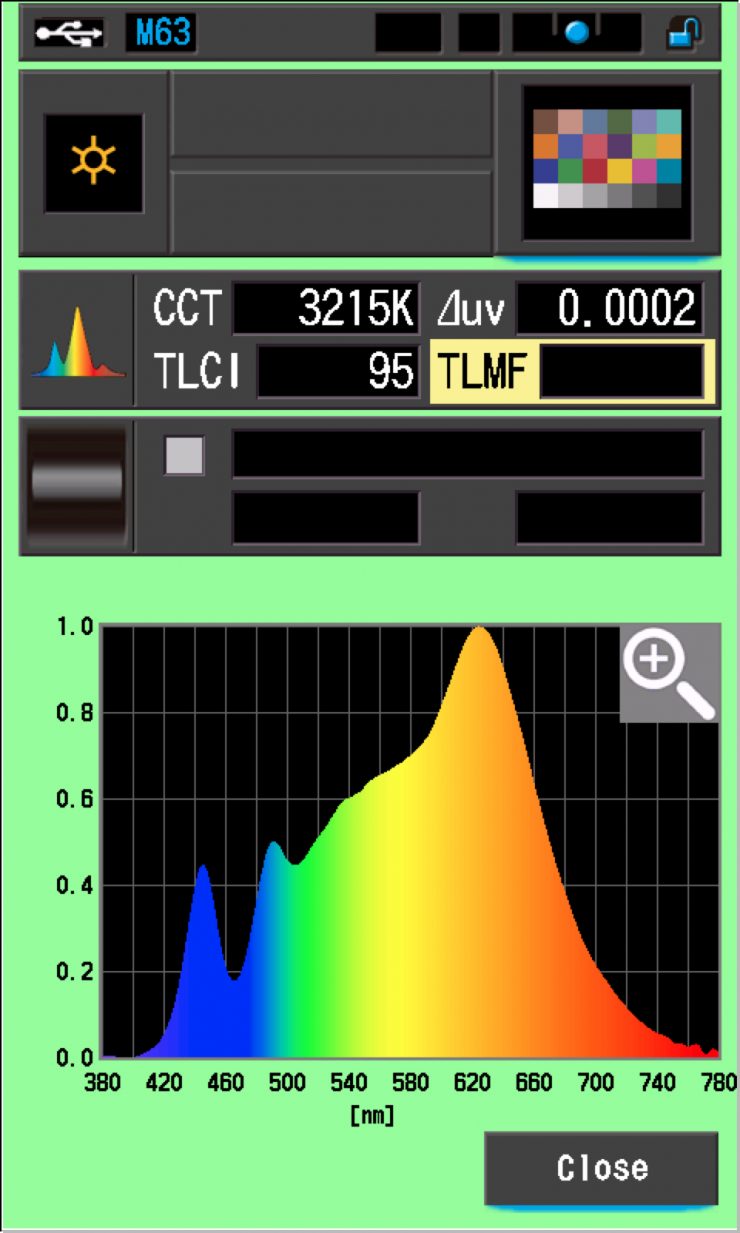
The light, when set at 3200K, recorded a TLCI score of 95.
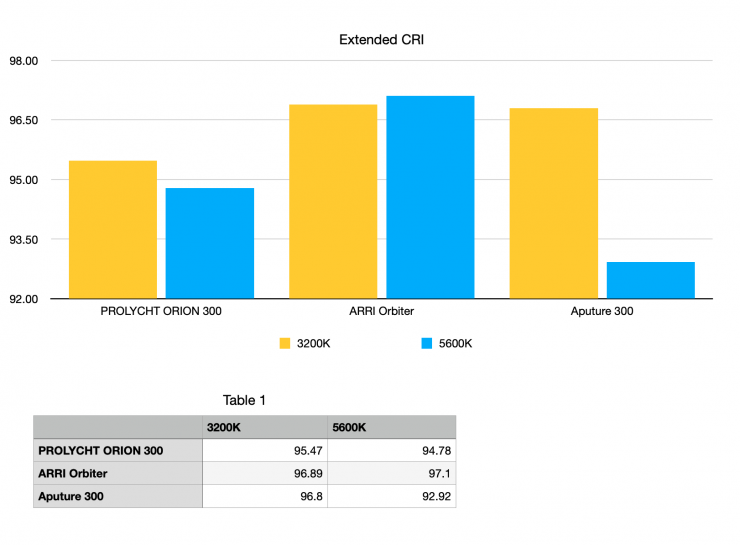
So how do these results compare to something like a Prolycht Orion 300 and an Aputure LightStorm LS300X? Above you can see that the Orbiter outperforms both of these lights when it comes to color rendering, however, the scores from all three of these lights are very good.
5600K (30° Optic/ High Output mode)
I was interested to see if the color rendering scores were any different when setting the Orbiter in the High Output mode.
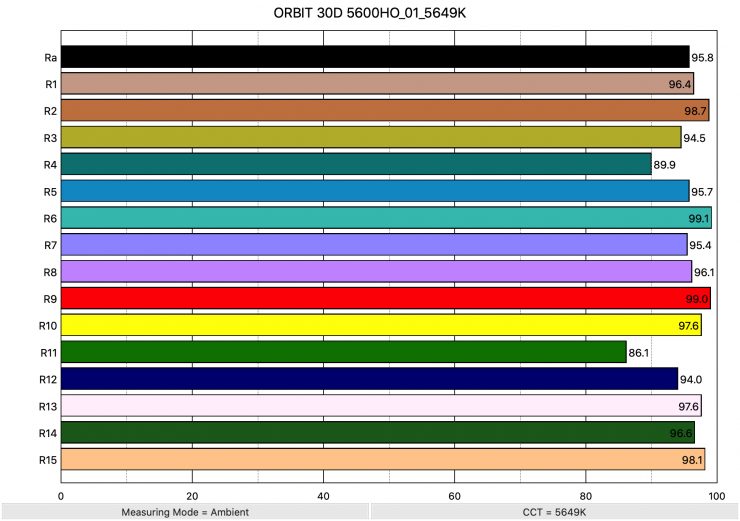
Above you can see the scores for when the light was used at 3200K with the soft box. It recorded an average CRI (R1-R8) of 95.8 and an extended CRI (R1-R15) of 95.65. For replicating accurate skin tones it recorded 99 for R9 (red), 97.6 for R13 (closest to caucasian skin tones), and 98.1 for R15 (closest to Asian skin tones).
These results were not quite as good as when using the light in the High CRI mode, however, they are still very good results.
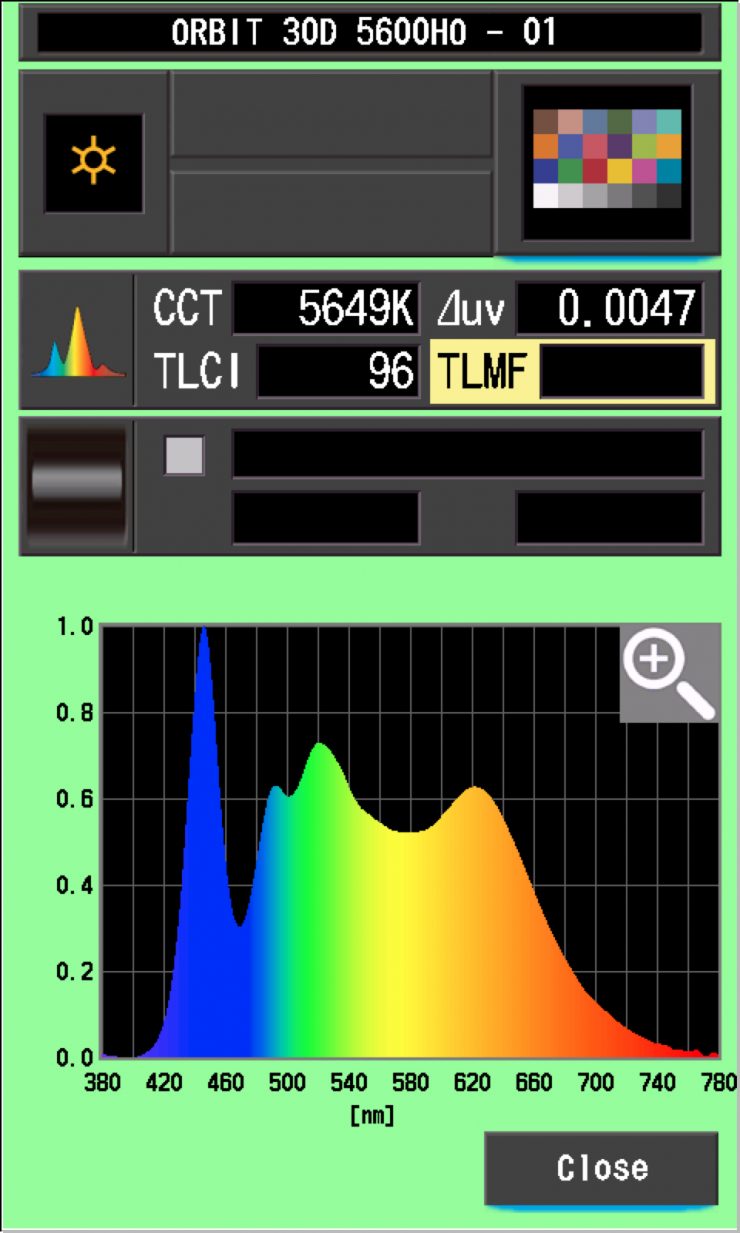
The light, when set at 3200K, recorded a TLCI score of 96.
5600K (30° Optic/ Low Noise mode)
So What changes, if anything, if you set the Orbiter to the Low Noise mode?
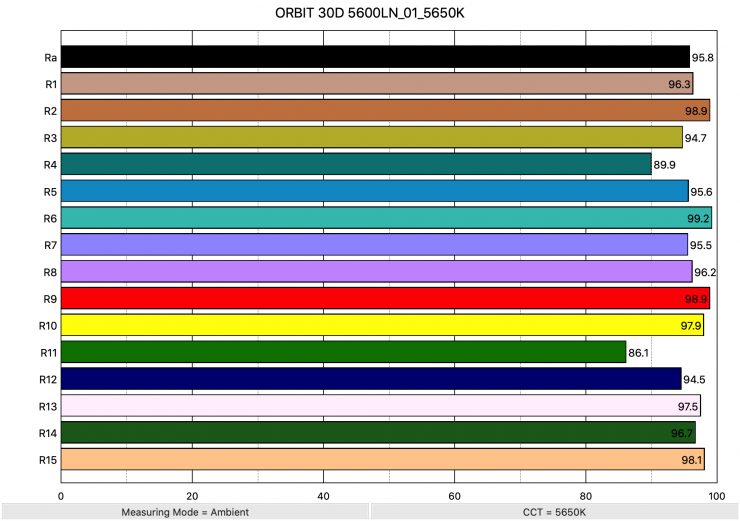
Above you can see the scores for when the light was used at 5600K with the soft box. It recorded an average CRI (R1-R8) of 95.8 and an extended CRI (R1-R15) of 95.73. For replicating accurate skin tones it recorded 98.9 for R9 (red), 97.5 for R13 (closest to caucasian skin tones), and 98.1 for R15 (closest to Asian skin tones).
These results were again excellent. ARRI has obviously set some standards with the Orbiter where they weren’t willing to compromise on the light’s color accuracy.
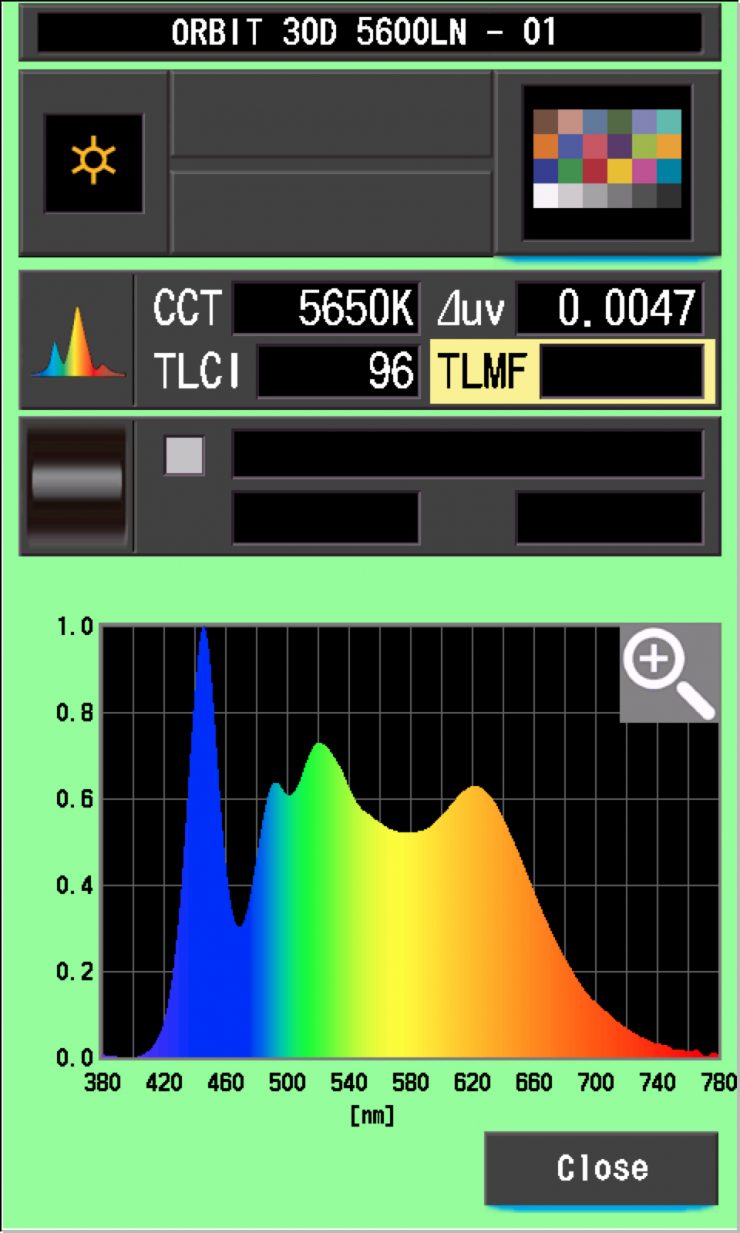
The light, when set at 5600K in the Low Noise mode, recorded a TLCI score of 96.
CC Index & ⊿uv
The CC Index displays the CC correction value and whether any magenta or green need to be added or subtracted. 1 CC corresponds to 035 Kodak CC values or 1/8 Rosco filter values. Any reading less than +1.00 or -1.00 and you’re probably not going to need to make any kind of adjustment. The ⊿uv is the value to show how much this light is away from being an ideal light source (black body radiation = incandescent lamp). As with the CC Index you want this number to theoretically be zero. Kelvin is not a linear value, so we need to convert from Kelvin to MK-1 to compare the values of color temperature. To calculate from Kelvin to Mired is MK-1= 1*1000000/Kelvin. While this may sound confusing, it is the only way of measuring if the Kelvin shift is significant enough to warrant having to use a filter for correction. Below are the results for the ARRI Orbiter when using the (30° Optic/ High CRI mode) :
Kelvin Vs MK-1
| Kelvin | Difference in K | MK-1 | Difference in MK-1 | |
| SET VALUE | 2500K | 0 | 400 | 0 |
| ACTUAL READING | 2509K | 9 | 398.56 | -1.44 MK-1 |
| SET VALUE | 3200K | 0 | 312.5 | 0 |
| ACTUAL READING | 3215K | 15 | 311.04 | -1.46 MK-1 |
| SET VALUE | 4500K | 0 | 222.22 | 0 |
| ACTUAL READING | 4532K | 32 | 220.65 | 1.57 MK-1 |
| SET VALUE | 5600K | 0 | 178.57 | 0 |
| ACTUAL READING | 5618K | 18 | 177.99 | -0.58 MK-1 |
| SET VALUE | 6500K | 0 | 153.84 | 0 |
| ACTUAL READING | 6515K | 15 | 153.49 | -0.35 MK-1 |
| SET VALUE | 8000K | 0 | 125 | 0 |
| ACTUAL READING | 7805K | 195 | 128.12 | 3.12 MK-1 |
| SET VALUE | 10000K | 0 | 100 | 0 |
| ACTUAL READING | 10007K | 7 | 99.93 | -0.07 MK-1 |
These figures might look confusing, but what it tells me is that the light is extremely Kelvin color accurate at all temperatures. Any MK-1 score that is under -9/9 means you wouldn’t have to use any color correction gels. The MK-1 scores for this light were exceptionally good. At 5600K and 6500K, the Orbiter has close to perfect Kelvin Vs MK-1 scores.
CC INDEX & ⊿uv
| CC INDEX | ⊿uv | |
| 2500K | 0.1G | 0.0002 |
| 3200K | 0.1M | 0.0002 |
| 4500K | 0.3M | 0.0026 |
| 5600K | 0.3M | 0.0044 |
| 6500K | 0.1M | 0.0043 |
| 8000K | 0.1G | 0.0041 |
| 10000K | 0.4G | 0.0044 |
Again, these scores are exceptionally good. The consistency of the Orbiter is certainly what makes it stand out from a lot of other lights.
SSI
SSI (Spectral Similarity Index) was developed by the Sci-Tech Council of the Academy. SSI gives me the ability to set any light as a standard, or use predefined standards (such as CIE D55), and then give other lights an SSI score based upon how well they will match standards such as CIE D55. This way I can measure spectral response and compare it directly against an ideal light source. This is actually a much better test than recording CRI scores.
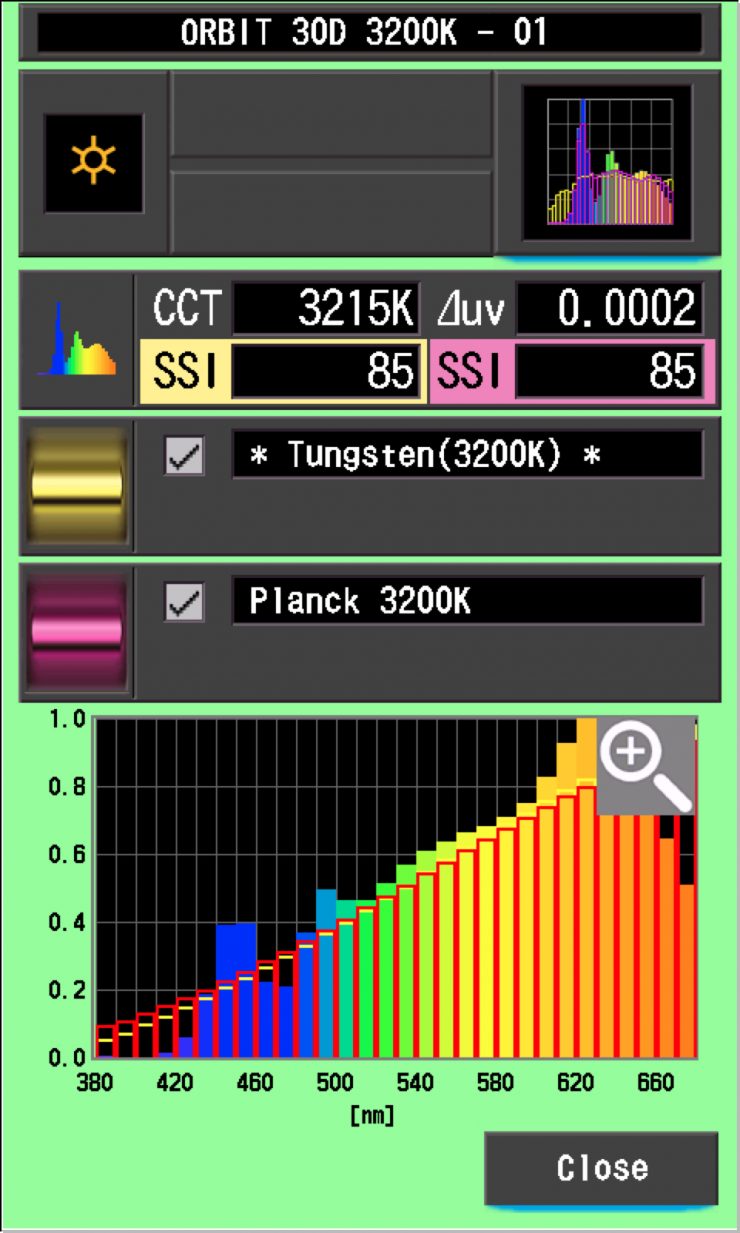
In this graph, the red bars indicate a perfect Planck 3200K source. The gold bars indicate a perfect 3200K Tungsten source. This lets us compare how close to a perfect 3200K lighting source the Orion 300 is. Any SSI score in the high 70’s, low ’80s is very good for a 3200K LED light. The Orbiter scored in the mid 80’s which is the highest I have seen from any LED light used at 3200K. As you can see, LED lights have a hard time replicating colors below about 450nm.
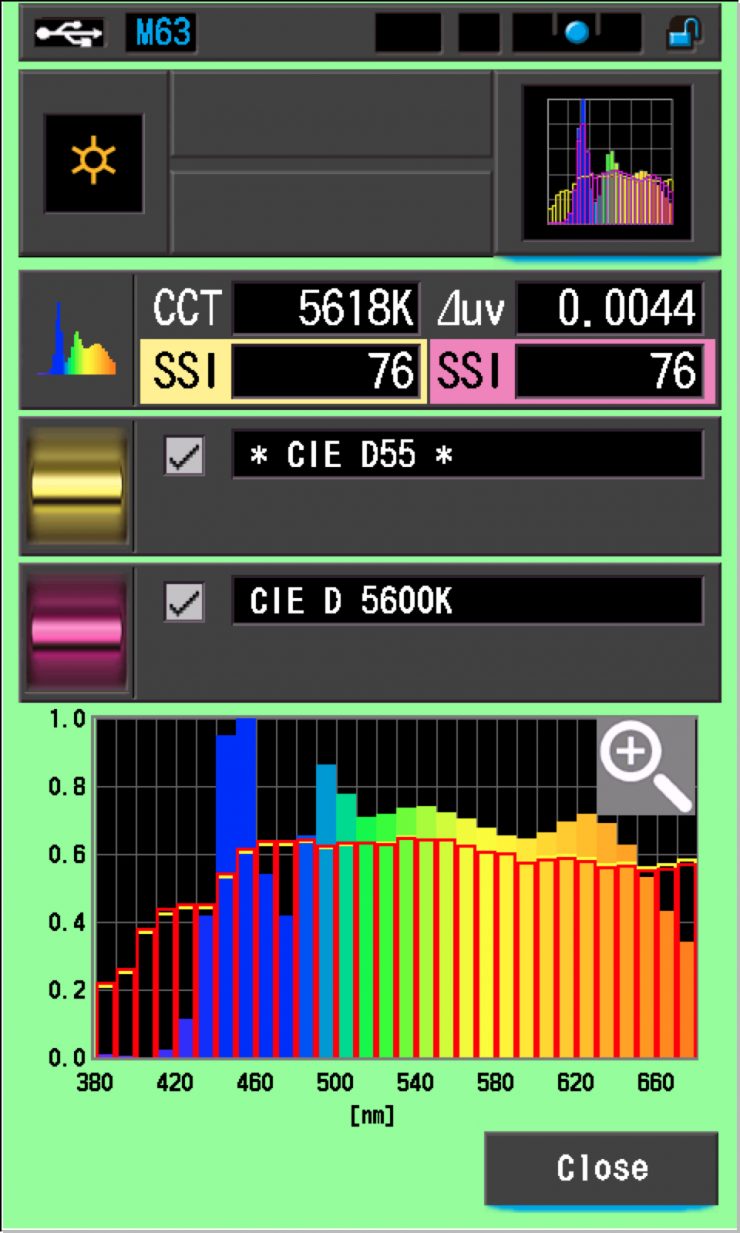
In the graph above the gold bars indicate a perfect CIE D55 source. The red bars indicate a perfect CIE D 5600K source. This lets us compare how close to a perfect 5600K lighting source the Orion 300 is. A score in the low 70’s is typical for a 5600K LED source. A score in the mid to high 70’s is outstanding.
The main reason we want to record SSI scores is so we can see how well they match with other lights. As an example, I wanted to see how well the Orbiter matched the PROLYCHT Orion 300 and the Luxli Fiddle. Below you can see the results.
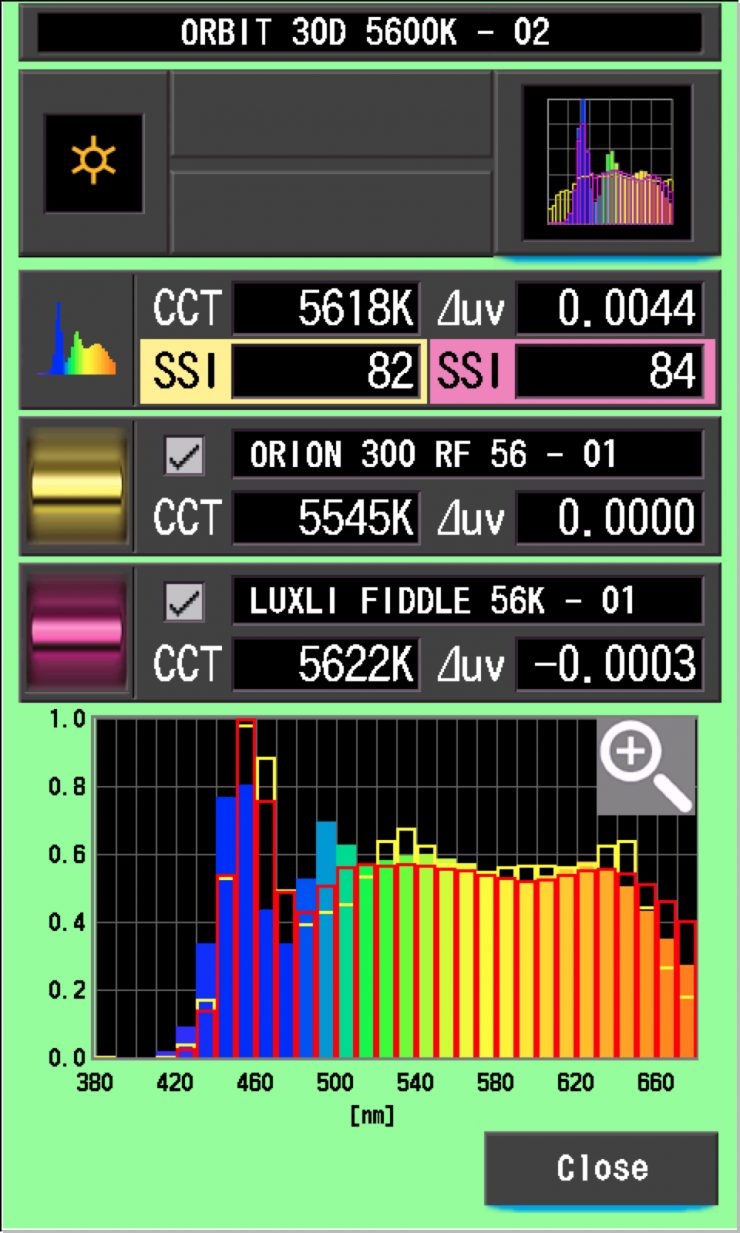
As you can see neither lights are a perfect match to the Orbiter, but you could potentially fine-tune the lights to try and get them to match more closely.
As another test, I thought I would compare those same lights against the Orbiter at 5600K. Below you can see the results.
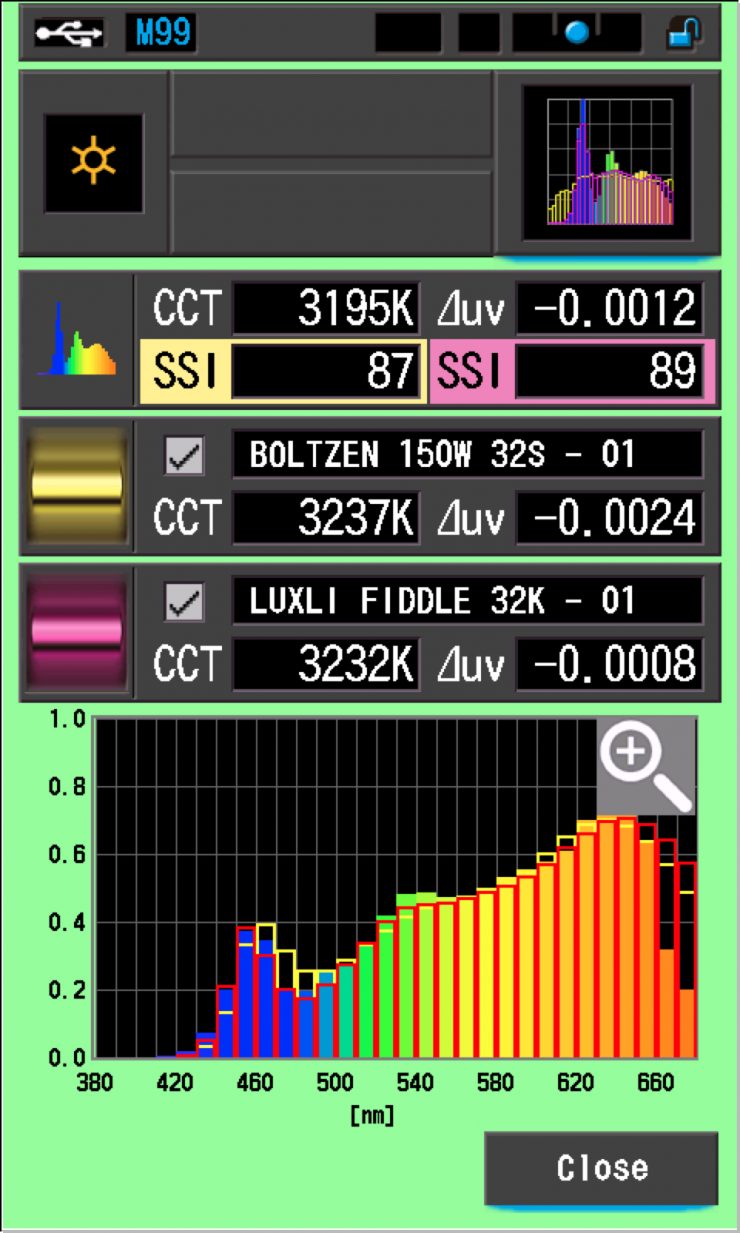
As you can see, both lights had similar scores, but again, they weren’t that close to matching the Orbiter. In saying that, very few lights from different manufacturers are ever going to be an exact match.
SSI tests are a great way of telling you what lights you own or use will work well together.
Spectral Distribution
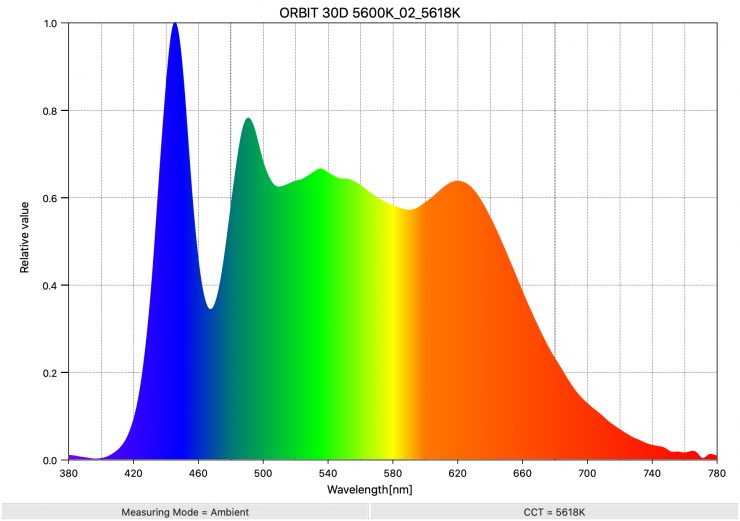
Above you can see the spectral distribution of the Orbiter when it is set at 5600K. The spectral distribution is very full, but you can see a green spike.
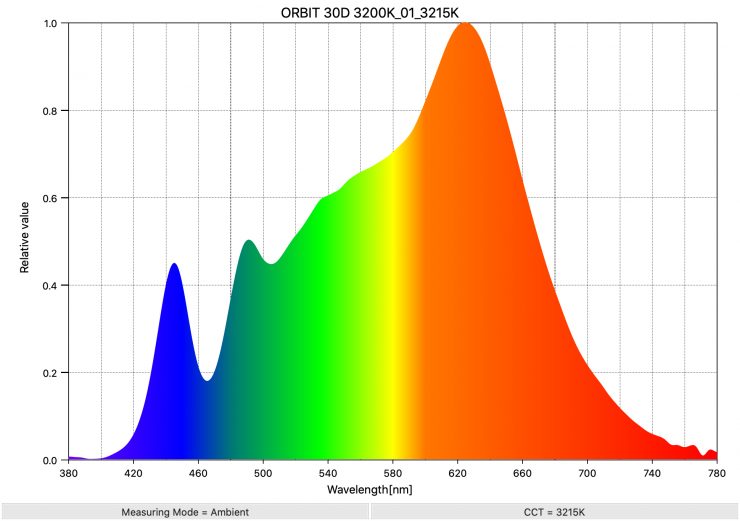
Above you can see the spectral distribution of the Orbiter when it is set at 3200K. The spectral distribution is very full, but it has a slight push towards green. With +/- Green adjustment you could easily correct this.
Real-World Performance & Quality of Light
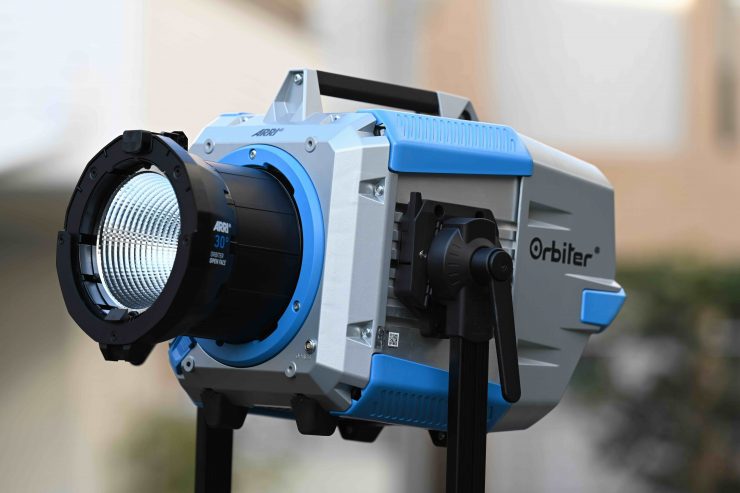
As I always say, photometric scores only tell you part of the story. So let’s find out if the scores from the Orbiter translate into good real-world performance.
The quality of the light that is coming from the Orbiter is really nice, but like any fixture, how you use it is more important than what it can do.
Unfortunately, it is very hard at the moment with the Coronavirus for me to showcase the strengths of the light. I live in Japan in an apartment so there isn’t a lot of space to do much testing. I have still tried to do as much as possible, I apologize that I can’t do more!

It is very easy to create a very soft, flattering light source using the Orbiter in combination with a softbox, or by indirectly bouncing it. Above you can see some quick examples using the Orbiter with a DoPchoice Octa 4 softbox.


Orbiter On 
Orbiter Off
As far as output is concerned, above you can see an example of the light being used with the 30° optic outdoors to try and match a hot background. The subject was around 2m from the Orbiter.
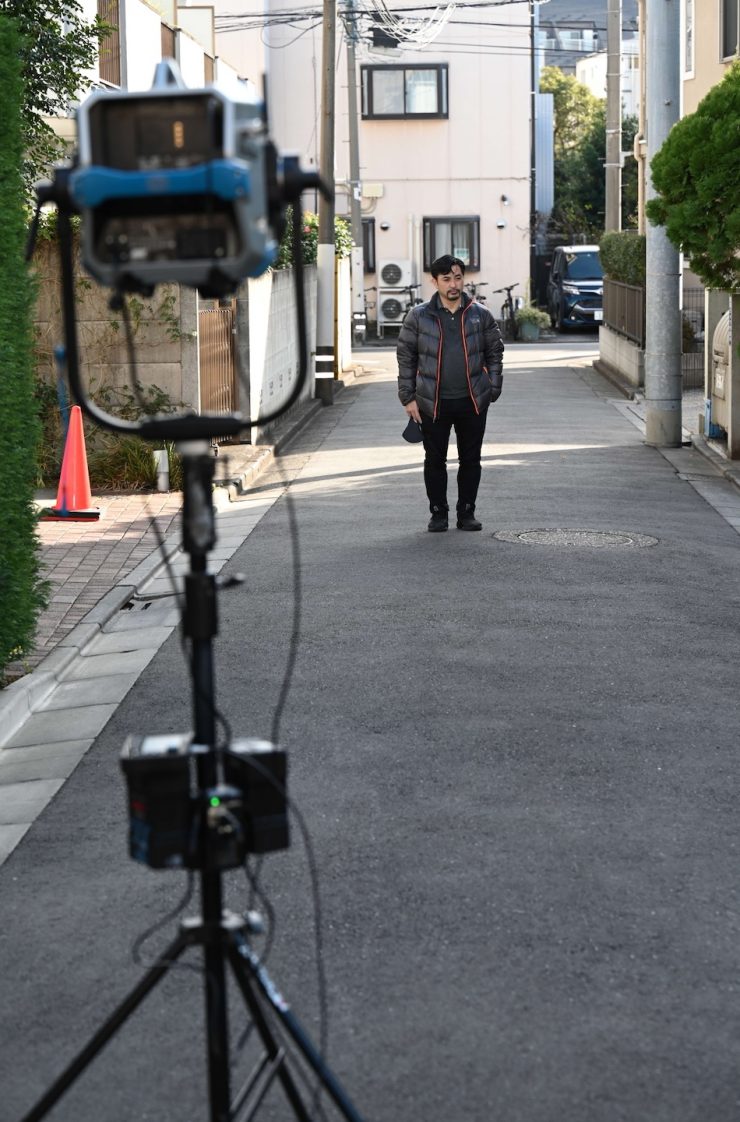
I also tried using the 15° optic outdoors to illuminate my subject at a distance of around 5m (16.4′).


Orbiter On 
Orbiter Off 
Orbiter On 
Orbiter Off
Above you can see what it looks like. As you can see, the light is capable of helping match brighter backgrounds at distances.

Above you can see what the Orbiter looks like outdoors using the DoPchoice Large SnapBag with the Magic Cloth removed.

Above you can see what the Orbiter looks like when using the DoPchoice Medium Lantern.

With the DoPchoice Octa 4 softbox, you can create some really soft light. Above you can see that even with me standing within 75cm of the wall behind me there are very soft shadows being created. You can also see that even if I put my hand up in front of my face, you are not seeing any harsh shadows on my face.
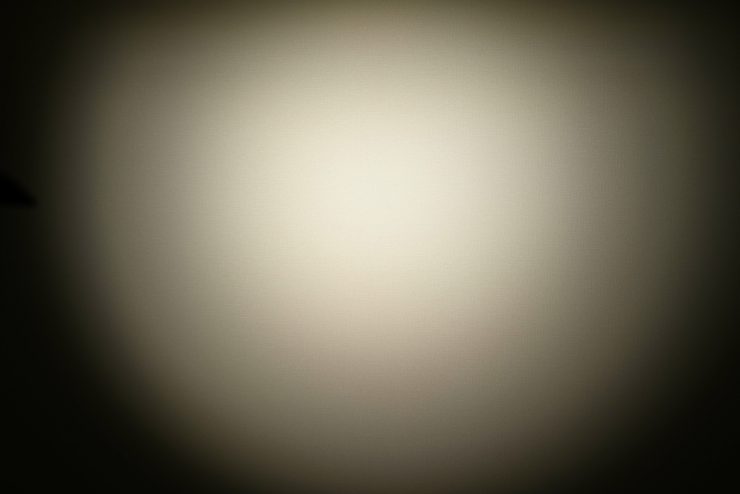
I did find that with the 15° optic attached that you will get a hot spot. There is also some slight color fringing on the edges.

If you use the optional barn doors with the 15° optic attached and you try and close them up too much you do end up getting a strange pattern where you can see the individual LED colors on the edges. This is a little hard to see in the above photo.
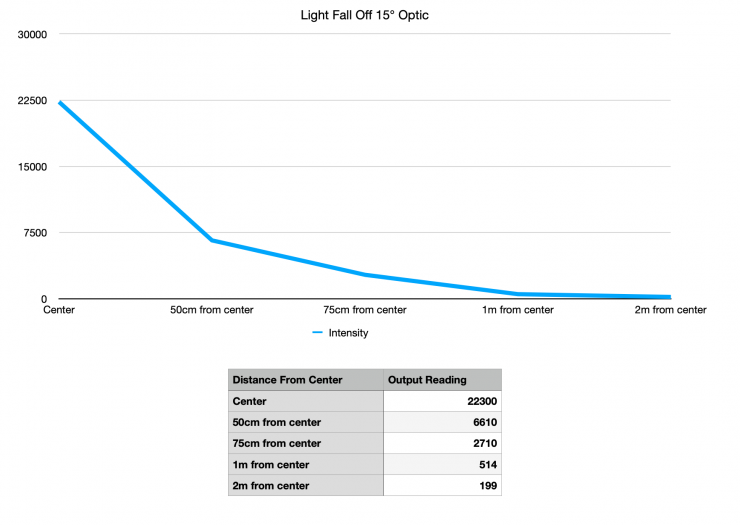
Above you can see measurements I took at a distance of 3m using the 15° optic. Here I wanted to see how linear the fall off was as you move out from the center of the beam. As you can see from the data, there is a definite hotspot in the middle. From about 50cm to 1m from the center of the beam the fall-off is quite linear.
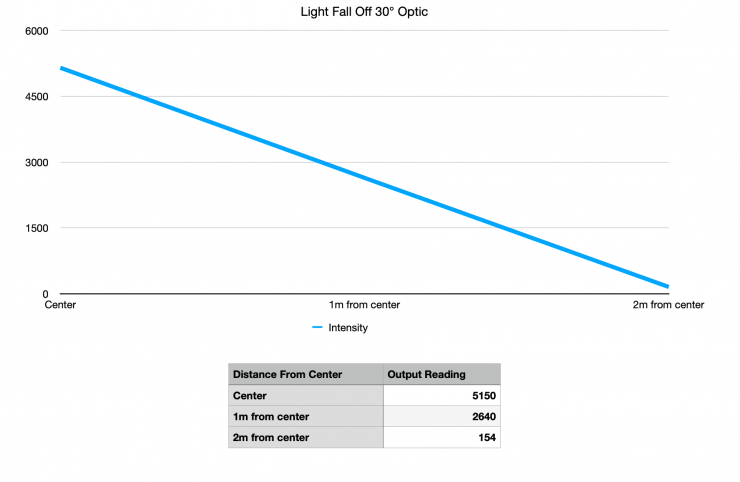
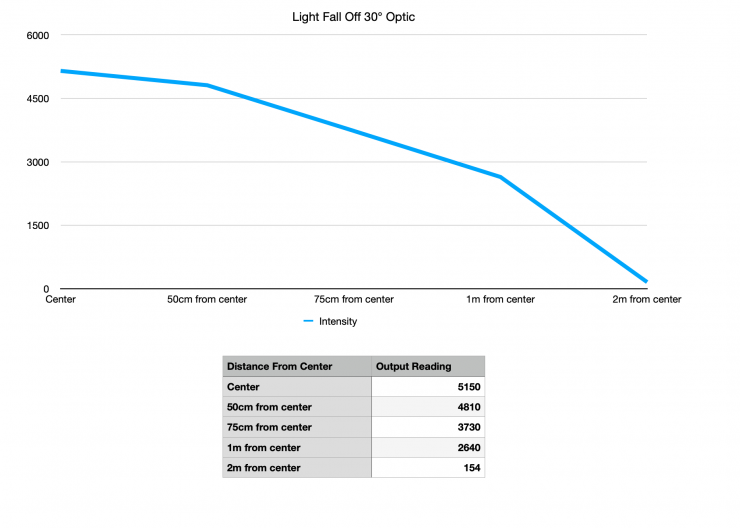
With the 30° optic there aren’t any hot spots and the fall-off is very linear from the measurements I did.
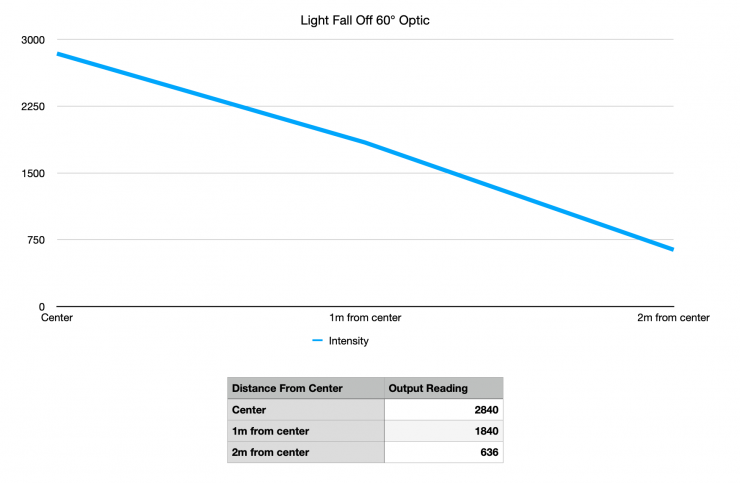
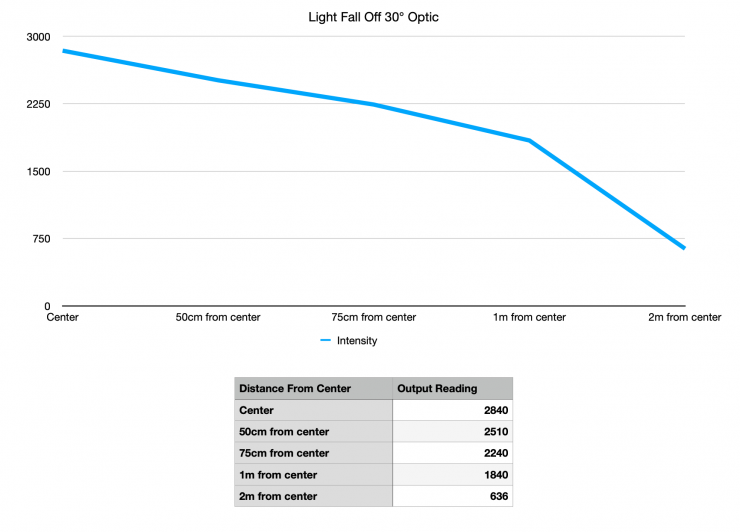
With the 60° optic there aren’t any hot spots and the fall-off is very linear from the measurements I did.
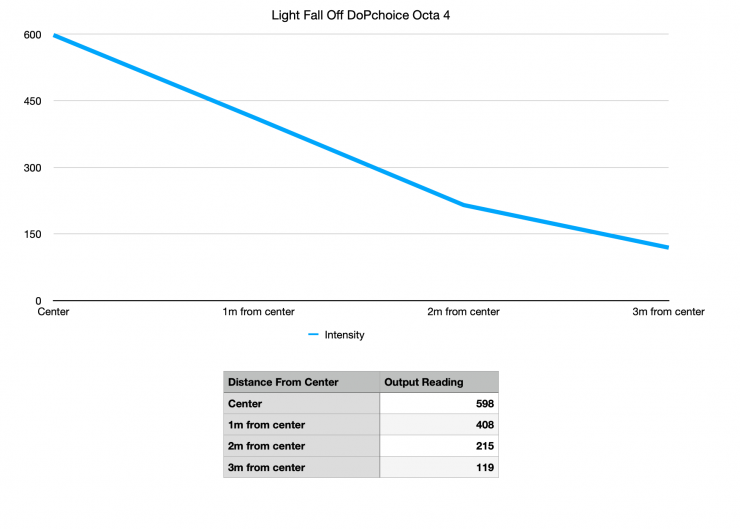
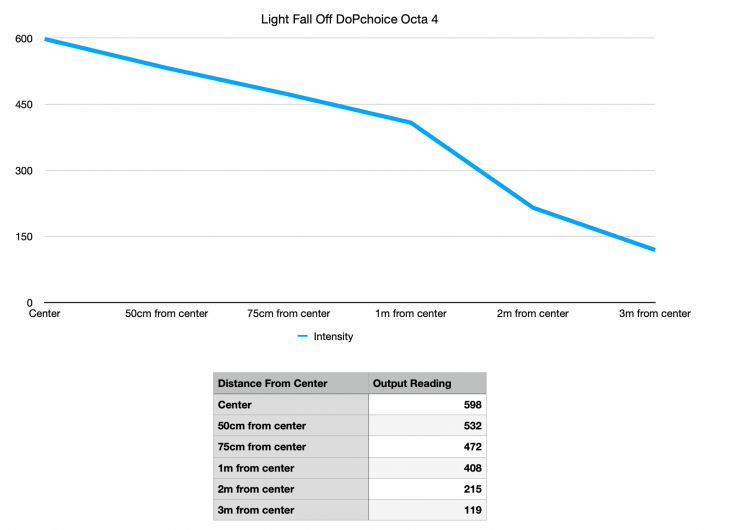
So what is the fall-off like when using the DoPchoice Octa 4 softbox for the Orbiter? The fall-off is very gradual and linear. As you can see from the center to 1m off the center at a distance of 3m you get a very gradual roll-off and a nice even spread of illumination.
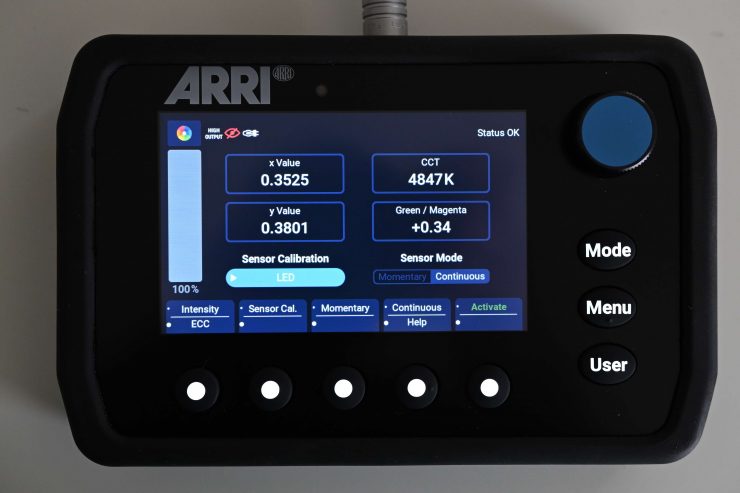
With the ambient light sensor, you can have it set at Momentary or Continuous. In Momentary Mode you can take a measurement and the Orbiter’s sensor will read the lighting conditions and set the light to match that source as closely as it can. In Continuous Mode the Orbiter’s sensor will continually read the ambient lighting conditions and adjust the light accordingly.
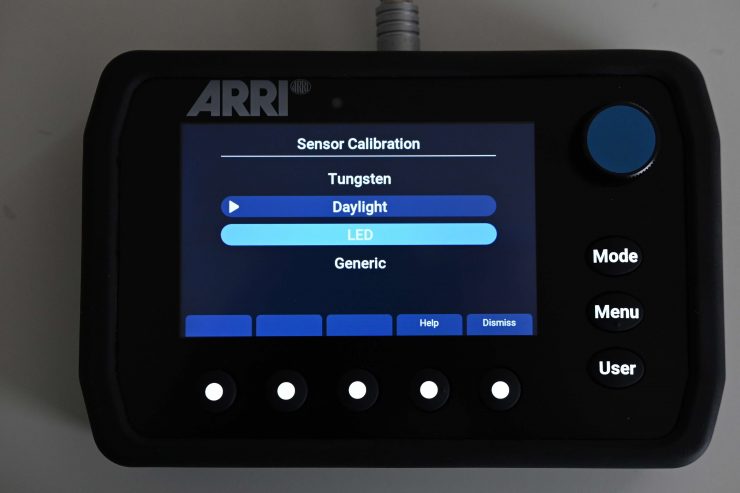
You can choose the sensor calibration depending on what type of light source you want the Orbiter to measure. These are the following choices:
- Tungsten
- Daylight
- LED
- Generic
The ambient sensor measuring is a very interesting and unique concept, and I was keen to see how it actually worked in the real world.
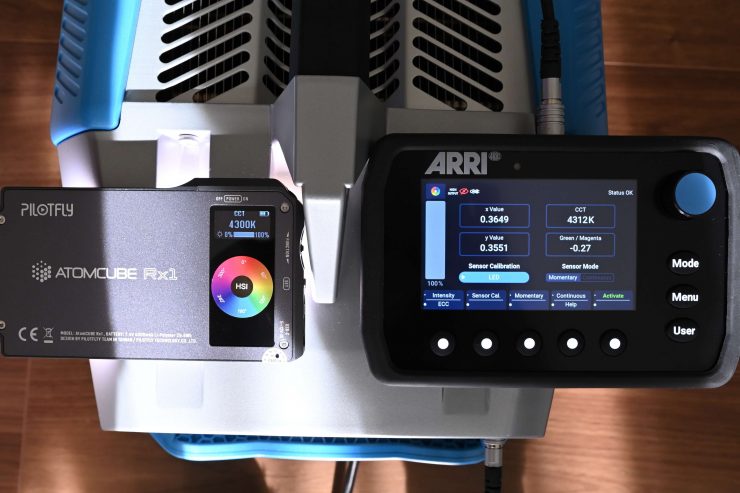
What I found is that the best way to use the Momentary Mode was to put the Orbiter in the Blackout setting and then measure the lighting source you want to try and match. As you can see above I set a light at 4300K and then then measured it with the Orbiter. The Orbiter measured the fixture as 4312K which was exceptionally close.
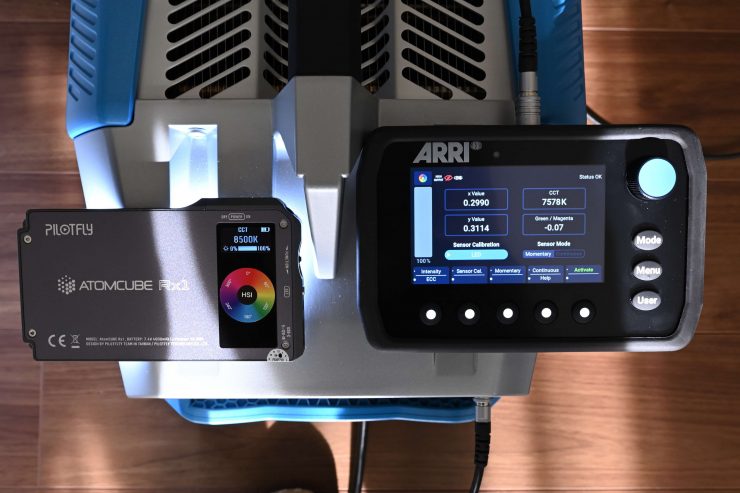
Above you can see two other measurements I did. These measurements don’t appear to be as close as the earlier one that I did. However, what you need to be very aware of is that just because another light is set at a certain Kelvin color temperature, it doesn’t mean that is necessarily the Kelvin color temperature it may be producing.
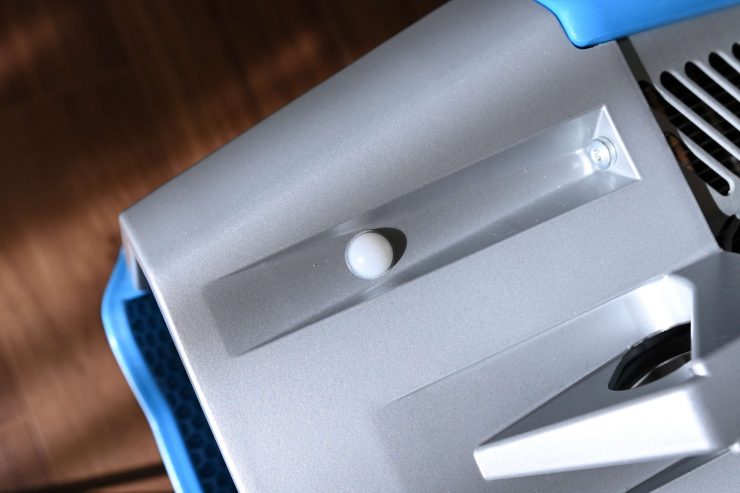
You need to clearly remember is that the ambient light sensor is on top of the Orbiter towards the back. This is where it will measure the ambient lighting. If you want to match it to another fixture it is best to turn that other fixture on and make sure the light is hitting that sensor.
Above you can see two examples showing how the Continuous Mode works. This shows you how the Orbiter is making adjustments in real-time based on what the ambient light sensor is measuring.
This isn’t some type of magical, unicorn solution and it isn’t going to get you an exact perfect match all of the time, but it does do a very good job of getting the Orbiter into the ballpark. This makes matching the Orbiter with other lighting sources you may be using a whole lot easier.
The ability to alter the beam angle using different optics makes it a very versatile fixture. You can use the various optics to directly bounce light into a ceiling, wall, or even a poly board and it can create a nice indirect lighting source. Conversely, you can use a variety of softbox solutions to create a very direct soft source.
While there are a ton of features in the Orbiter, there are bound to be some that users that may never find themselves actually using, but they are nice to have at your disposal.
Who is the Orbiter aimed at and where does it fit in the market?
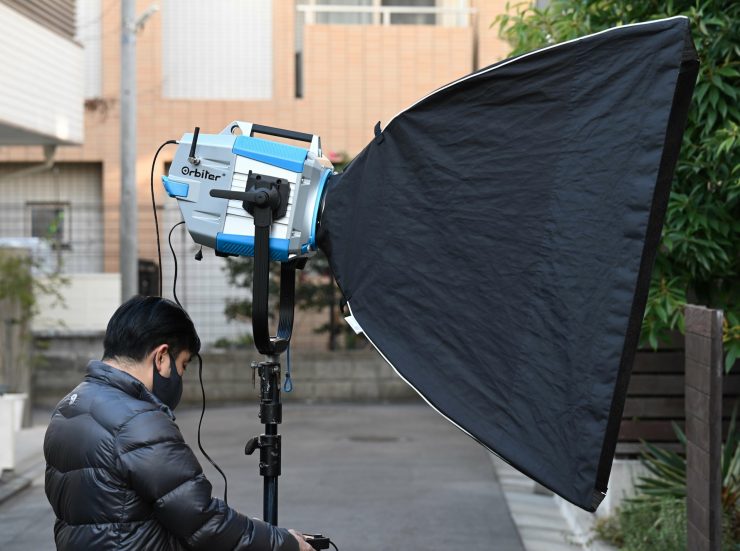
You could use the Orbiter for lots of different applications, but the light is certainly being targeted as a versatile, high output, high-quality lighting fixture for professional use in the TV and film industry.
If you are an owner-operator who is looking for a jack of all trades lighting solution, would the Orbiter be something you should look at? I’m not so sure. Its size, weight, and footprint once you start adding optical attachments doesn’t make it overly suitable for anyone who is traveling a lot. This really is a fixture that is probably going to appeal to rental houses and gaffers more than anyone else. In saying that, there is no reason why certain owner/operators wouldn’t be interested in this fixture.
I kept asking myself where does the Orbiter actually fit in? In some respects, Orbiter is a round peg trying to fit into a square hole. But you know what? I actually like that it is different. While there is no doubt that it does a lot of things well, you could argue that it is a bit of an in-between light. It could also be argued that it is somewhere between a K 5600 Joker2 400 and an 800 when it comes to output. It isn’t the brightest of lights, it isn’t the lightest of lights, but it does offer a lot of features and functionality that other fixtures don’t have. If you already own something like a Joker 800, the Orbiter isn’t going to give you more output.
Whenever something new comes out there are always going to be questions asked such as, “Why do I need that?” and “Does this do anything that can’t already be done with something that I already own?” When the SkyPanel lights first came out a lot of people were asking, why would I need RGB capabilities, I just want good white light. Well, look at what happened. Every lighting company started making RGB panel lights and the technology got adapted very quickly. The SkyPanel was and still is a very popular light that has been universally adopted in the industry. I think we will see the same thing happen with the Orbiter.
Any potential buyer of an Orbiter has to way up the cost, size, weight, and feature set against fixtures they may already own.
Some people are bound to harp on about the output of the light and how it compares to HMI fixtures, but you know what, I don’t think you can compare this light to an HMI. Traditional HMI fixtures are completely different to modern day LED lights and making comparisons between the two can just end up being confusing.
The great aspect of the Orbiter is that it has the ability to be a hard light source, a soft source, a fresnel, a gobo, or just about anything else you want it to be. With its ability to be updated through software and its feature set it is arguably a lot more versatile than a traditional HMI. No one light is going to be the right tool for every job.
Price & Availability
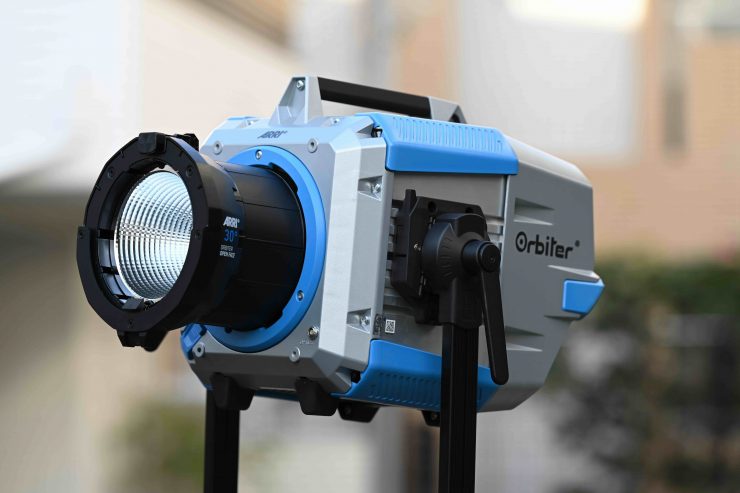
The ARRI Orbiter starts at $5,239.08 USD, but that is for a basic unit without a yolk or even a power cable. Here are the prices of some of the packages that are available:
| Price | |
| ARRI Orbiter Combination Set | $10,140 USD |
| ARRI Orbiter 15° Set | $7,870 USD |
| ARRI Orbiter 30° Set | $7,600 USD |
Below you can see how the price compares to some of the competition:
| Price | |
| ARRI Orbiter* | $5,239.08 USD |
| PROLYCHT Orion 300 | $1,997 USD |
| HIVE LIGHTING Super Hornet 575-C | $5,999 USD |
| Aputure Light Storm LS300X | $1,019 USD |
| Godox VL300 LED Video Light | $499 USD |
| Nanlite Forza 300 LED Monolight | $799.20 USD |
Just to reiterate, the Godox, Nanlight, and Aputure don’t have a lot of the same features as the Orbiter.
*Please be aware that the base price doesn’t include a lot of the items you will need to get a working light.
If you want to see how the price compares to some traditional HMI fixtures you can below:
| Price | |
| ARRI Orbiter Combination Set | $10,140 USD |
| ARRI M8 HMI 2.5/4K Kit with Ballast | $9,240 USD |
| K 5600 Lighting Joker2 800W Kit | $6,783 USD |
| Bron Kobold DW800 HMI Open Face Production Kit | $7,940.94 USD |
| Mole-Richardson 800 Watt HMI DayLite Par Kit | $7,043.50 USD |
| Dedolight Daylight 400DT HMI 400W Spotlight & Dedolight DEB400D electronic ballast | $5,235.38 USD |
Accessory Prices
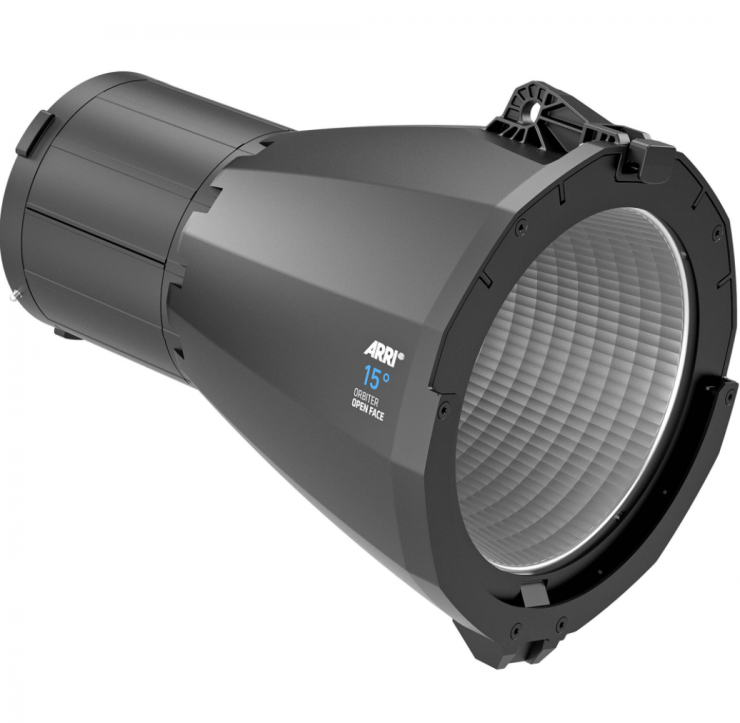
As I have already mentioned in the review, ARRI makes quite a few accessories for the Orion 300.
- ARRI Open Face Optic for Orbiter LED Light (15-Degree) $490 USD
- ARRI Open Face Optic for Orbiter LED Light (30-Degree) $280 USD
- ARRI Open Face Optic for Orbiter LED Light (60-Degree) $210 USD
- ARRI Pole-Operated Yoke with Spigot for Orbiter $360 USD
- ARRI Four Unit Frame for Orbiter $910 USD
- ARRI Six Unit Frame for Orbiter $1,120 USD
- ARRI Skid for Orbiter $100 USD
- ARRI Protective Cap for Orbiter LED Light $70 USD
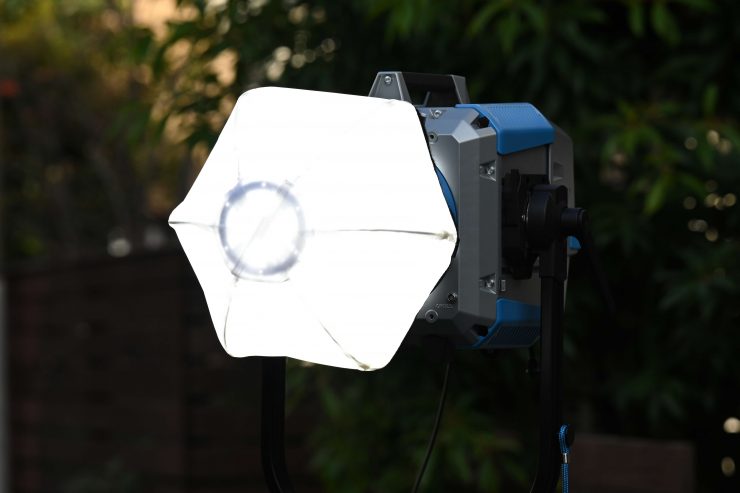
As far as diffusion and softboxes are concerned, both DoPchoice and Chimera make options for the Orbiter:
- ARRI DoPchoice Medium Snapbag for Orbiter $1,050 USD
- ARRI DoPchoice Small Snapbag for Orbiter $980 USD
- ARRI DoPchoice Small Dome for Orbiter, 12″ $980 USD
- ARRI DoPchoice Medium Dome for Orbiter, 20″ $1,050 USD
- ARRI DoPchoice Octa 4 For Orbiter $2,030 USD
- ARRI Chimera Dome M for Orbiter (20″) $750 USD
- ARRI Chimera Dome L for Orbiter (30″) $950 USD
- ARRI Chimera Lightbank S for Orbiter LED Light $700 USD
- ARRI Chimera Lightbank M for Orbiter LED Light $750 USD
- ARRI Chimera Octa 4 for Orbiter LED Light $2,030 USD
Conclusion
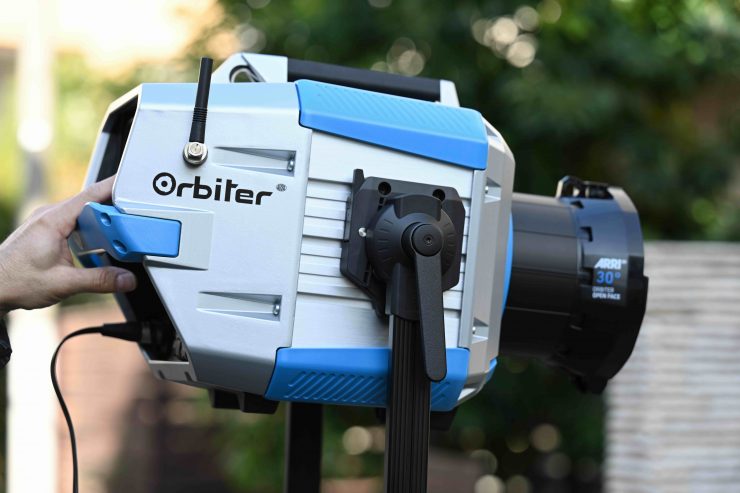
The Orbiter is a very impressive fixture. It is exceptionally color accurate, versatile, built like a tank, and it features a ton of innovation.
The Orbiter also produces a really nice quality of light. A lot of thought has gone into this fixture and it offers features that aren’t found in any other light. The light is remarkably consistent when it comes to Kelvin color accuracy and output across its range. Even when you dim the light way down the Kelvin color temperature remains the same.
The interface and operating system are straight forward and easy to use. ARRI doesn’t make anything overly complicated, despite how advanced this light may be.
The only real downside to the light is probably its physical size and the difficulties some users may face with transporting it. You could also argue that you can buy more affordable lights that have more output.
Yes, the light is expensive, but it is going to be a fixture you could perceivably use for many, many years.
This is not a light for everyone and it is aimed at a specific audience. The same person looking at an Orbiter is not going to be the same person looking at a lower cost COB style light or even some HMI fixtures. In some ways, the Orbiter could be viewed as a light that you could use instead of carrying around both a SkyPanel and an M8. While not a direct replacement or either of those two lights, it does give you a lot of the benefits of both of those fixtures in a single unit. It is this versatility that is likely to appeal to potential buyers.
The Orbiter is an impressive fixture and it does a lot of things really well. ARRI hasn’t compromised on anything and they have come up with a very unique fixture that is different from anything else on the market.
Technical Specifications
Optical System
Changeable optics
Light Aperture
42 mm / 1,66″, without optics
Beam Angle
80° Half Peak Angle, without optics
Weight
Fixture only: 11,7 kg / 25.8 lbs
Manual Version: 14,2 kg / 31.3 lbs
Pole Op Version: 14,9 kg / 32.9 lbs
Handling
Aluminum yoke with quick release, high strength tilt lock, pole operation option (pan and tilt)
Mounting
28 mm Spigot (Junior Pin)
Tilt Angle
+/-90° in dry location, +75° / -90° in wet location with rain cover
Voltage Input Range
100 – 240 V~, 50 – 60 Hz
Power Consumption
400 W Nominal, 500 W Maximum

Mains Power Connection
powerCON TRUE1 TOP
(Bare Ends / Schuko / Edison, Japanese, Chinese cables available)
Battery Connector
3-Pin XLR Connector (Pin 1: negative, Pin 2: positive)
Battery DC Voltage Range
48 – 52 V⎓
White Light
calibrated 2,000 K to 20,000 K continuously variable correlated color temperature
Color Modes
CCT, HSI, individual color, gel selection, x/y coordinates, source matching, lighting effects, and color sensor mode
Color Temperature Tolerance
3,200 to 5,600 K: +/- 100 K (nominal), +/- 1/8 Green-Magenta (nominal)
High Color Rendition
3.200 to 5.600 K:
CRI Average > 98
TLCI Average > 95
TM-30 Average > 94
Green-Magenta Adjustment
Continuously adjustable between Full Minusgreen to Full Plusgreen
Dimming
Smooth, 100 – 0%, continuously, linear / exponential / logarithmic / „S“ curve
Connectivity
Removable Control Panel via PoE, 5-pin XLR in and through, EtherCON in and through, 2 x USB-A, USB-C, SD Card, Camera Sync Input
Control Options
Wireless control via LumenRadio CRMX* (DMX & RDM), Full E1.20 RDM standard implementation with custom & standard RDM commands
* Brand: LumenRadio AB, Equipment: CRMX TiMo, Model: 200-1502, Product: Orbiter 2.4G Wireless Control Module, Frequency Range: 2402 – 2480 MHz, Frequency of Operation: 2402 – 2480 MHz, Power Output: 17.51 dBm, Number of Channels: 79, Channel Spacing: 1 MHz, Modulation Type: GFSK
Housing Color
Blue/silver, Black
Ambient Temperature Operation
-20 to +45º C (-4 to +113º F)
Protection Class
I
IP Rating
IP 20 without Rain Cover, IP24 with Rain Cover L2.0037805
Estimated LED Lifetime (L70)
50,000 hours
Estimated Color Shift Over Lifetime (CCT)
+/- 5 %
Certifications
CB, CE, ENEC, cNRTLus, ICES, FCC, PSE, MIC, KC, SRRC, RCM, IFT, TRA, ETA, ANATEL, ENACOM, NTC
NOTE: This equipment has been tested and found to comply with the limits for a Class B digital device, pursuant to part 15 of the FCC Rules. These limits are designed to provide reasonable protection against harmful interference in a residential installation. This equipment generates, uses and can radiate radio frequency energy and, if not installed and used in accordance with the instructions, may cause harmful interference to radio communications. However, there is no guarantee that interference will not occur in a particular installation. If this equipment does cause harmful interference to radio or television reception, which can be determined by turning the equipment off and on, the user is encouraged to try to correct the interference by one or more of the following measures:
– Reorient or relocate the receiving antenna.
– Increase the separation between the equipment and receiver.
– Connect the equipment into an outlet on a circuit different from that to which the receiver is connected.
– Consult the dealer or an experienced radio/TV technician for help.

